Juno Mission to Jupiter
Non-EO
NASA
Operational (extended)
Quick facts
Overview
| Mission type | Non-EO |
| Agency | NASA |
| Mission status | Operational (extended) |
| Launch date | 05 Aug 2011 |
Juno Mission to Jupiter
Spacecraft Launch Sensor Complement Mission Status References
With the exception of the sun, Jupiter is the most dominant object in the solar system. Because of its enormous size and the fact that it was likely the first of the planets to form, it has profoundly influenced the formation and evolution of the other bodies that orbit our star. NASA's Juno mission will allow us to examine this gas giant planet from its innermost core to the outer reaches of its enormous magnetic force field. 1)
Juno's primary goal is to reveal the story of Jupiter's formation and evolution. Underneath its dense cloud cover, Jupiter safeguards secrets to the fundamental processes and conditions that governed our solar system during its formation. As our primary example of a giant planet, Jupiter can also provide critical knowledge for understanding the planetary systems being discovered around other stars.
Using long-proven technologies on a spinning spacecraft placed in an elliptical polar orbit, Juno will observe Jupiter's gravity and magnetic fields, atmospheric dynamics and composition, and evolution. 2)
Specifically, Juno will ...
• Determine how much water is in Jupiter's atmosphere, which helps determine which planet formation theory is correct (or if new theories are needed)
• Look deep into Jupiter's atmosphere to measure composition, temperature, cloud motions and other properties
• Map Jupiter's magnetic and gravity fields, revealing the planet's deep structure
• Explore and study Jupiter's magnetosphere near the planet's poles, especially the auroras – Jupiter's northern and southern lights – providing new insights about how the planet's enormous magnetic force field affects its atmosphere.
As the largest planet orbiting the Sun, Jupiter has had a profound influence on the solar system. But its origin remains a profound mystery. To learn how Jupiter formed and how it has evolved, Juno is studying the gas giant's gravitational and magnetic fields, vast magnetosphere, intense aurora, and exploring the swirling clouds that form Jupiter's colorful, trademark atmosphere. The spacecraft will also reveal what Jupiter is made of – and how much of it is water.
Theories about the solar system formation all begin with the collapse of a giant cloud of gas and dust, or nebula, most of which formed the infant sun. Like the sun, Jupiter is mostly hydrogen and helium, so it must have formed early, capturing most of the material left after our star came to be. How this happened, however, is unclear. Did a massive planetary core form first and gravitationally capture all that gas, or did an unstable region collapse inside the nebula, triggering the planet's formation? Differences between these scenarios are profound.
Even more importantly, the composition and role of icy planetesimals, or small proto-planets, in planetary formation hangs in the balance – and with them, the origin of Earth and other terrestrial planets. Icy planetesimals likely were the carriers of materials like water and carbon compounds that are the fundamental building blocks of life.
Unlike Earth, Jupiter's giant mass allowed it to hold onto its original composition, providing us with a way of tracing our solar system's history. Juno will measure the amount of water and ammonia in Jupiter's atmosphere and determine if the planet actually has a solid core, directly resolving the origin of this giant planet and thereby the solar system. By mapping Jupiter's gravitational and magnetic fields, Juno will reveal the planet's interior structure and measure the mass of the core.
Atmosphere
How deep Jupiter's colorful zones, belts, and other features penetrate is one of the most outstanding fundamental questions about the giant planet. Juno will determine the global structure and motions of the planet's atmosphere below the cloud tops for the first time, mapping variations in the atmosphere's composition, temperature, clouds and patterns of movement down to unprecedented depths.
Magnetosphere
Deep in Jupiter's atmosphere, under great pressure, hydrogen gas is squeezed into a fluid known as metallic hydrogen. At these great depths, the hydrogen acts like an electrically conducting metal which is believed to be the source of the planet's intense magnetic field. This powerful magnetic environment creates the brightest auroras in our solar system, as charged particles precipitate down into the planet's atmosphere. Juno will directly sample the charged particles and magnetic fields near Jupiter's poles for the first time, while simultaneously observing the auroras in UV light produced by the extraordinary amounts of energy crashing into the polar regions. These investigations will greatly improve our understanding of this remarkable phenomenon, and also of similar magnetic objects, like young stars with their own planetary systems.
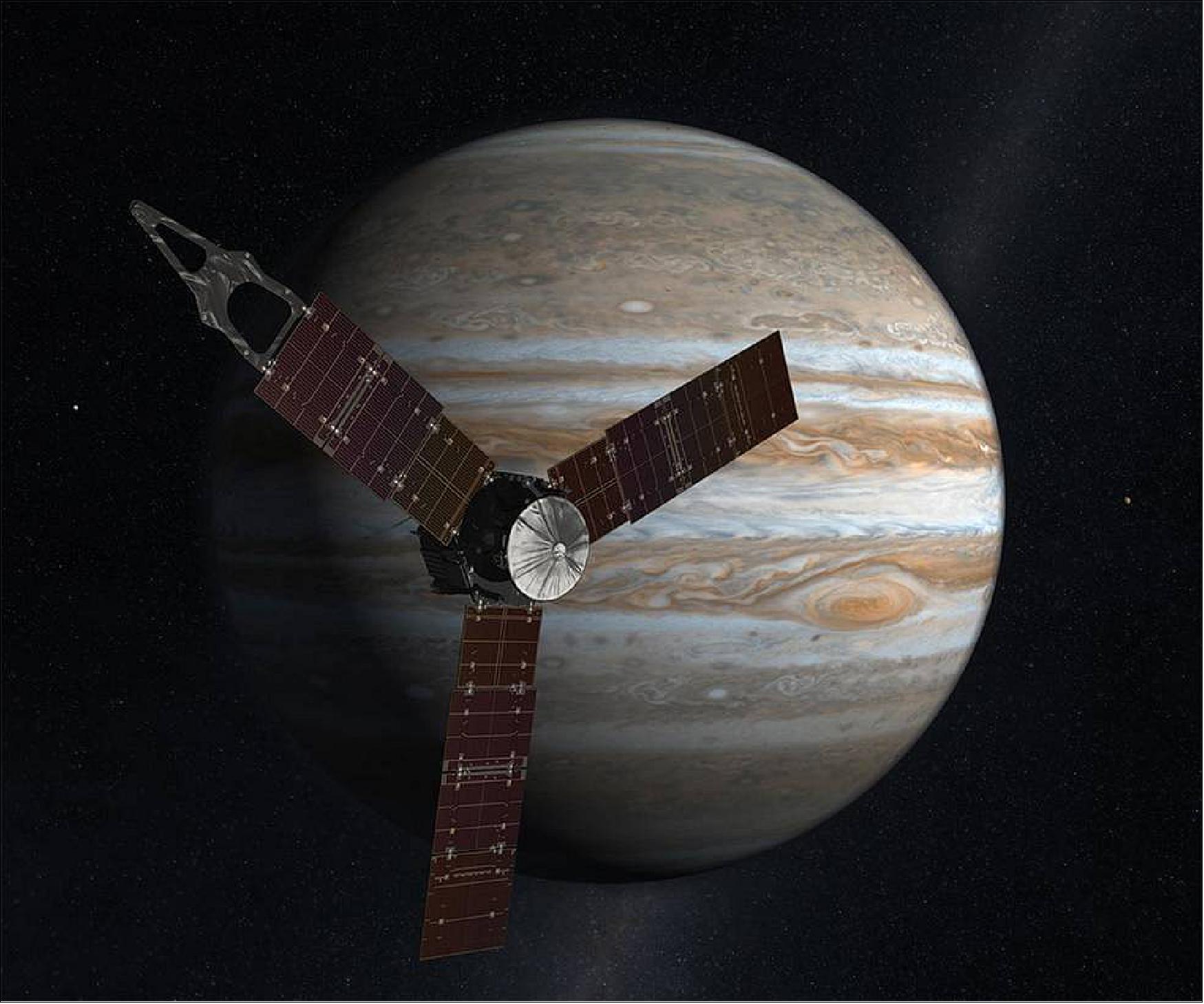
The Juno mission is the second spacecraft designed under NASA's New Frontiers Program. The first is the Pluto New Horizons mission, which flew by the dwarf planet in July 2015 after a nine-and-a-half-year flight. The program provides opportunities to carry out several medium-class missions identified as top priority objectives in the Decadal Solar System Exploration Survey, conducted by the Space Studies Board of the National Research Council in Washington.
JPL manages the Juno mission for the principal investigator, Scott Bolton, of SwRI (Southwest Research Institute) in San Antonio, Texas. The Juno mission is part of the New Frontiers Program managed at NASA's Marshall Space Flight Center in Huntsville, Ala. Lockheed Martin Space Systems, Denver, built the spacecraft. Launch management for the mission is the responsibility of NASA's Launch Services Program at the Kennedy Space Center in Florida. JPL is a division of the California Institute of Technology in Pasadena.
Spacecraft
Juno was carefully designed to meet the tough challenges in flying a mission to Jupiter: weak sunlight, extreme temperatures and deadly radiation. The spacecraft is covered in thermal blankets to protect it from the extreme environment of space. All of the most-sensitive electronics are placed inside an armored vault to shield them from Jupiter's deadly radiation. 3)
Rotating Spacecraft: For Juno, like NASA's earlier Pioneer spacecraft, spinning makes the spacecraft's pointing extremely stable and easy to control. Just after launch, and before its solar arrays are deployed, Juno will be spun-up by rocket motors on its still attached second-stage rocket booster. While in orbit at Jupiter, the spinning spacecraft sweeps the fields of view of its instruments through space once for each rotation. At three rotations per minute, the instruments' fields of view sweep across Jupiter about 400 times in the two hours it takes to fly from pole to pole.
Structure: The spacecraft's main body measures 3.5 meters tall and 3.5 meters in diameter. The spacecraft's hexagonal two-deck structure uses composite panel and clip construction for decks, central cylinder and gusset panels. Polar mounted off-center spherical tanks provide spinning spacecraft designs with high stability.
Propulsion System: For weight savings and redundancy, Juno uses a dual-mode propulsion subsystem, with a bi-propellant main engine and mono-propellant reaction control system thrusters. — The Leros-1b main engine is a 645-Newton bi-propellant thruster using hydrazine–nitrogen tetroxide. Its engine bell is enclosed in a micrometeoroid shield that opens for engine burns. The engine is fixed to the spacecraft body firing aft and is used for major maneuvers and flushing burns.
The 12 reaction control system thrusters are mounted on four rocket engine modules. They allow translation and rotation about three axes. They are also used for most trajectory correction maneuvers
Command and Data Handling: Command and data handling includes a RAD750 flight processor with 256 MB of flash memory and 128 MB of DRAM local memory. It provides 100 Mbit/s total instrument throughput, more than enough for payload requirements.
Electronics Vault: Juno will avoid Jupiter's highest radiation regions by approaching over the north, dropping to an altitude below the planet's radiation belts – which are analogous to Earth's Van Allen belts, but far more deadly – and then exiting over the south. To protect sensitive spacecraft electronics, Juno will carry the first radiation shielded electronics vault, a critical feature for enabling sustained exploration in such a heavy radiation environment. This feature of the mission is relevant to NASA's Vision for Space Exploration, which addresses the need for protection against harsh radiation in space environments beyond the safety of low-Earth orbit. — This titanium box — about the size of an SUV's trunk — encloses Juno's command and data handling box (the spacecraft's brain), power and data distribution unit (its heart) and about 20 other electronic assemblies. The whole vault has a mass of ~200 kg.
Solar Power: Jupiter's orbit is five times farther from the Sun than Earth's, so the giant planet receives 25 times less sunlight than Earth. Juno will be the first solar-powered spacecraft designed by NASA to operate at such a great distance from the sun, thus the surface area of solar panels required to generate adequate power is quite large. Three solar panels extend outward from Juno's hexagonal body, giving the overall spacecraft a span of about 20 meters. The solar panels will remain in sunlight continuously from launch through end of mission, except for a few minutes during the Earth flyby. Before launch, the solar panels will be folded into four-hinged segments so that the spacecraft can fit into the launch vehicle.
Juno benefits from advances in solar cell design with modern cells that are 50 percent more efficient and radiation tolerant than silicon cells available for space missions 20 years ago. The mission's power needs are modest, with science instruments requiring full power for only about six hours out of each 14-day orbit (during the period near closest approach to the planet). With a mission design that avoids any eclipses by Jupiter, minimizes damaging radiation exposure and allows all science measurements to be taken with the solar panels facing the sun, solar power is a perfect fit for Juno.
Power: Juno's Electrical Power Subsystem manages the space-craft power bus and distribution of power to payloads, propulsion, heaters and avionics. The power distribution and drive unit monitors and manages the spacecraft power bus, manages the available solar array power to meet the spacecraft load and battery state of charge, and provides controlled power distribution.
Power generation is provided by three solar arrays consisting of 11 solar panels and one MAG boom. Two 55 amp-hour lithium-ion batteries provide power when Juno is off-sun or in eclipse, and are tolerant of the Jupiter radiation environment. The power modes during science orbits are sized for either data collection during an orbit emphasizing microwave radiometry or gravity science.
Thermal Control: Juno's thermal control subsystem uses a passive design with heaters and louvers. The main component of the thermal control subsystem consists of an insulated, louvered electronics vault atop an insulated, heated propulsion module. This design accommodates all mission thermal environments from Earth orbit to Jupiter orbital operations. During cruise, while the spacecraft is close to the sun, the high-gain antenna is used as a heat shield to protect the vault avionics.
Most instrument electronics are contained within the radiation vault and are thermally managed as part of the vault thermal control system. Science sensors are externally mounted to the deck and are individually blanketed and heated to maintain individual temperature limits.
Telecommunications: The gravity science and telecom subsystem provides X-band command uplink and engineering telemetry and science data downlink for the entire post-launch, cruise and Jupiter orbital operations. The subsystem also provides for dual-band (X- and Ka-band) Doppler tracking for gravity science at Jupiter.
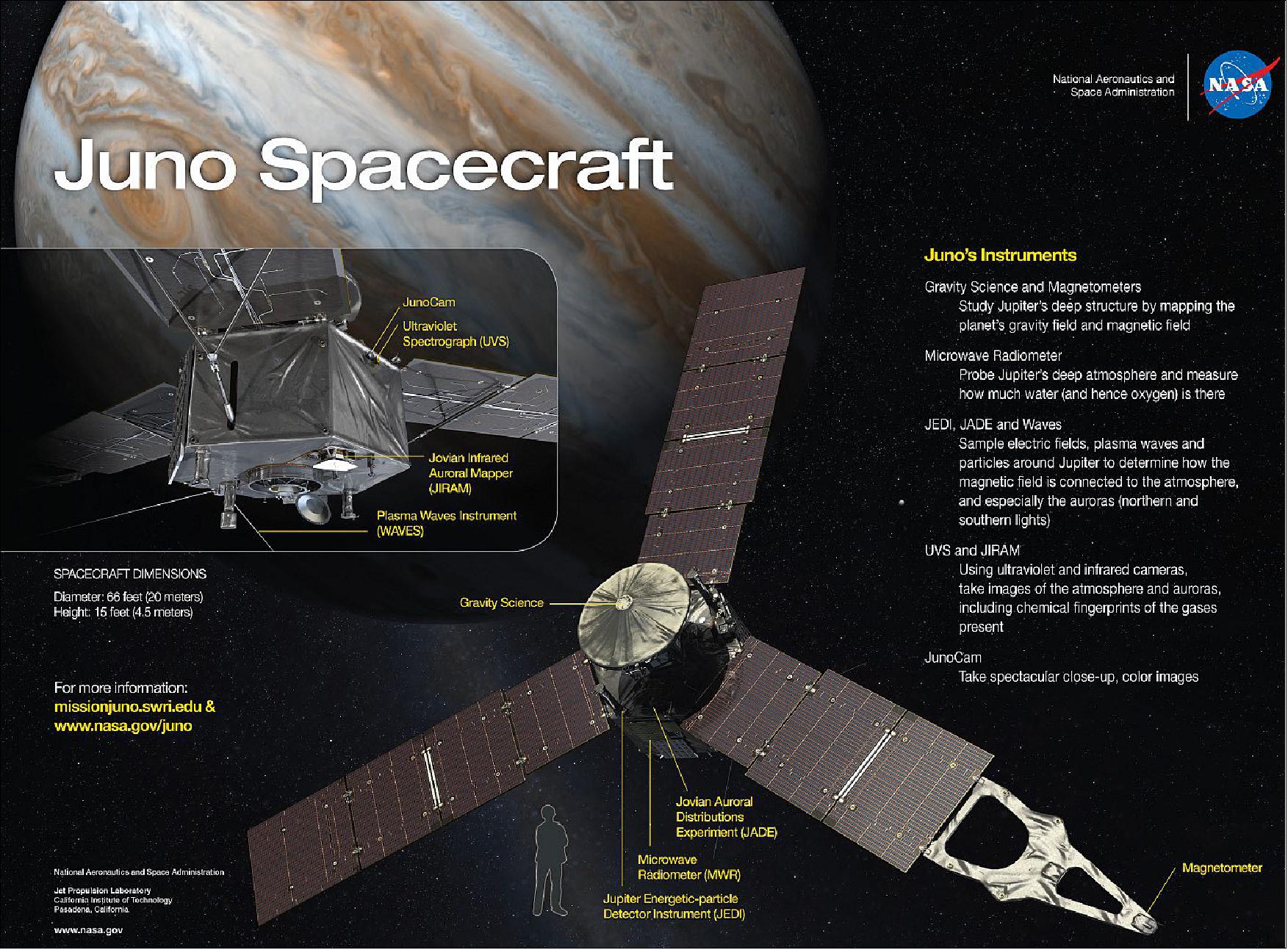
Launch
The Juno spacecraft launched aboard an Atlas V-551 rocket from Cape Canaveral, Fla., on 5 August 2011, and will reach Jupiter in July 2016. The spacecraft will orbit Jupiter 32 times, skimming to within 5,000 km above the planet's cloud tops, for approximately one year. 4)
The Juno spacecraft had a total launch mass of 3625 kg, consisting of 1593 kg of spacecraft, 1280 kg of fuel and 752 kg of oxidizer.
Following launch from Cape Canaveral Air Force Station, Fla., the Juno spacecraft is scheduled to use its main rocket motor twice (for an Aug. 5 launch, it would be used on Aug. 30, and Sept. 3, 2012) to modify its trajectory towards Jupiter. During cruise, there are also 13 planned trajectory correction maneuvers to refine its orbital path. An Earth flyby 26 months after launch will provide a boost of spacecraft velocity, placing it on a trajectory for Jupiter. The transit time to Jupiter following the Earth flyby is about three years, including the period of the initial capture orbit. The 30-minute orbit insertion burn will place Juno in orbit around Jupiter in early July 2016.
To accomplish its science objectives, Juno orbits over Jupiter's poles and passes very close to the planet. Juno needs to get extremely close to Jupiter to make the very precise measurements the mission is after. This orbital path carries the spacecraft repeatedly through hazardous radiation belts — but avoids the most power-ful radiation belts. Jupiter's radiation belts are analogous to Earth's Van Allen belts — but far more deadly.
The spacecraft will orbit Jupiter 33 times, skimming to within 5,000 km above the planet's cloud tops every 11 days, for approximately one year.
Juno's Sensor Complement
The Juno spacecraft carries a payload of 29 sensors, which feed data to nine onboard instruments. Eight of these instruments (MAG, MWR, Gravity Science, Waves, JEDI, JADE, UVS, JIRAM) are considered the science payload. One instrument, JunoCam, is aboard to generate images for education and public outreach.
• A gravity/radio science system (Gravity Science)
• A six-wavelength microwave radiometer for atmospheric sounding and composition (MWR)
• A vector magnetometer (MAG)
• Plasma and energetic particle detectors (JADE and JEDI)
• A radio/plasma wave experiment (Waves)
• An ultraviolet imager/spectrometer (UVS)
• An infrared imager/spectrometer (JIRAM)
Primary science observations are obtained within three hours of closest approach to Jupiter, although calibrations, occasional remote sensing and magnetospheric science observations are planned throughout the science orbits around Jupiter.
Juno is spin-stabilized. Because of the spacecraft mission design and the fact that its science instruments were all developed together, and there is no need for a scan platform to point instruments in different directions. Gravity science and microwave sounding of the atmosphere observations are obtained through orientation of the spacecraft's spin plane. All other experiments utilize ride-along pointing and work in either one or both orientations. This design allows for very simple operations.
Gravity Science
The objective of the Gravity Science experiment is to enable Juno to measure Jupiter's gravitational field and reveal the planet's internal structure.
Two transponders operating on different frequencies (Ka- and X-band) will detect signals sent from NASA's DSN (Deep Space Network) on Earth and immediately send signals in return. Small changes in the signal's frequencies (as they are received on Earth) provide data on how much Juno's velocity has been modified due to local variations in Jupiter's gravity. These subtle shifts in Juno's velocity reveal the gas giant's gravity (and how the planet is arranged on the inside), and provide insight into the gas giant's internal structure. - ASI (Agenzia Spaziale Italiana) in Rome, Italy contributed the Ka-band translator system.
MAG (Magnetometer)
Juno's Magnetometer instrument is a flux gate type magnetometer, which measures the strength and direction of Jupiter's magnetic field lines. An Advanced Stellar Compass images stars to provide information on the exact orientation of the magnetometer sensors. This enables Juno's very precise magnetic field measurement. Magnetometer sensors are mounted on the magnetometer boom at the end of one of Juno's three solar arrays — as far away from the spacecraft body as possible. This was done to avoid the instruments from confusing the spacecraft magnetic field with Jupiter's. The boom is designed to mimic the outermost solar array panel (of the remaining two solar array structures) in mass and mechanical deployment.
The spacecraft magnetic field is further separated from Jupiter's field by the use of two magnetometer sensors one 10 meters from the center of the spacecraft and one 12 meters from the center. By comparing measurements from both sensors, scientists can isolate the magnetic field of Juno from Jupiter. The Flux Gate Magnetometer was designed and built by NASA's Goddard Space Flight Center Greenbelt, Md., and the Advanced Stellar Compass was designed and built by the Danish Technical University in Lyngby, Denmark.
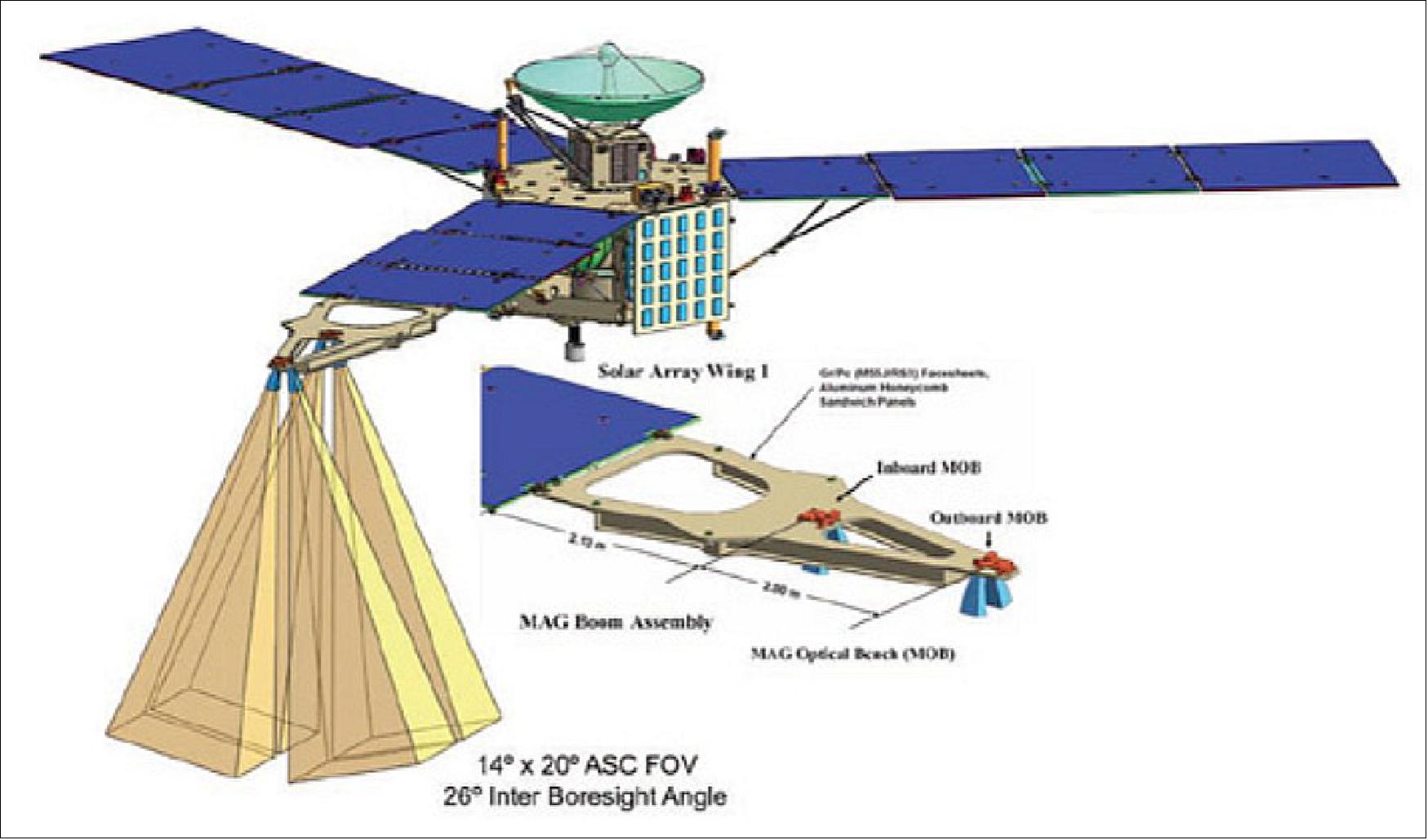
MWR (Microwave Radiometer)
The objective of MWR is to probe beneath Jupiter's cloud tops to provide data on the structure, movement and chemical composition to a depth as great as 1,000 atmospheres — about 550 km below the visible cloud tops.
MWR consists of six radiometers designed to measure the microwaves coming from six cloud levels. Each of the six radiometers has an antenna extending from Juno's hexagonal body. Each antenna is connected by a cable to a receiver, which sits in the instrument vault on top of the spacecraft. NASA's Jet Propulsion Laboratory in Pasadena, Calif. provided the Microwave Radiometer subsystem components, including the antennas and receivers.
JEDI (Jupiter Energetic Particle Detector Instrument)
The objective of JEDI is to measure the energetic particles that stream through space and study how they interact with Jupiter's magnetic field.
JEDI comprises three identical sensor units each with 6 ion and 6 electron views. The instrument works in coordination with the JADE and Waves instruments to investigate Jupiter's polar space environment, with a particular focus on the physics of Jupiter's intense and impressive northern and southern auroral lights. The instrument was designed and built by the Johns Hopkins University's Applied Physics Laboratory, Laurel, Md.
JADE (Jovian Auroral Distributions Experiment)
JADE will work with some of Juno's other instruments to identify the particles and processes that produce Jupiter's stunning auroras.
JADE consists of an electronics box shared by four sensors: three will detect the electrons that surround the spacecraft ,and the fourth will identify positively charged hydrogen, helium, oxygen and sulfur ions. When Juno flies directly over auroras, the instrument will be able to characterize the particles that are coming down Jupiter's magnetic field lines and crashing into Jupiter's atmosphere. JADE was de-signed and built by SwRI (Southwest Research Institute) in San Antonio, Texas.
WAVES
The Waves instrument will measure radio and plasma waves in Jupiter's magnetosphere, helping us understand the interactions between the magnetic field, the atmosphere and the magnetosphere.
The Waves instrument consists of a V-shaped antenna that is about 4 meters from tip to tip, similar to the rabbit-ear antennas that were once common on TVs. One of the ears of the Waves instrument detects the electric component of radio and plasma waves, while the other is sensitive to the magnetic component. The magnetic antenna — called a magnetic search coil — consists of a coil of fine wire wrapped 10,000 times around a 15 cm long core. The search coil measures magnetic fluctuations in the audio frequency range.
The Waves instrument was designed and built by the University of Iowa in Iowa City.
UVS (Ultraviolet Imaging Spectrograph)
The objective of UVS is to take pictures of Jupiter's auroras in ultraviolet light. Working with Juno's JADE and JEDI instruments, which measure the particles that create the auroras, UVS will help us understand the relationship between the auroras, the streaming particles that create them and the magnetosphere as a whole.
The UVS instrument consists of two separate sections: a dedicated telescope/spectrograph assembly and a vault electronics box. The telescope/spectrograph assembly contains a telescope which focuses collected light into a spectrograph. The instrument's electronics box is located in Juno's radiation-shielded spacecraft vault.
The UVS instrument was designed and built by SwRI (Southwest Research Institute) in San Antonio, Texas.
JIRAM (Jovian Infrared Auroral Mapper)
JIRAM will study Jupiter's atmosphere in and around the auroras, helping us learn more about the interactions between the auroras, the magnetic field and the magnetosphere. JIRAM will be able to probe the atmosphere down to 50 to 70 km below the cloud tops, where the pressure is five to seven times greater than on Earth at sea level.
The JIRAM instrument consists of a camera and a spectrometer, which splits light into its component wavelengths, like a prism. The camera will take pictures in infrared light, which is heat radiation, with wavelengths of two to five µm (millionths of a meter) — three to seven times longer than visible wavelengths.
The JIRAM instrument was designed and built by the Italian National Institute for Astrophysics, Milano, Italy, and funded by ASI (Agenzia Spaziale Italiana) in Rome.
JunoCam
The objective of JunoCam is to capture color pictures of Jupiter's cloud tops in visible light. JunoCam will provide a wide-angle view of Jupiter's atmosphere and poles. JunoCam is designed as an outreach full-color camera to engage the public. The public will be involved in developing the images from raw data and even helping to design which areas of Jupiter should be imaged.
The JunoCam camera head has a lens with a 58º cross-scan field of view. It acquires images by sweeping out that field while the spacecraft spins to cover an along-scan field of view of 360º. Lines containing dark sky are subsequently compressed to an insignificant data volume. It takes images mainly when Juno is very close to Jupiter, with a maximum resolution of up to 2 to 3 km per pixel. The wide-angle camera will provide new views of Jupiter's atmosphere.
JunoCam's hardware is based on a descent camera that was developed for NASA's Mars Science Laboratory rover. Some of its software was originally developed for NASA's Mars Odyssey and Mars Reconnaissance Orbiter spacecraft. JunoCam is provided by Malin Space Science Systems, San Diego. Calif.
Jupiter's Moons
Jupiter has 53 named moons. Others are awaiting official names. Combined, scientists now think Jupiter has 79 moons. There are many interesting moons orbiting the planet, but the ones of most scientific interest are the first four moons discovered beyond Earth—the Galilean satellites.
• Io: Io is the most volcanically active body in the solar system. Io's surface is covered by sulfur in different colorful forms. As Io travels in its slightly elliptical orbit, Jupiter's immense gravity causes "tides" in the solid surface that rise 100 meters high on Io, generating enough heat for volcanic activity and to drive off any water. Io's volcanoes are driven by hot silicate magma.
• Europa: Europa's surface is mostly water ice, and there is evidence that it may be covering an ocean of water or slushy ice beneath. Europa is thought to have twice as much water as does Earth. This moon intrigues astrobiologists because of its potential for having a "habitable zone." Life forms have been found thriving near subterranean volcanoes on Earth and in other extreme locations that may be analogues to what may exist on Europa.
• Ganymede: Ganymede is the largest moon in the solar system (larger than the planet Mercury), and is the only moon known to have its own internally generated magnetic field.
• Callisto: Callisto's surface is extremely heavily cratered and ancient—a visible record of events from the early history of the solar system. However, the very few small craters on Callisto indicate a small degree of current surface activity.
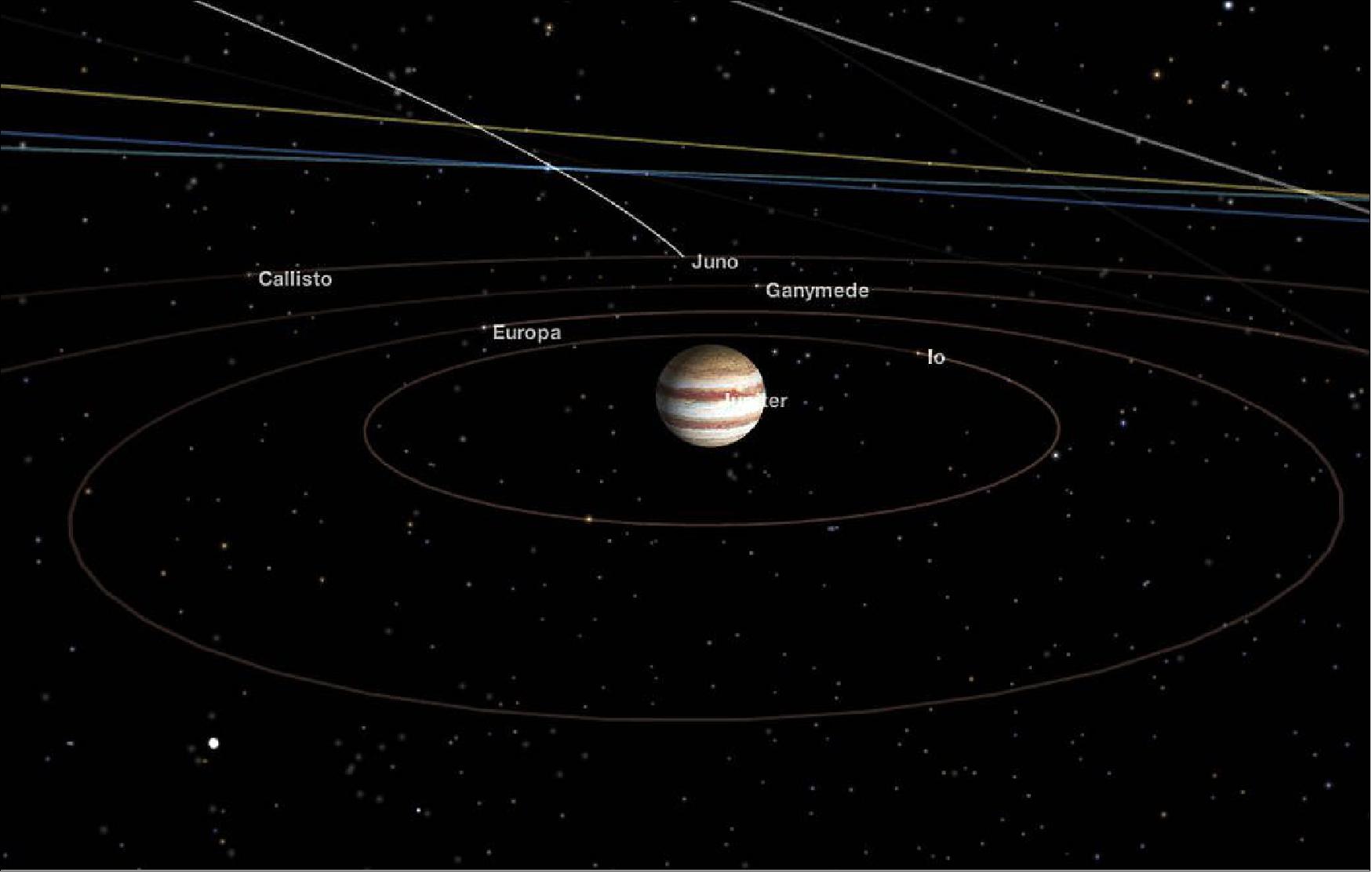
Juno Mission Status
Note: At this stage of the mission (August 2021), no attempt is being made to recover all facets of the Juno mission regarding the spacecraft, instrumentation and the past history (it would have required a constant accompaniment of the mission with all updates over its lifetime). Instead, some fairly recent events of the mission and the operational status of the mission are presented in reversed order. Most of the various events are taken from the reference of the NASA Juno News Archive (in reverse order) at https://web.archive.org/web/20230316041015/https://www.nasa.gov/mission_pages/juno/news/juno-latest-news-archive.html 5)
• December 17, 2021: An audio track collected during Jupiter mission's Ganymede flyby offers a dramatic ride-along. It is one of the highlights mission scientists shared in a briefing at American Geophysical Union Fall Meeting. 6)
- Sounds from a Ganymede flyby, magnetic fields, and remarkable comparisons between Jupiter and Earth's oceans and atmospheres were discussed during a briefing today on NASA's Juno mission to Jupiter at the American Geophysical Union Fall Meeting in New Orleans.
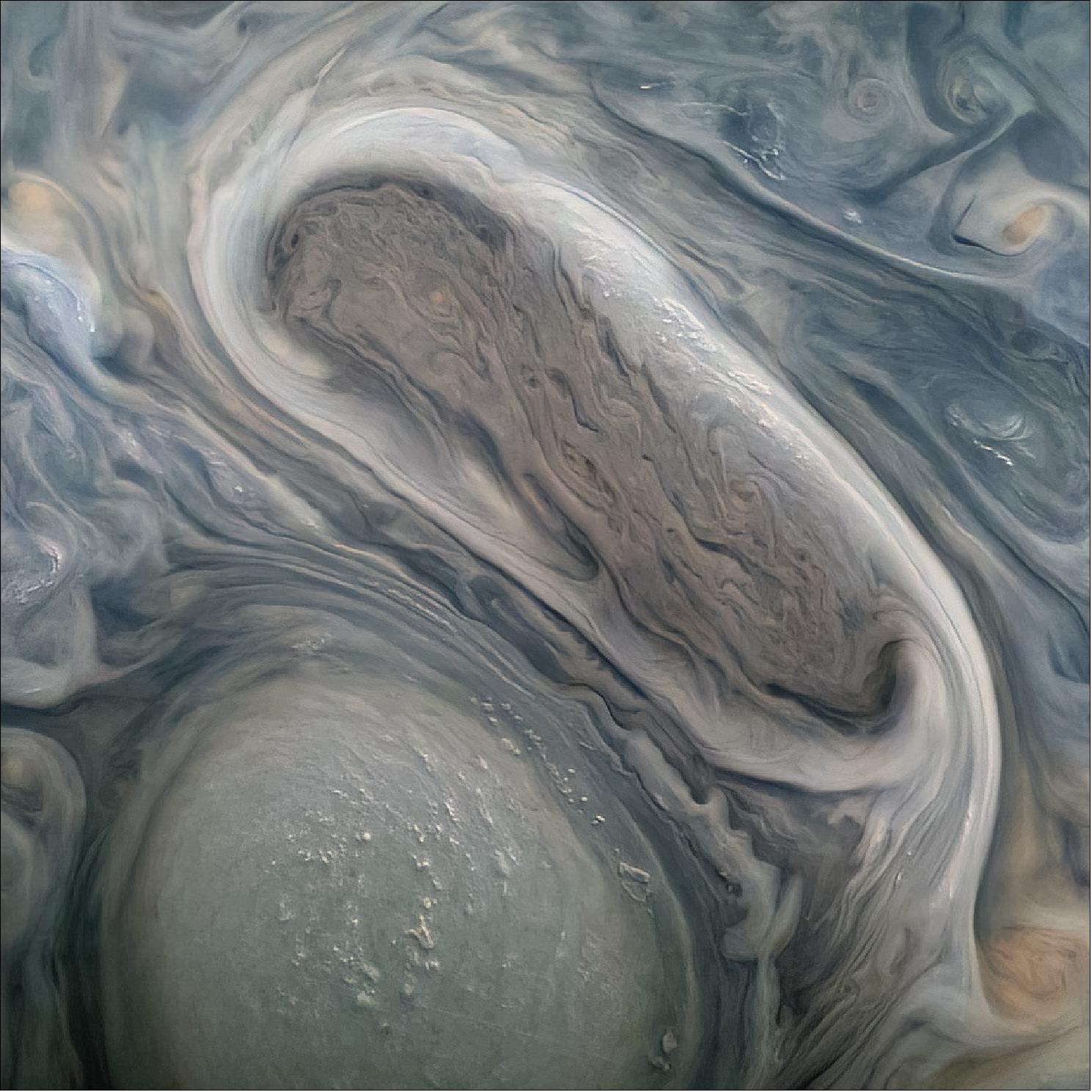
- Juno Principal Investigator Scott Bolton of the Southwest Research Institute in San Antonio has debuted a 50-second audio track generated from data collected during the mission's close flyby of the Jovian moon Ganymede on June 7, 2021. Juno's Waves instrument, which tunes in to electric and magnetic radio waves produced in Jupiter's magnetosphere, collected the data on those emissions. Their frequency was then shifted into the audio range to make the audio track.
- "This soundtrack is just wild enough to make you feel as if you were riding along as Juno sails past Ganymede for the first time in more than two decades," said Bolton. "If you listen closely, you can hear the abrupt change to higher frequencies around the midpoint of the recording, which represents entry into a different region in Ganymede's magnetosphere."
- Detailed analysis and modeling of the Waves data are ongoing. "It is possible the change in the frequency shortly after closest approach is due to passing from the nightside to the dayside of Ganymede," said William Kurth of the University of Iowa in Iowa City, lead co-investigator for the Waves investigation.
- At the time of Juno's closest approach to Ganymede – during the mission's 34th trip around Jupiter – the spacecraft was within 645 miles (1,038 km) of the moon's surface and traveling at a relative velocity of 41,600 mph (67,000 km/h).
Magnetic Jupiter
- Jack Connerney from NASA's Goddard Space Flight Center in Greenbelt, Maryland, is the lead investigator with Juno's magnetometer and is the mission's deputy principal investigator. His team has produced the most detailed map ever obtained of Jupiter's magnetic field.
- Compiled from data collected from 32 orbits during Juno's prime mission, the map provides new insights into the gas giant's mysterious Great Blue Spot, a magnetic anomaly at the planet's equator. Juno data indicates that a change in the gas giant's magnetic field has occurred during the spacecraft's five years in orbit, and that the Great Blue Spot is drifting eastward at a speed of about 2 inches (4 cm) per second relative to the rest of Jupiter's interior, lapping the planet in about 350 years.
- In contrast, the Great Red Spot – the long-lived atmospheric anticyclone just south of Jupiter's equator – is drifting westward at a relatively rapid clip, circling the planet in about four-and-a-half years.
- In addition, the new map shows that Jupiter's zonal winds (jet streams that run east to west and west to east, giving Jupiter's its distinctive banded appearance) are pulling the Great Blue Spot apart. This means that the zonal winds measured on the surface of the planet reach deep into the planet's interior.
- The new magnetic field map also allows Juno scientists to make comparisons with Earth's magnetic field. The data suggests to the team that dynamo action – the mechanism by which a celestial body generates a magnetic field – in Jupiter's interior occurs in metallic hydrogen, beneath a layer expressing "helium rain."
- Data Juno collects during its extended mission may further unravel the mysteries of the dynamo effect not only at Jupiter but those of other planets, including Earth.
Earth's Oceans, Jupiter's Atmosphere
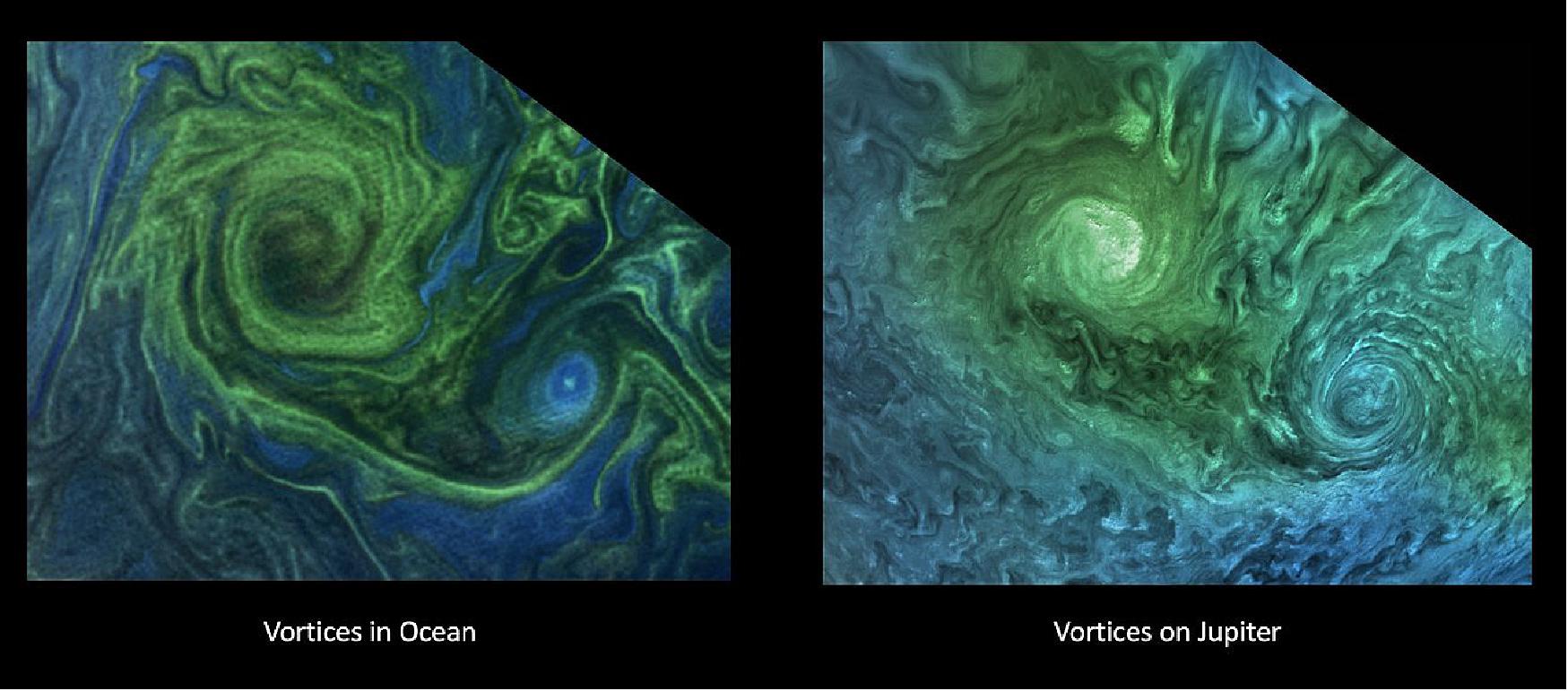
- Lia Siegelman, a physical oceanographer and postdoctoral fellow at Scripps Institution of Oceanography at the University of California, San Diego, decided to study the dynamics of Jupiter's atmosphere after noticing that the cyclones at Jupiter's pole appear to share similarities with ocean vortices she studied during her time as a doctoral student.
- "When I saw the richness of the turbulence around the Jovian cyclones, with all the filaments and smaller eddies, it reminded me of the turbulence you see in the ocean around eddies," said Siegelman. "These are especially evident in high-resolution satellite images of vortices in Earth's oceans that are revealed by plankton blooms that act as tracers of the flow."
- The simplified model of Jupiter's pole shows that geometric patterns of vortices, like those observed on Jupiter, spontaneously emerge, and survive forever. This means that the basic geometrical configuration of the planet allows these intriguing structures to form.
- Although Jupiter's energy system is on a scale much larger than Earth's, understanding the dynamics of the Jovian atmosphere could help us understand the physical mechanisms at play on our own planet.
Arming Perseus
- The Juno team has also released its latest image of Jupiter's faint dust ring, taken from inside the ring looking out by the spacecraft's Stellar Reference Unit navigation camera. The brightest of the thin bands and neighboring dark regions scene in the image are linked to dust generated by two of Jupiter's small moons, Metis and Adrastea. The image also captures the arm of the constellation Perseus.
- "It is breathtaking that we can gaze at these familiar constellations from a spacecraft a half-billion miles away," said Heidi Becker, lead co-investigator of Juno's Stellar Reference Unit instrument at NASA's Jet Propulsion Laboratory in Pasadena. "But everything looks pretty much the same as when we appreciate them from our backyards here on Earth. It's an awe-inspiring reminder of how small we are and how much there is left to explore."
More About the Mission
- JPL, a division of Caltech in Pasadena, California, manages the Juno mission for the principal investigator, Scott J. Bolton, of the Southwest Research Institute in San Antonio. Juno is part of NASA's New Frontiers Program, which is managed at NASA's Marshall Space Flight Center in Huntsville, Alabama, for the agency's Science Mission Directorate in Washington. Lockheed Martin Space in Denver built and operates the spacecraft.
• October 28, 2021: New findings from NASA's Juno probe orbiting Jupiter provide a fuller picture of how the planet's distinctive and colorful atmospheric features offer clues about the unseen processes below its clouds. The results highlight the inner workings of the belts and zones of clouds encircling Jupiter, as well as its polar cyclones and even the Great Red Spot. 7)

- Researchers published several papers on Juno's atmospheric discoveries today in the journal Science and the Journal of Geophysical Research: Planets. Additional papers appeared in two recent issues of Geophysical Research Letters.
- "These new observations from Juno open up a treasure chest of new information about Jupiter's enigmatic observable features," said Lori Glaze, director of NASA's planetary science division at the agency's headquarters in Washington. "Each paper sheds light on different aspects of the planet's atmospheric processes – a wonderful example of how our internationally-diverse science teams strengthen understanding of our solar system."
- Juno entered Jupiter's orbit in 2016. During each of the spacecraft's 37 passes of the planet to date, a specialized suite of instruments has peered below its turbulent cloud deck.
- "Previously, Juno surprised us with hints that phenomena in Jupiter's atmosphere went deeper than expected," said Scott Bolton, principal investigator of Juno from the Southwest Research Institute in San Antonio and lead author of the Science journal paper on the depth of Jupiter's vortices. "Now, we're starting to put all these individual pieces together and getting our first real understanding of how Jupiter's beautiful and violent atmosphere works – in 3D."
- Juno's microwave radiometer (MWR) allows mission scientists to peer beneath Jupiter's cloud tops and probe the structure of its numerous vortex storms. The most famous of these storms is the iconic anticyclone known as the Great Red Spot. Wider than Earth, this crimson vortex has intrigued scientists since its discovery almost two centuries ago.
- The new results show that the cyclones are warmer on top, with lower atmospheric densities, while they are colder at the bottom, with higher densities. Anticyclones, which rotate in the opposite direction, are colder at the top but warmer at the bottom.
- The findings also indicate these storms are far taller than expected, with some extending 60 miles (100 km) below the cloud tops and others, including the Great Red Spot, extending over 200 miles (350 km). This surprise discovery demonstrates that the vortices cover regions beyond those where water condenses and clouds form, below the depth where sunlight warms the atmosphere.
- The height and size of the Great Red Spot means the concentration of atmospheric mass within the storm potentially could be detectable by instruments studying Jupiter's gravity field. Two close Juno flybys over Jupiter's most famous spot provided the opportunity to search for the storm's gravity signature and complement the MWR results on its depth.
- With Juno traveling low over Jupiter's cloud deck at about 130,000 mph (209,000 km/h) Juno scientists were able to measure velocity changes as small 0.01 millimeter per second using a NASA Deep Space Network tracking antenna, from a distance of more than 400 million miles (650 million km). This enabled the team to constrain the depth of the Great Red Spot to about 300 miles (500 km) below the cloud tops.
- "The precision required to get the Great Red Spot's gravity during the July 2019 flyby is staggering," said Marzia Parisi, a Juno scientist from NASA's Jet Propulsion Laboratory in Southern California and lead author of a paper in the journal Science on gravity overflights of the Great Red Spot. "Being able to complement MWR's finding on the depth gives us great confidence that future gravity experiments at Jupiter will yield equally intriguing results."
Belts and Zones
- In addition to cyclones and anticyclones, Jupiter is known for its distinctive belts and zones – white and reddish bands of clouds that wrap around the planet. Strong east-west winds moving in opposite directions separate the bands. Juno previously discovered that these winds, or jet streams, reach depths of about 2,000 miles (roughly 3,200 kilometers). Researchers are still trying to solve the mystery of how the jet streams form. Data collected by Juno's MWR during multiple passes reveal one possible clue: that the atmosphere's ammonia gas travels up and down in remarkable alignment with the observed jet streams.
- "By following the ammonia, we found circulation cells in both the north and south hemispheres that are similar in nature to ‘Ferrel cells,' which control much of our climate here on Earth," said Keren Duer, a graduate student from the Weizmann Institute of Science in Israel and lead author of the Science journal paper on Ferrel-like cells on Jupiter. "While Earth has one Ferrel cell per hemisphere, Jupiter has eight – each at least 30 times larger."
- Juno's MWR data also shows that the belts and zones undergo a transition around 40 miles (65 km) beneath Jupiter's water clouds. At shallow depths, Jupiter's belts are brighter in microwave light than the neighboring zones. But at deeper levels, below the water clouds, the opposite is true – which reveals a similarity to our oceans.
- "We are calling this level the ‘Jovicline' in analogy to a transitional layer seen in Earth's oceans, known as the thermocline – where seawater transitions sharply from being relative warm to relative cold," said Leigh Fletcher, a Juno participating scientist from the University of Leicester in the United Kingdom and lead author of the paper in the Journal of Geophysical Research: Planets highlighting Juno's microwave observations of Jupiter's temperate belts and zones.
Polar Cyclones
- Juno previously discovered polygonal arrangements of giant cyclonic storms at both of Jupiter's poles – eight arranged in an octagonal pattern in the north and five arranged in a pentagonal pattern in the south. Now, five years later, mission scientists using observations by the spacecraft's Jovian Infrared Auroral Mapper (JIRAM) have determined these atmospheric phenomena are extremely resilient, remaining in the same location.
- "Jupiter's cyclones affect each other's motion, causing them to oscillate about an equilibrium position," said Alessandro Mura, a Juno co-investigator at the National Institute for Astrophysics in Rome and lead author of a recent paper in Geophysical Research Letters on oscillations and stability in Jupiter's polar cyclones. "The behavior of these slow oscillations suggests that they have deep roots."
- JIRAM data also indicates that, like hurricanes on Earth, these cyclones want to move poleward, but cyclones located at the center of each pole push them back. This balance explains where the cyclones reside and the different numbers at each pole.
- JPL, a division of Caltech in Pasadena, California, manages the Juno mission. Juno is part of NASA's New Frontiers Program, which is managed at NASA's Marshall Space Flight Center in Huntsville, Alabama, for the agency's Science Mission Directorate in Washington. Lockheed Martin Space in Denver built and operates the spacecraft.
• August 5, 2021: The spacecraft used its infrared instrument during recent flybys of Jupiter's mammoth moon to create this latest map, which comes out a decade after Juno's launch. 8)
- The science team for NASA's Juno spacecraft has produced a new infrared map of the mammoth Jovian moon Ganymede, combining data from three flybys, including its latest approach on July 20. These observations by the spacecraft's Jovian Infrared Auroral Mapper (JIRAM) instrument, which "sees" in infrared light not visible to the human eye, provide new information on Ganymede's icy shell and the composition of the ocean of liquid water beneath.
- JIRAM was designed to capture the infrared light emerging from deep inside Jupiter, probing the weather layer down to 30 to 45 miles (50 to 70 km) below Jupiter's cloud tops. But the instrument can also be used to study the moons Io, Europa, Ganymede, and Callisto (known collectively as the Galilean moons in honor of their discoverer, Galileo).
- "Ganymede is larger than the planet Mercury, but just about everything we explore on this mission to Jupiter is on a monumental scale," said Juno Principal Investigator Scott Bolton of the Southwest Research Institute in San Antonio. "The infrared and other data collected by Juno during the flyby contain fundamental clues for understanding the evolution of Jupiter's 79 moons from the time of their formation to today."
- Juno came within 31,136 miles (50,109 km) of Ganymede, the solar system's largest moon, on July 20, 2021. During earlier flybys on June 7, 2021, and Dec. 26, 2019, the solar-powered orbiter came within 650 miles (1,046 km) and 62,000 miles (100,000 km), respectively. The three observational geometries provided an opportunity for JIRAM to see the moon's north polar region for the first time, as well as compare the diversity in composition between the low and high latitudes.
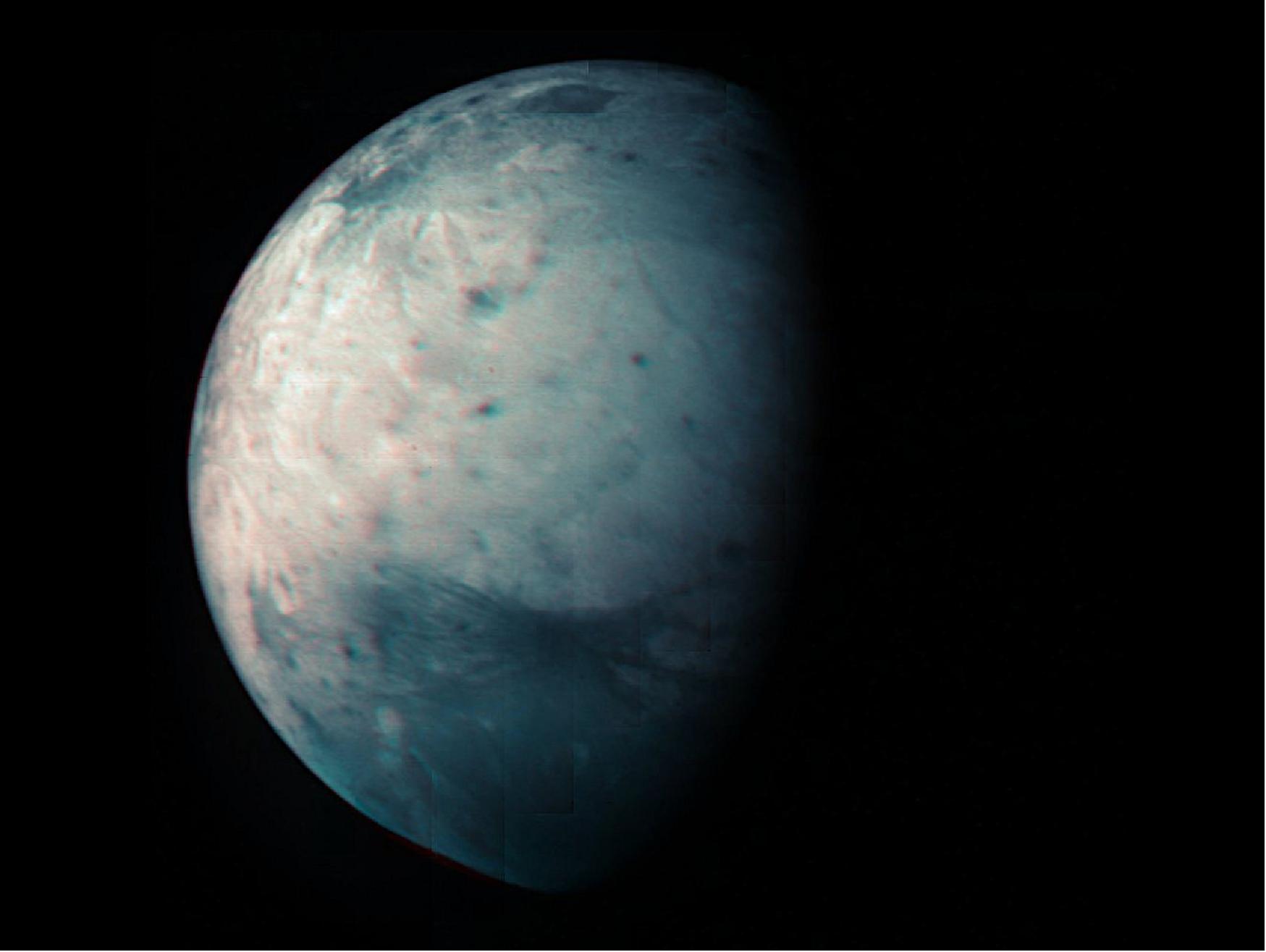
- Ganymede is also the only moon in the solar system with its own magnetic field. On Earth, the magnetic field provides a pathway for plasma (charged particles) from the Sun to enter our atmosphere and create auroras. Because Ganymede has no atmosphere to impede their progress, the surface at its poles is constantly being bombarded by plasma from Jupiter's gigantic magnetosphere. The bombardment has a dramatic effect on Ganymede's ice.
- "We found Ganymede's high latitudes dominated by water ice, with fine grain size, which is the result of the intense bombardment of charged particles," said Alessandro Mura, a Juno co-investigator from the National Institute for Astrophysics in Rome. "Conversely, low latitudes are shielded by the moon's magnetic field and contain more of its original chemical composition, most notably of non-water-ice constituents such as salts and organics. It is extremely important to characterize the unique properties of these icy regions to better understand the space-weathering processes that the surface undergoes."
- Juno's unique polar views and closeups of Ganymede build on observations by NASA's previous explorers, among them Voyager, Galileo, New Horizons, and Cassini. Future missions with Ganymede in their travel plans include the ESA (European Space Agency) JUICE mission, which will explore the icy Galilean moons with an emphasis on Ganymede, and NASA's Europa Clipper, which will focus on Ganymede's neighboring ocean world Europa.
10 Years an Explorer
- Juno lifted off from Cape Canaveral Air Force Station in Florida on Aug. 5, 2011, at 9:25 a.m. PDT (12:25 p.m. EDT). After a five-year, 1,740-million-mile (2,800-million-km) journey, it arrived at Jupiter on July 4, 2016.
- "Since launch, Juno has executed over 2 million commands, orbited Jupiter 35 times, and collected about three terabits of science data," said Project Manager Ed Hirst of JPL. "We are thrilled by our ongoing exploration of Jupiter, and there is much more to come. We have started our extended mission and look forward to 42 additional orbits to explore the Jovian system."
- Juno's extended mission, which tasks the spacecraft with continuing its investigations through September 2025, includes close passes of Jupiter's north polar cyclones, flybys of the moons Europa and Io (along with Ganymede), as well as the first exploration of the faint rings encircling the planet. It will also expand on discoveries Juno has already made about Jupiter's interior structure, internal magnetic field, atmosphere (including polar cyclones, deep atmosphere, and aurora), and magnetosphere.
• August 4, 2021: Sitting more than five times the distance from the Sun as Earth, Jupiter is not expected to be particularly warm. Based on the amount of sunlight received, the average temperature in the planet's upper atmosphere should be about minus 100 º Fahrenheit or a chilly minus 73º Celsius. Instead, the measured value soars to around 800º Fahrenheit (426º Celsius). The source of this extra heat has remained elusive for 50 years, causing scientists to refer to the discrepancy as an "energy crisis" for the planet. 9)
- Recently an international team assembled observations from a trio of observatories — NASA's Juno spacecraft, the Hisaki (SPRINT-A) satellite from the Japan Aerospace Exploration Agency (JAXA) and Keck Observatory on Maunakea in Hawaii. — to discover the likely source of Jupiter's thermal boost.
- "We found that Jupiter's intense aurora, the most powerful in the solar system, is responsible for heating the entire planet's upper atmosphere to surprisingly high temperatures," said James O'Donoghue of the JAXA Institute of Space and Astronautical Science, Sagamihara, Japan. O'Donoghue began the research while at NASA's Goddard Space Flight Center in Greenbelt, Maryland and is lead author of a paper about this research appearing in Nature August 4. 10)
- Auroras occur when electrically charged particles are caught in a planet's magnetic field. These spiral along invisible lines of force in the magnetic field towards the planet's magnetic poles, striking atoms and molecules in the atmosphere to release light and energy. On Earth, this leads to the colorful light show that forms the aurora Borealis and Australis, also known as the northern and southern lights. At Jupiter, material erupting from its volcanic moon, Io, leads to the most powerful aurora in the Solar System and enormous heating in upper atmosphere over the polar regions of the planet.
![Figure 11: Jupiter is shown in visible light for context underneath an artistic impression of the Jovian upper atmosphere's infrared glow. The brightness of this upper atmosphere layer corresponds to temperatures, from hot to cold, in this order: white, yellow, bright red and lastly, dark red. The aurorae are the hottest regions and the image shows how heat may be carried by winds away from the aurora and cause planet-wide heating [image credits: J. O'Donoghue (JAXA)/Hubble/NASA/ESA/A. Simon/J. Schmidt]](https://eoportal.org/ftp/satellite-missions/j/juno-21122021/Juno_Auto1E.jpeg)
- The idea that the aurora could be the source of Jupiter's mysterious energy had been proposed previously but observations have been unable to confirm or deny this until now.
- Global models of Jupiter's upper atmosphere suggested that winds heated by the aurora and headed to the equator would be overwhelmed and redirected by westward winds driven by the planet's rapid rotation. This would prevent the auroral energy from escaping the polar regions and heating the whole atmosphere. However, this new observational result suggests that such trapping is not occurring, and that the westward winds may be relatively weaker than expected compared with equatorward winds.
- High-resolution temperature maps from Keck II, combined with magnetic field data from Hisaki and Juno, allowed the team to catch the aurora in the act of sending what appears to be a pulse of heat toward Jupiter's equator.
- The team observed Jupiter with the Keck II telescope for five hours on two separate nights in April 2016 and January 2017. Using the Near-Infrared Spectrometer (NIRSPEC) on Keck II, heat from electrically charged hydrogen molecules (H3+ ions) in Jupiter's atmosphere was traced from the planet's poles down to the equator.
- Previous maps of the upper atmospheric temperature were formed using images consisting of only several pixels. That's not enough resolution to see how the temperature might be changing across the planet, providing few clues as to the origin of the extra heat. To improve the situation, the team utilized the power of Keck II to take many more temperature measurements across the face of the planet and only included measurements with uncertainty in the recorded value of less than five percent. This took years of careful work and yielded temperature maps with over ten thousand individual data points, the highest resolution to date.
- Instead of high temperatures only in the polar regions near the aurora, which would be expected if the heat was trapped there, these detailed maps showed that the heat in the upper atmosphere was more widely distributed, with a gradual decrease in temperature closer to the equator.
- "We also revealed a strange localized region of heating well away from the aurora - a long bar of heating unlike anything we've seen before," said Tom Stallard, a co-author of the paper at the University of Leicester, Leicester, United Kingdom. "Though we can't be sure what this feature is, I am convinced it's a rolling wave of heat flowing equatorward from the aurora."
- Additionally, observations from JAXA's Hisaki satellite showed that conditions at the time of the Keck II temperature observations could generate a strong aurora on Jupiter. From orbit around Earth, Hisaki has observed the aurora-generating magnetic field around Jupiter since the mission's launch in 2013. This long-term monitoring has revealed that Jupiter's magnetic field is strongly influenced by the solar wind; a stream of high-energy particles that emanates from the Sun. The solar wind carries its own magnetic field and when this meets Jupiter's planetary field, the latter is compressed. At the time of the Keck II observations, Hisaki showed that pressure from the solar wind was particularly high at Jupiter and the field compression is likely to have created an enhanced aurora.
- Finally, observations from Juno in orbit around Jupiter provided the precise location of the aurora on the planet. "Juno's magnetic field data provided us with a ‘ground truth' as to where the aurora was: this information isn't readily available from heat maps, as heat leaks away in many directions," said O'Donoghue. "Picture this like a beach: if the hot atmosphere is water, the magnetic field mapped by Juno is shoreline, and the aurora is ocean, we found that water left the ocean and flooded the land, and Juno revealed where that shoreline was to help us understand the degree of flooding."
- "It was pure luck that we captured this potential heat-shedding event," adds O'Donoghue. "If we'd observed Jupiter on a different night, when the solar wind pressure had not recently been high, we would have missed it!"
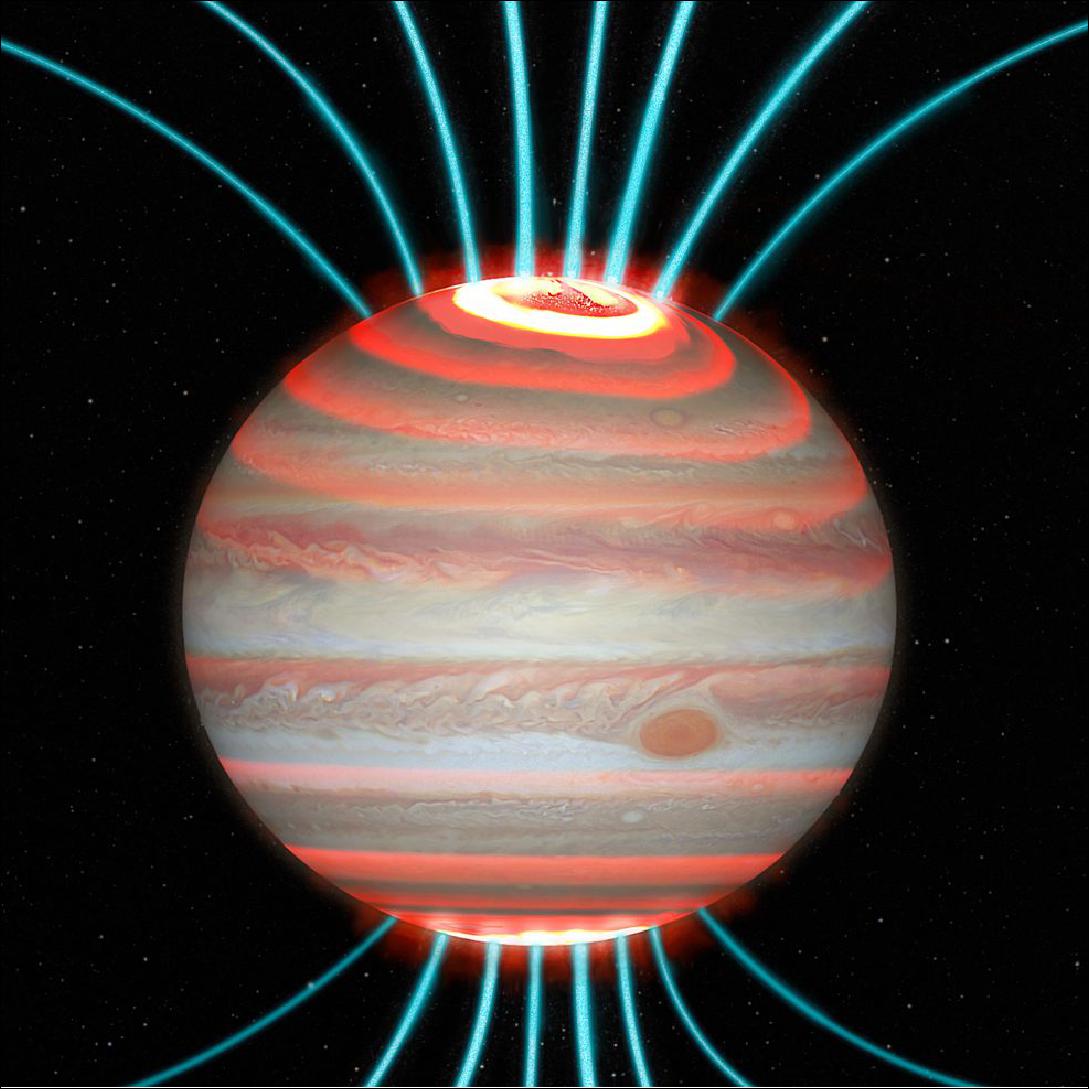
More about the observatories and partners
- The research was funded by NASA through the Solar System Observations Program and the Solar System Workings Program as well as JAXA's International Top Young Fellowship program. Juno is part of NASA's New Frontiers Program, which is managed at NASA's Marshall Space Flight Center in Huntsville, Alabama, for the agency's Science Mission Directorate in Washington. NASA's Jet Propulsion Laboratory, a division of Caltech in Pasadena, California, manages the Juno mission for the principal investigator, Scott Bolton, of the Southwest Research Institute, San Antonio, Texas. NASA Goddard built and runs Juno's magnetometer instrument. The W. M. Keck Observatory is operated as a scientific partnership among the California Institute of Technology, the University of California and NASA. The Observatory was made possible by the financial support of the W. M. Keck Foundation. The authors wish to recognize and acknowledge the significant cultural role and reverence that the summit of Maunakea has always had within the indigenous Hawaiian community; the authors are fortunate to have the opportunity to conduct observations from this mountain.
• July 15, 2021: By listening to the rain of electrons flowing onto Jupiter from its intensely volcanic moon Io, researchers using NASA's Juno spacecraft have found what triggers powerful radio emissions within the planet's magnetic field, illuminating the behavior of the enormous magnetic fields generated by gas-giant planets like Jupiter. 11)
- Jupiter has the largest, most powerful magnetic field of all the planets in our solar system, with a strength at its source about 20,000 times stronger than Earth's. It is buffeted by the solar wind, a stream of electrically charged particles and magnetic fields constantly blowing from the Sun. Depending on how hard the solar wind blows, Jupiter's magnetic field can extend outward as much as two million miles (3.2 million km) toward the Sun and stretch more than 600 million miles (over 965 million km) away from the Sun, as far as Saturn's orbit. Jupiter has several large moons that orbit within its massive magnetic field, with Io being the closest. Io is caught in a gravitational tug-of-war between Jupiter and the neighboring two of these other large moons, which generates internal heat that powers hundreds of volcanic eruptions across its surface.
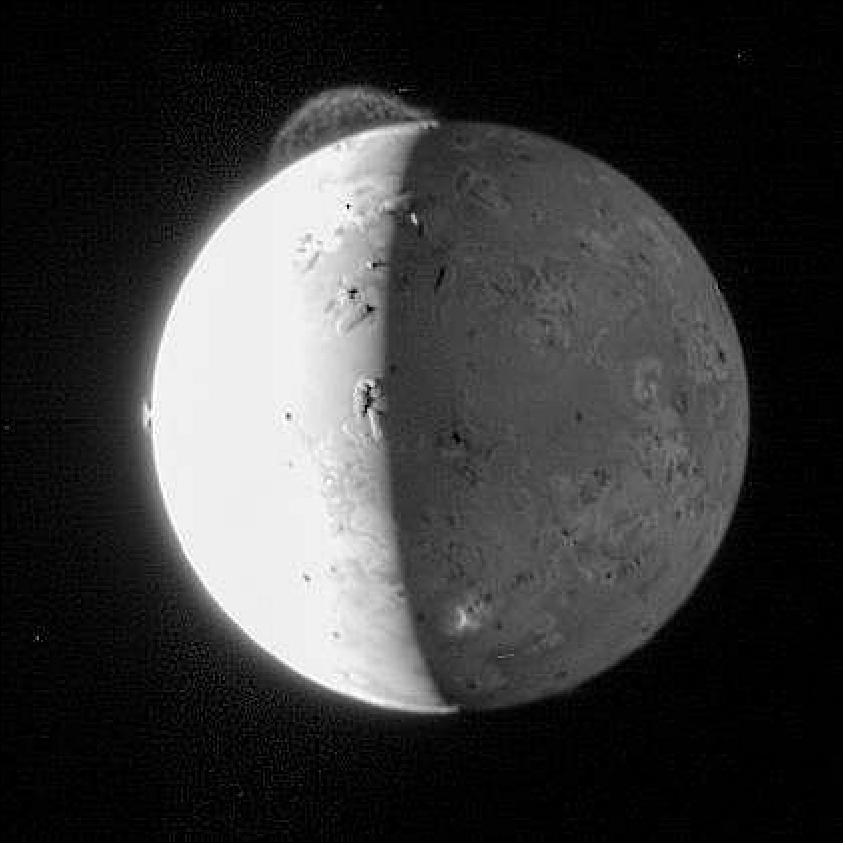
- These volcanoes collectively release one ton of material (gases and particles) per second into space near Jupiter. Some of this material splits up into electrically charged ions and electrons and is rapidly captured by Jupiter's magnetic field. As Jupiter's magnetic field sweeps past Io, electrons from the moon are accelerated along the magnetic field toward Jupiter's poles. Along their way, these electrons generate "decameter" radio waves (so-called decametric radio emissions or DAM). The Juno Waves instrument can "listen" to this radio emission that the raining electrons generate.
- The researchers used the Juno Waves data to identify the precise locations within Jupiter's vast magnetic field where these radio emissions originated. These locations are where conditions are just right to generate the radio waves; they have the right magnetic field strength and the right density of electrons (not too much and not too little), according to the team.
- "The radio emission is likely constant, but Juno has to be in the right spot to listen," said Yasmina Martos of NASA's Goddard Space Flight Center, Greenbelt, Maryland and the University of Maryland, College Park. The radio waves emerge from the source along the walls of a hollow cone aligned with and controlled by the strength and shape of the magnetic field of Jupiter. Juno receives the signal only when Jupiter's rotation sweeps that cone over the spacecraft, in the same way a lighthouse beacon shines briefly upon a ship at sea. Martos is lead author of a paper about this research published in June 2020 in the Journal of Geophysical Research, Planets.
- Data from Juno allowed the team to calculate that the energy of the electrons generating the radio waves was far higher than previously estimated, as much as 23 times greater. Also, the electrons do not necessarily need to come from a volcanic moon. For example, they could be in the planet's magnetic field (magnetosphere) or come from the Sun as part of the solar wind, according to the team.
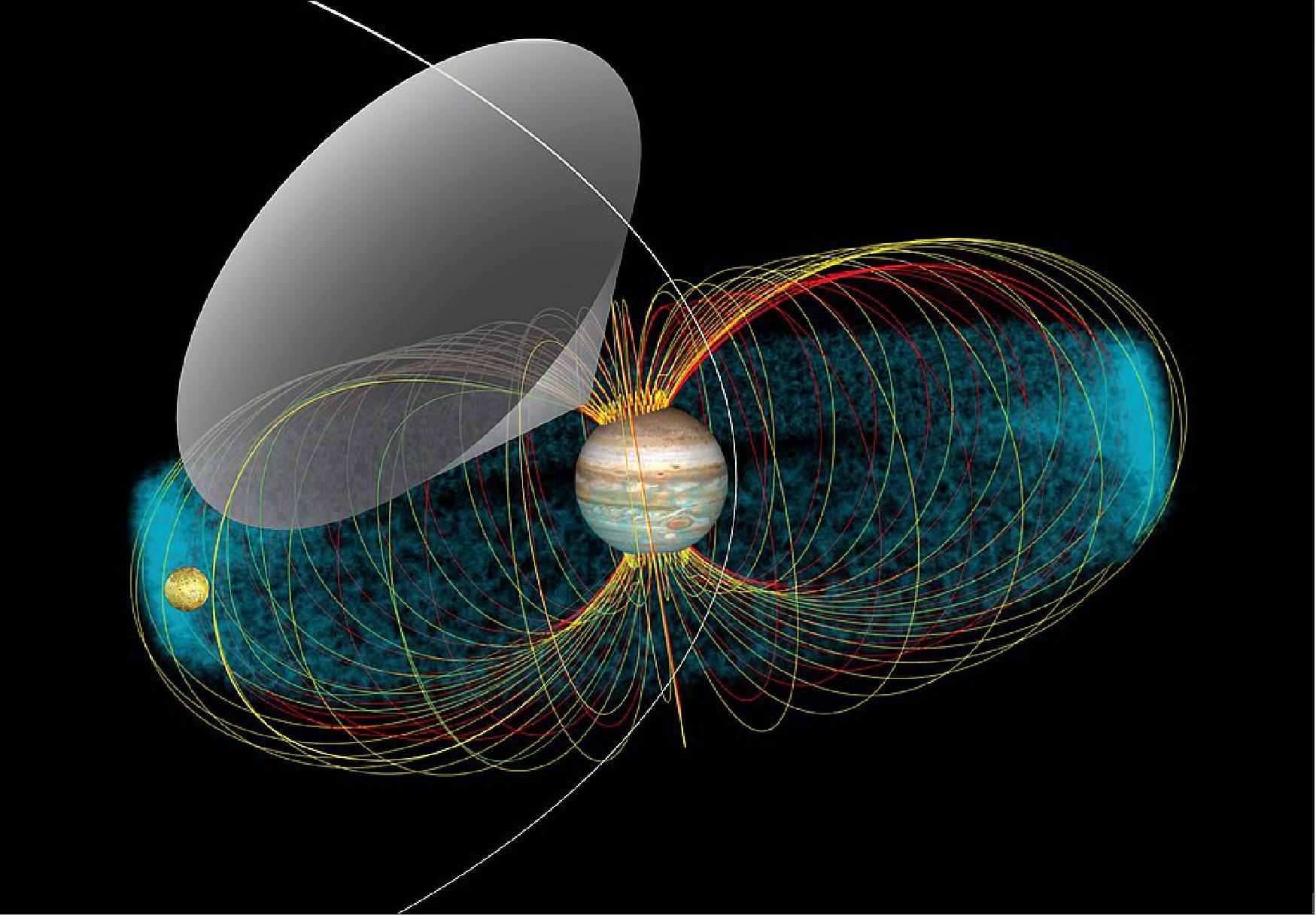
More about this project and the Juno Mission
- he research was funded by the Juno Project under NASA Grants NNM06AAa75c and 699041X to the Southwest Research Institute, San Antonio, Texas, and NASA Grant NNN12AA01C to NASA's Jet Propulsion Laboratory, a division of Caltech in Pasadena, California. The team is composed of researchers from NASA Goddard, the National Institute of Technology (KOSEN), Tokyo, Japan, Niihama College in Niihama, Ehime, Japan, the University of Iowa, Iowa City, and the Technical University of Denmark in Kongens Lyngby, Denmark. NASA JPL manages the Juno mission for the principal investigator, Scott Bolton, of the Southwest Research Institute. Juno is part of NASA's New Frontiers Program, which is managed at NASA's Marshall Space Flight Center in Huntsville, Alabama, for the agency's Science Mission Directorate in Washington. Lockheed Martin Space in Denver built and operates the spacecraft.
• July 14, 2021: The probe flew closer to Jupiter's largest moon, Ganymede, than any other spacecraft in more than two decades, offering dramatic glimpses of both the icy orb and the gas giant. 12)
- On June 7, 2021, NASA's Juno spacecraft flew closer to Jupiter's ice-encrusted moon Ganymede than any spacecraft in more than two decades. Less than a day later, Juno made its 34th flyby of Jupiter, racing over its roiling atmosphere from pole to pole in less than three hours. Using the spacecraft's JunoCam imager, the mission team has put together this animation to provide a "starship captain" point of view of each flyby.
- "The animation shows just how beautiful deep space exploration can be," said Scott Bolton, principal investigator for Juno from the Southwest Research Institute in San Antonio. "The animation is a way for people to imagine exploring our solar system firsthand by seeing what it would be like to be orbiting Jupiter and flying past one of its icy moons. Today, as we approach the exciting prospect of humans being able to visit space in orbit around Earth, this propels our imagination decades into the future, when humans will be visiting the alien worlds in our solar system."
- The 3:30-minute-long animation begins with Juno approaching Ganymede, passing within 645 miles (1,038 km) of the surface at a relative velocity of 41,600 mph (67,000 km/h). The imagery shows several of the moon's dark and light regions (darker regions are believed to result from ice sublimating into the surrounding vacuum, leaving behind darkened residue) as well as the crater Tros, which is among the largest and brightest crater scars on Ganymede.
- It takes just 14 hours, 50 minutes for Juno to travel the 735,000 miles (1.18 million km) between Ganymede and Jupiter, and the viewer is transported to within just 2,100 miles (3,400 km) above Jupiter's spectacular cloud tops. By that point, Jupiter's powerful gravity has accelerated the spacecraft to almost 130,000 mph (210,000 km/h) relative to the planet.
- Among the Jovian atmospheric features that can be seen are the circumpolar cyclones at the north pole and five of the gas giant's "string of pearls" – eight massive storms rotating counterclockwise in the southern hemisphere that appear as white ovals. Using information that Juno has learned from studying Jupiter's atmosphere, the animation team simulated lightning one might see as we pass over Jupiter's giant thunderstorms.
- The camera's point of view for this time-lapse animation was generated by citizen scientist Gerald Eichstädt, using composite images of Ganymede and Jupiter. For both worlds, JunoCam images were orthographically projected onto a digital sphere and used to create the flyby animation. Synthetic frames were added to provide views of approach and departure for both Ganymede and Jupiter.
- As planned, the gravitational pull of the giant moon has affected Juno's orbit, resulting in the reduction of its orbital period from 53 days to 43 days. The next flyby of Jupiter, the 35th of the mission, is scheduled for July 21.
• July 13, 2021: Planetary astronomers combined measurements taken by NASA's Juno spacecraft orbiting Jupiter, with data from ESA's (European Space Agency's) Earth-orbiting XMM-Newton mission, to solve a 40-year-old mystery about the origins of Jupiter's unusual X-ray auroras. For the first time, they have seen the entire mechanism at work: The electrically charged atoms, or ions, responsible for the X-rays are "surfing" electromagnetic waves in Jupiter's magnetic field down into the gas giant's atmosphere. 13)
- A paper on the study was published on July 9 in the journal Science Advances.
- Auroras have been detected on seven planets in our solar system. Some of these light shows are visible to the human eye; others generate wavelengths of light we can only see with specialized telescopes. Shorter wavelengths require more energy to produce. Jupiter has the most powerful auroras in the solar system and is the only one of the four giant planets with an aurora that has been found to emit X-rays.
- Planetary astronomers have been fascinated with Jupiter's X-ray auroral emission since its discovery four decades ago because it was not immediately clear how the energy required to produce it is generated. They knew these surprising Jovian northern and southern lights are triggered by ions crashing into Jupiter's atmosphere. But until now scientists had no idea how the ions responsible for the X-ray light show are able to get to the atmosphere in the first place.
![Figure 17: The purple hues in this image show X-ray emissions from Jupiter's auroras, detected by NASA's Chandra Space Telescope in 2007. They are overlaid on an image of Jupiter taken by NASA's Hubble Space Telescope. Jupiter is the only gas giant planet where scientists have detected X-ray auroras [image credits: (X-ray) NASA/CXC/SwRI/R. Gladstone et al.; (Optical) NASA/ESA/Hubble Heritage (AURA/STScI)]](https://eoportal.org/ftp/satellite-missions/j/juno-21122021/Juno_Auto1A.jpeg)
- At Earth, auroras are usually visible only in a belt surrounding the magnetic poles, between 65 and 80 degrees latitude. Beyond 80 degrees, auroral emission disappears because the magnetic field lines leave Earth and connect to the magnetic field in the solar wind, which is the constant flux of electrically charged particles ejected by the Sun. These are called open field lines, and in the traditional picture, Jupiter's and Saturn's high-latitude polar regions are not expected to emit substantial auroras, either.
- However, Jupiter's X-ray auroras are different. They exist poleward of the main auroral belt and pulsate, and those at the north pole often differ from those at the south pole. These are typical features of a closed magnetic field, where the magnetic field line exits the planet at one pole and reconnects with the planet at the other. All planets with magnetic fields have both open and closed field components.
- Scientists studying the phenomena turned to computer simulations and found that the pulsating X-ray auroras could be linked to closed magnetic fields that are generated inside Jupiter and then stretch out millions of miles into space before turning back. But how to prove the model was viable?
- The study authors turned to data acquired by both Juno and XMM-Newton from July 16 to 17, 2017. During the two-day span, XMM-Newton observed Jupiter continuously for 26 hours and saw X-ray aurora pulsating every 27 minutes.
- At the same time, Juno had been traveling between 62 and 68 Jupiter radii (about 2.8 to 3 million miles, or 4.4 to 4.8 million kilometers) above the planet's pre-dawn area. This was exactly the region that the team's simulations suggested was important for triggering the pulsations, so they searched the Juno data for any magnetic processes that were occurring at the same rate.
- They found that fluctuations of Jupiter's magnetic field caused the pulsating X-ray auroras. The outer boundary of the magnetic field is struck directly by the particles of the solar wind and compressed. These compressions heat ions that are trapped in Jupiter's extensive magnetic field, which are millions of miles away from the planet's atmosphere.
- This triggers a phenomenon called electromagnetic ion cyclotron (EMIC) waves, in which the particles are directed along the field lines. Guided by the field, the ions ride the EMIC wave across millions of miles of space, eventually slamming into the planet's atmosphere and triggering the X-ray auroras.
- "What we see in the Juno data is this beautiful chain of events. We see the compression happen, we see the EMIC wave triggered, we see the ions, and then we see a pulse of ions traveling along the field line," said William Dunn of the Mullard Space Science Laboratory, University College London, and a co-author of the paper. "Then, a few minutes later, XMM sees a burst of X-rays."
- Now that the missing piece of the process has been identified for the first time, it opens up a wealth of possibilities for where it could be studied next. For example, at Jupiter, the magnetic field is filled with sulfur and oxygen ions being emitted by the volcanoes on the moon Io. At Saturn, the moon Enceladus jets water into space, filling Saturn's magnetic field with water group ions.
• June 8, 2021: The Juno spacecraft flew closer to Jupiter's largest moon than any other in more than two decades, offering dramatic glimpses of the icy orb. 14)
- The first two images from NASA Juno's June 7, 2021, flyby of Jupiter's giant moon Ganymede have been received on Earth. The photos – one from the Jupiter orbiter's JunoCam imager and the other from its Stellar Reference Unit star camera – show the surface in remarkable detail, including craters, clearly distinct dark and bright terrain, and long structural features possibly linked to tectonic faults.
- "This is the closest any spacecraft has come to this mammoth moon in a generation," said Juno Principal Investigator Scott Bolton of the Southwest Research Institute in San Antonio. "We are going to take our time before we draw any scientific conclusions, but until then we can simply marvel at this celestial wonder."
- Using its green filter, the spacecraft's JunoCam visible-light imager captured almost an entire side of the water-ice-encrusted moon. Later, when versions of the same image come down incorporating the camera's red and blue filters, imaging experts will be able to provide a color portrait of Ganymede. Image resolution is about 0.6 miles (1 km) per pixel.
- In addition, Juno's Stellar Reference Unit, a navigation camera that keeps the spacecraft on course, provided a black-and-white picture of Ganymede's dark side (the side opposite the Sun) bathed in dim light scattered off Jupiter. Image resolution is between 0.37 to 0.56 miles (600 to 900 m) per pixel.
- "The conditions in which we collected the dark side image of Ganymede were ideal for a low-light camera like our Stellar Reference Unit," said Heidi Becker, Juno's radiation monitoring lead at JPL. "So this is a different part of the surface than seen by JunoCam in direct sunlight. It will be fun to see what the two teams can piece together."
- The spacecraft will send more images from its Ganymede flyby in the coming days, with JunoCam's raw images being made available here.
- The solar-powered spacecraft's encounter with the Jovian moon is expected to yield insights into its composition, ionosphere, magnetosphere, and ice shell while also providing measurements of the radiation environment that will benefit future missions to the Jovian system.
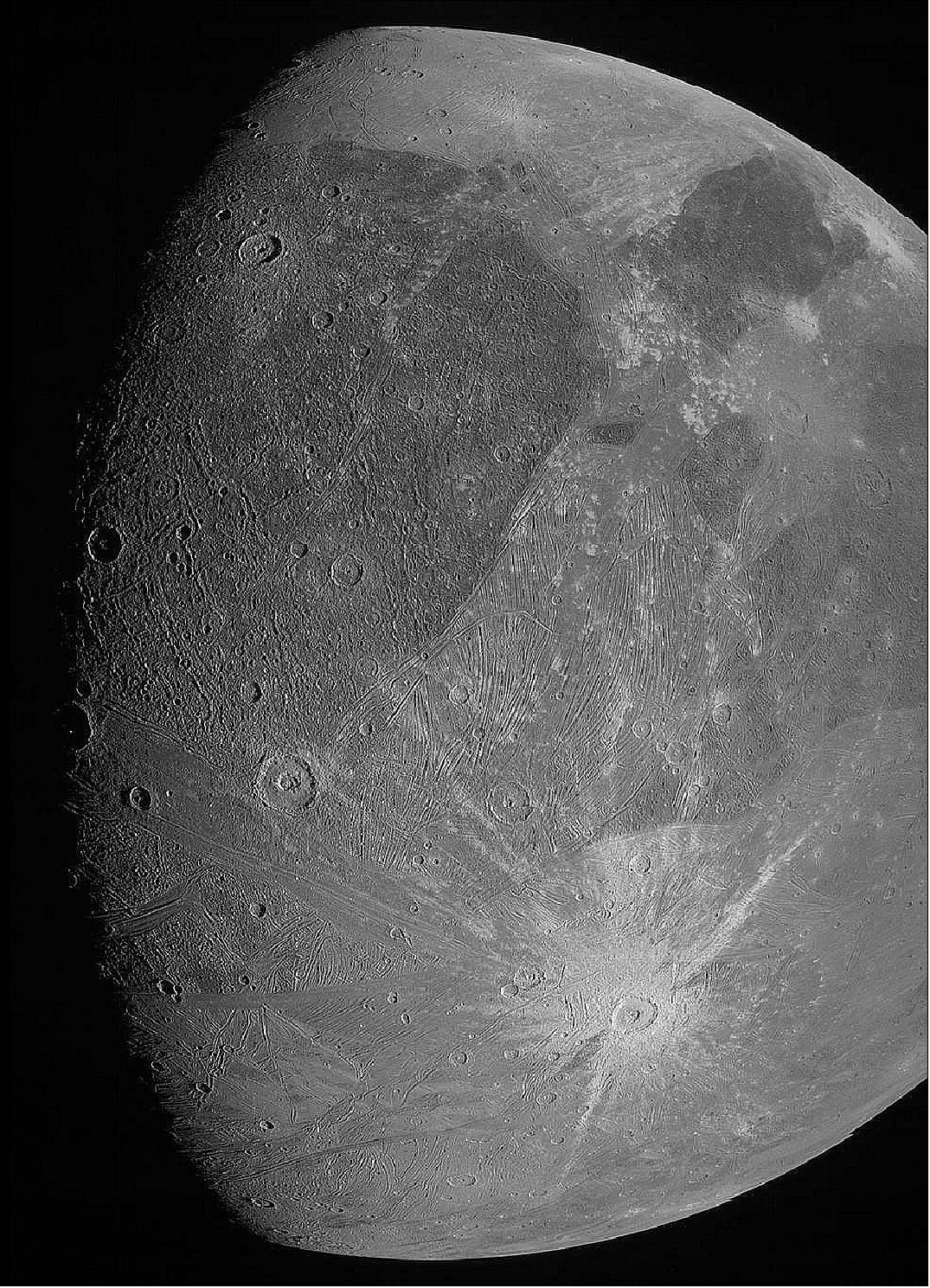

• June 3, 2021: The first of the gas-giant orbiter's back-to-back flybys will provide a close encounter with the massive moon after over 20 years. 15)
- On Monday, June 7, at 1:35 p.m. EDT (10:35 a.m. PDT), NASA's Juno spacecraft will come within 645 miles (1,038 kilometers) of the surface of Jupiter's largest moon, Ganymede. The flyby will be the closest a spacecraft has come to the solar system's largest natural satellite since NASA's Galileo spacecraft made its penultimate close approach back on May 20, 2000. Along with striking imagery, the solar-powered spacecraft's flyby will yield insights into the moon's composition, ionosphere, magnetosphere, and ice shell. Juno's measurements of the radiation environment near the moon will also benefit future missions to the Jovian system.
- Ganymede is bigger than the planet Mercury and is the only moon in the solar system with its own magnetosphere – a bubble-shaped region of charged particles surrounding the celestial body.
- "Juno carries a suite of sensitive instruments capable of seeing Ganymede in ways never before possible," said Juno Principal Investigator Scott Bolton of the Southwest Research Institute in San Antonio. "By flying so close, we will bring the exploration of Ganymede into the 21st century, both complementing future missions with our unique sensors and helping prepare for the next generation of missions to the Jovian system – NASA's Europa Clipper and ESA's [European Space Agency's] JUpiter ICy moons Explorer [JUICE] mission."
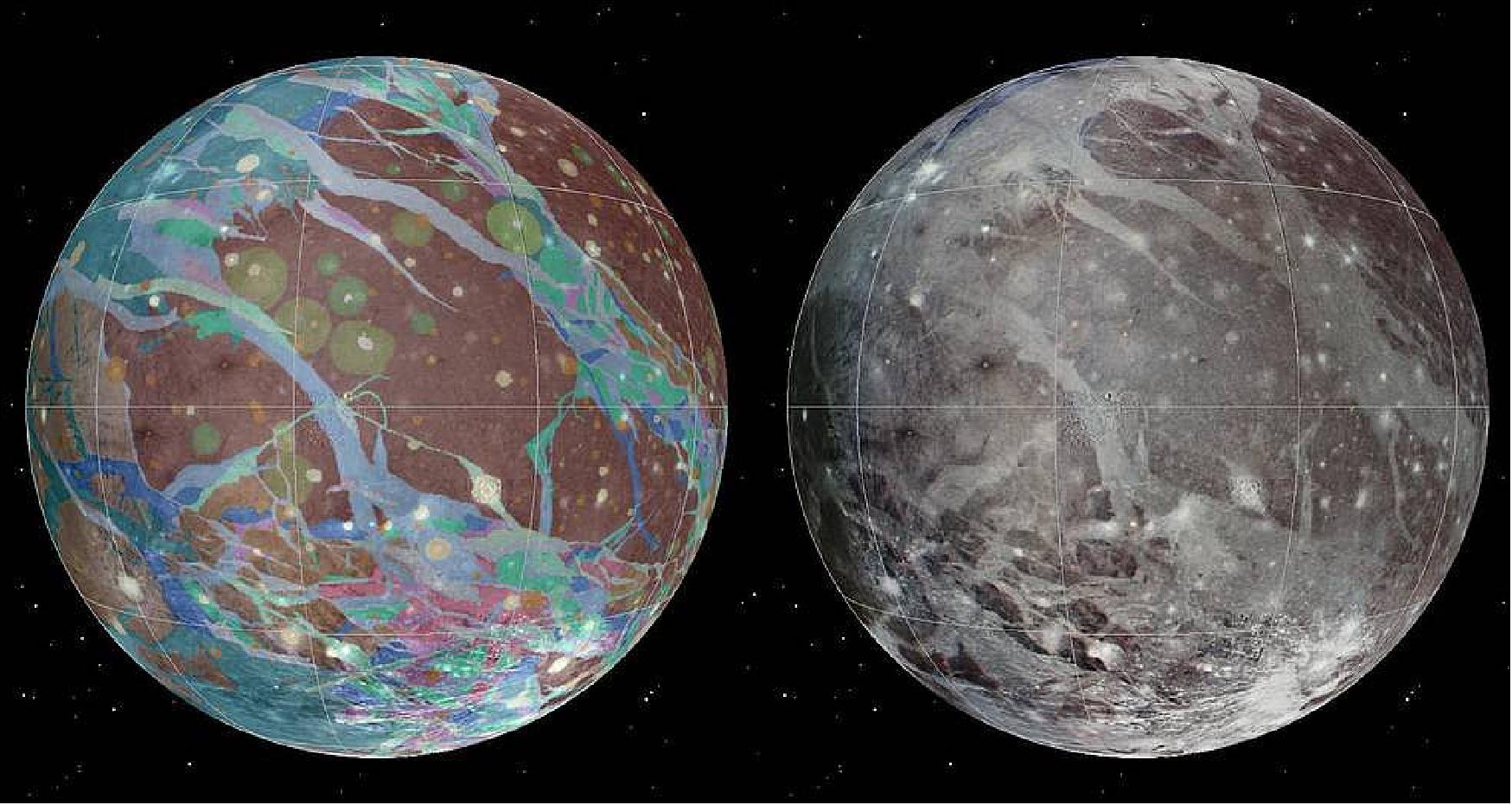
• March 16, 2021: New results from the Ultraviolet Spectrograph instrument on NASA's Juno mission reveal for the first time the birth of auroral dawn storms – the early morning brightening unique to Jupiter's spectacular aurorae. These immense, transient displays of light occur at both Jovian poles and had previously been observed only by ground-based and Earth-orbiting observatories, notably NASA's Hubble Space Telescope. Results of this study were published March 16 in the journal AGU Advances. 16)
- First discovered by Hubble's Faint Object Camera in 1994, dawn storms consist of short-lived but intense brightening and broadening of Jupiter's main auroral oval – an oblong curtain of light that surrounds both poles – near where the atmosphere emerges from darkness in the early morning region. Before Juno, observations of Jovian ultraviolet aurora had offered only side views, hiding everything happening on the nightside of the planet.
- "Observing Jupiter's aurora from Earth does not allow you to see beyond the limb, into the nightside of Jupiter's poles. Explorations by other spacecraft – Voyager, Galileo, Cassini – happened from relatively large distances and did not fly over the poles, so they could not see the complete picture," said Bertrand Bonfond, a researcher from the University of Liège in Belgium and lead author of the study. "That's why the Juno data is a real game changer, allowing us a better understanding what is happening on the nightside, where the dawn storms are born."
- Researchers found dawn storms are born on the nightside of the gas giant. As the planet rotates, the soon-to-be dawn storm rotates with it into the dayside, where these complex and intensely bright auroral features grow even more luminous, emitting anywhere from hundreds to thousands of gigawatts of ultraviolet light into space. The jump in brightness implies that dawn storms are dumping at least 10 times more energy into Jupiter's upper atmosphere than typical aurora.
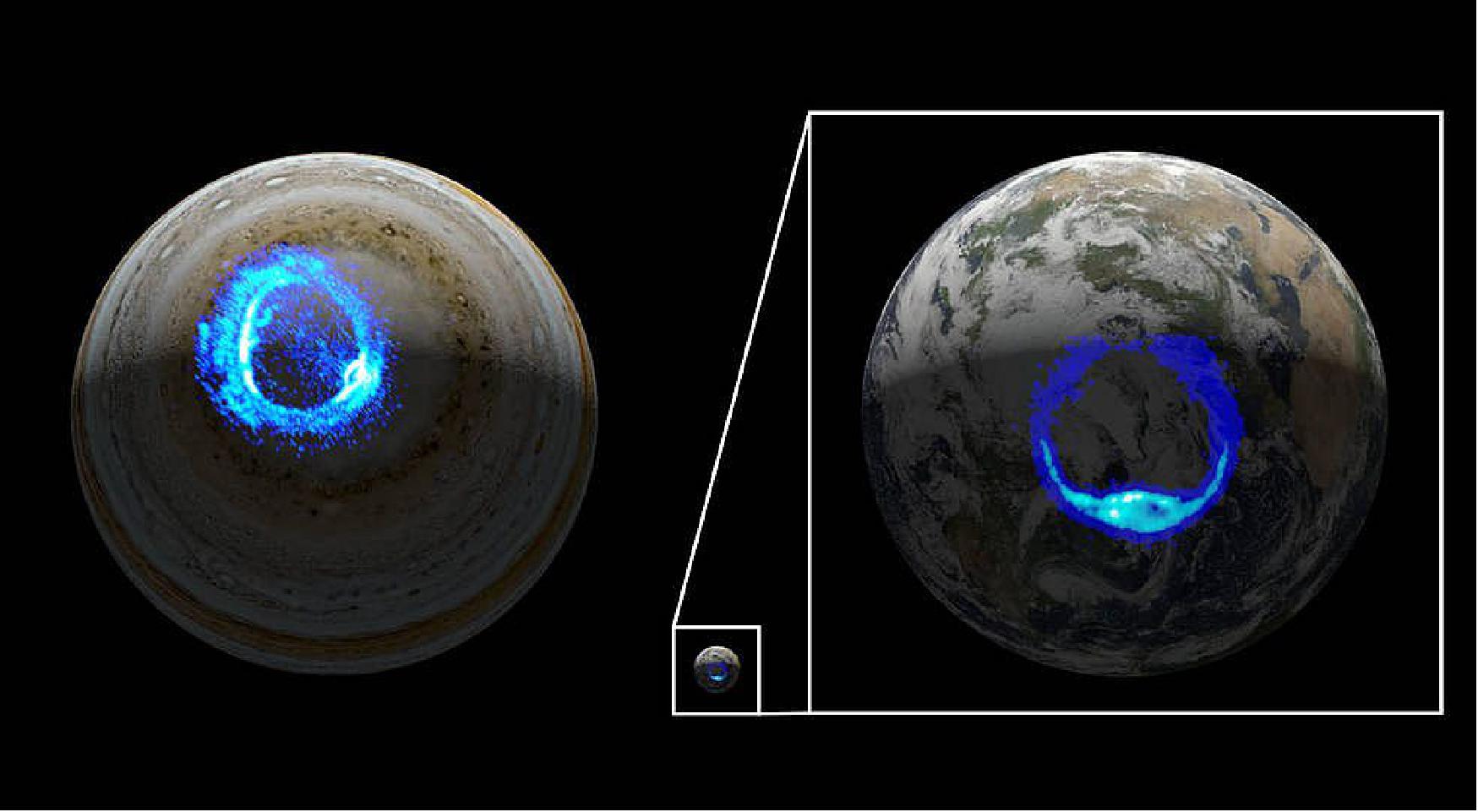
- "When we looked at the whole dawn storm sequence, we couldn't help but notice that they are very similar to a type of terrestrial auroras called substorms," said Zhonghua Yao, co-author of the study at the University of Liège."
- Substorms result from brief disturbances in the Earth's magnetosphere – the region of space controlled by the planet's magnetic field – that release energy high into the planet's ionosphere. The similarity between terrestrial and Jovian substorms is surprising because the magnetospheres of Jupiter and Earth are radically different. On Earth, the magnetosphere is essentially controlled by the interaction of the solar wind – the stream of charged particles flowing from the Sun – with Earth's magnetic field. Jupiter's magnetosphere is mostly populated by particles escaping from the volcanic moon Io, which then get ionized and trapped around the gas giant via its magnetic field.
- These new findings will allow scientists to further study the differences and similarities driving the formation of aurora, providing a better understanding how these most beautiful of planetary phenomena occur on worlds both within our solar system and beyond.
- "The power that Jupiter possesses is amazing. The energy in these dawn aurorae is yet another example of how powerful this giant planet really is," said Scott Bolton, principal investigator of Juno from the Southwest Research Institute in San Antonio. "The dawn storm revelations are another surprise from the Juno mission, which is constantly rewriting the book on how giant planet's work. With NASA's recent mission extension, we're looking forward to many more new insights and discoveries."
• January 13, 2021: The spacecraft, which has been gathering data on the gas giant Jupiter since July 2016, will become an explorer of the full Jovian system – Jupiter and its rings and moons. 17)

- NASA has authorized a mission extension for its Juno spacecraft exploring Jupiter. The agency's most distant planetary orbiter will now continue its investigation of the solar system's largest planet through September 2025, or until the spacecraft's end of life. This expansion tasks Juno with becoming an explorer of the full Jovian system – Jupiter and its rings and moons – with multiple rendezvous planned for three of Jupiter's most intriguing Galilean moons: Ganymede, Europa, and Io.
- "Since its first orbit in 2016, Juno has delivered one revelation after another about the inner workings of this massive gas giant," said principal investigator Scott Bolton of the Southwest Research Institute in San Antonio. "With the extended mission, we will answer fundamental questions that arose during Juno's prime mission while reaching beyond the planet to explore Jupiter's ring system and Galilean satellites."
- Proposed in 2003 and launched in 2011, Juno arrived at Jupiter on July 4, 2016. The prime mission will be completed in July 2021. The extended mission involves 42 additional orbits, including close passes of Jupiter's north polar cyclones; flybys of Ganymede, Europa, and Io; as well as the first extensive exploration of the faint rings encircling the planet.
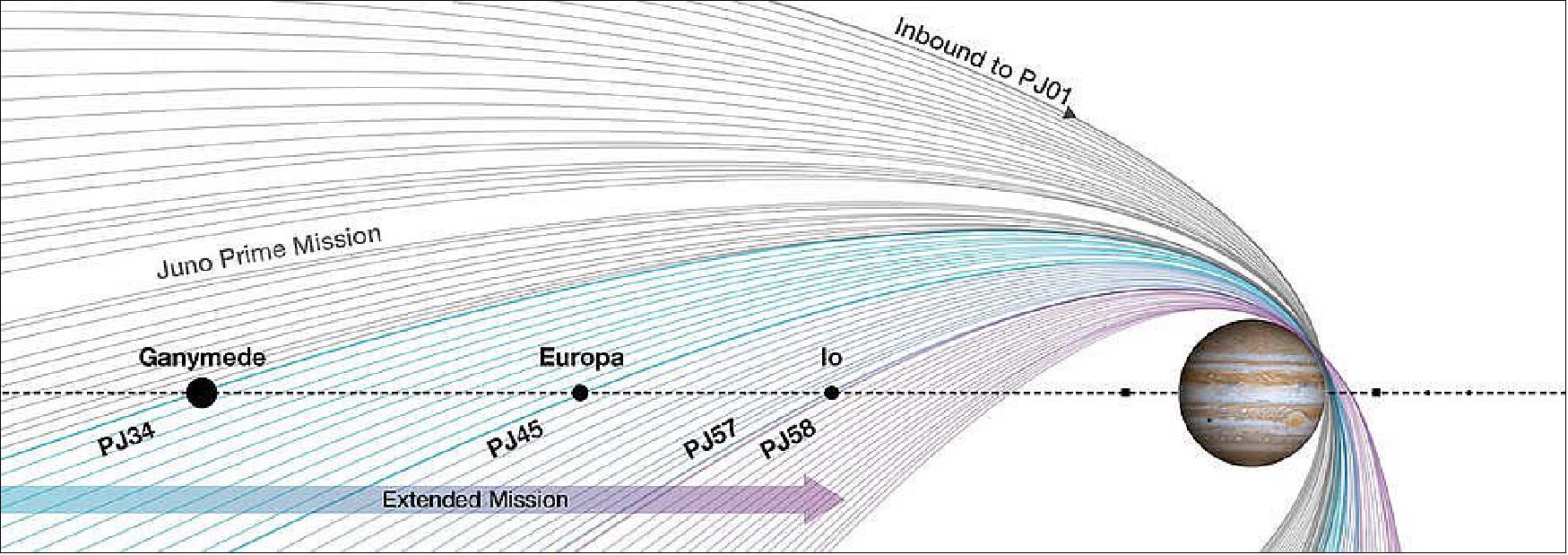
- "By extending the science goals of this important orbiting observatory, the Juno team will start tackling a breadth of science historically required of flagships," said Lori Glaze, planetary science division director at NASA Headquarters in Washington. "This represents an efficient and innovative advance for NASA's solar system exploration strategy."
- The data Juno collects will contribute to the goals of the next generation of missions to the Jovian system – NASA's Europa Clipper and the ESA (European Space Agency) JUpiter ICy moons Explorer (JUICE) mission. Juno's investigation of Jupiter's volcanic moon Io addresses many science goals identified by the National Academy of Sciences for a future Io explorer mission.
- The extended mission's science campaigns will expand on discoveries Juno has already made about Jupiter's interior structure, internal magnetic field, atmosphere (including polar cyclones, deep atmosphere, and aurora), and magnetosphere.
- "With this extension, Juno becomes its own follow-on mission," said Steve Levin, Juno project scientist at NASA's Jet Propulsion Laboratory in Southern California. "Close-up observations of the pole, radio occultations" – a remote sensing technique to measure properties of a planetary atmosphere or ring systems – "satellite flybys, and focused magnetic field studies combine to make a new mission, the next logical step in our exploration of the Jovian system."
- Jupiter's enigmatic Great Blue Spot, an isolated patch of intense magnetic field near the planet's equator, will be the target of a high-spatial-resolution magnetic survey during six flybys early in the extended mission. As Juno's orbit evolves, multiple flybys of the moons Ganymede (2), Europa (3), and Io (11) are planned, as well as multiple passages through Jupiter's tenuous rings.
- Juno will also fly through the Europa and Io tori – ring-shaped clouds of ions – on multiple occasions, characterizing the radiation environment near these satellites to better prepare the Europa Clipper and JUICE missions for optimizing observation strategies and planning, science priorities, and mission design. The extended mission also adds a study of dust in Jupiter's faint rings to Juno's extensive list of science investigations.
An Evolving Orbit
- The natural evolution of Juno's orbit around the gas giant provides the wealth of new science opportunities that the extended mission capitalizes on. Every science pass sends the solar-powered spacecraft zooming low over Jupiter's cloud tops, collecting data from a unique vantage point no other spacecraft has enjoyed.
- The point during each orbit where Juno comes closest to the planet is called perijove (or PJ). Over the course of the mission, Juno's perijoves have migrated northward, dramatically improving resolution over the northern hemisphere. The design of the extended mission takes advantage of the continued northward migration of these perijoves to sharpen its view of the multiple cyclones encircling the north pole while incorporating ring and Galilean moon flybys.
- "The mission designers have done an amazing job crafting an extended mission that conserves the mission's single most valuable onboard resource – fuel," said Ed Hirst, the Juno project manager at JPL. "Gravity assists from multiple satellite flybys steer our spacecraft through the Jovian system while providing a wealth of science opportunities." The satellite flybys also reduce Juno's orbital period, which increases the total number of science orbits that can be obtained."
- The satellite encounters begin with a low-altitude flyby of Ganymede on June 7, 2021 (PJ34), which reduces the orbital period from about 53 days to 43 days. That flyby sets up a close flyby of Europa on Sept. 29, 2022 (PJ45), reducing the orbital period further to 38 days. A pair of close Io flybys, on Dec. 30, 2023 (PJ57), and Feb. 3, 2024 (PJ58), combine to reduce the orbital period to 33 days.
• December 11, 2020: The spacecraft has been collecting data on the gas giant's interior since July 2016. Some of its latest findings touch on "hot spots" in the planet's atmosphere. 18)
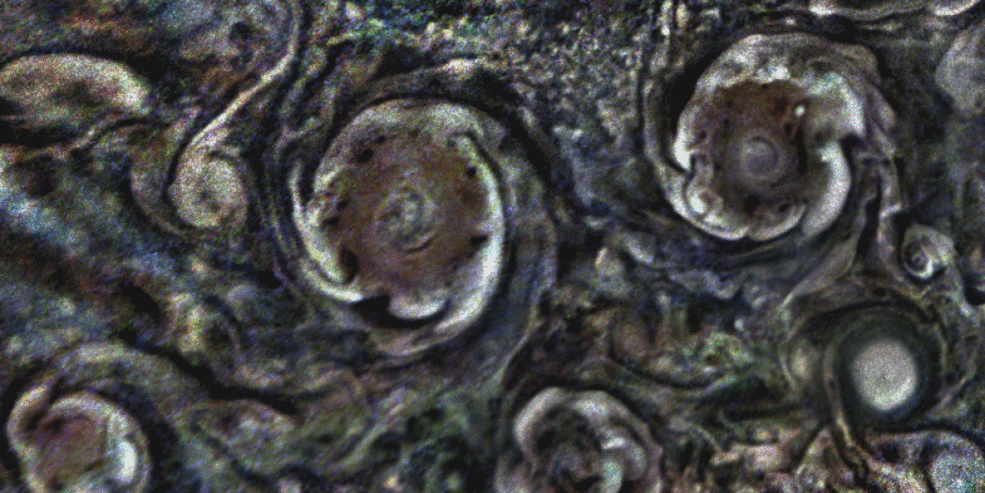
- Twenty-five years ago, NASA sent history's first probe into the atmosphere of the solar system's largest planet. But the information returned by the Galileo probe during its descent into Jupiter caused head-scratching: The atmosphere it was plunging into was much denser and hotter than scientists expected. New data from NASA's Juno spacecraft suggests that these "hot spots" are much wider and deeper than anticipated. The findings on Jupiter's hot spots, along with an update on Jupiter's polar cyclones, were revealed on Dec. 11, during a virtual media briefing at the American Geophysical Union's fall conference.
- "Giant planets have deep atmospheres without a solid or liquid base like Earth," said Scott Bolton, principal investigator of Juno at the Southwest Research Institute in San Antonio. "To better understand what is happening deep into one of these worlds, you need to look below the cloud layer. Juno, which recently completed its 29th close-up science pass of Jupiter, does just that. The spacecraft's observations are shedding light on old mysteries and posing new questions – not only about Jupiter, but about all gas giant worlds."
- The latest longstanding mystery Juno has tackled stems from 57 minutes, 36 seconds of data Galileo beamed back on Dec. 7, 1995. When the probe radioed back that its surroundings were dry and windy, surprised scientists attributed the finding to the fact that the 75-pound (34 kg) probe had descended into the atmosphere within one of Jupiter's relatively rare hot spots – localized atmospheric "deserts" that traverse the gas giant's northern equatorial region. But results from Juno's microwave instrument indicate that the entire northern equatorial belt – a broad, brown, cyclonic band that wraps around the planet just above of the gas giant's equator – is generally a very dry region.
- The implication is that the hot spots may not be isolated "deserts," but rather, windows into a vast region in Jupiter's atmosphere that may be hotter and drier than other areas. Juno's high-resolution data show that these Jovian hot spots are associated with breaks in the planet's cloud deck, providing a glimpse into Jupiter's deep atmosphere. They also show the hot spots, flanked by clouds and active storms, are fueling high-altitude electrical discharges recently discovered by Juno and known as "shallow lightning." These discharges, which occur in the cold upper reaches of Jupiter's atmosphere when ammonia mixes with water, are a piece of this puzzle.
- "High up in the atmosphere, where shallow lightning is seen, water and ammonia are combined and become invisible to Juno's microwave instrument. This is where a special kind of hailstone that we call 'mushballs' are forming," said Tristan Guillot, a Juno co-investigator at the Université Côte d'Azur in Nice, France. "These mushballs get heavy and fall deep into the atmosphere, creating a large region that is depleted of both ammonia and water. Once the mushballs melt and evaporate, the ammonia and water change back to a gaseous state and are visible to Juno again."
Jupiter Weather Report
- Last year the Juno team reported on the cyclones of the south pole. At that time, Juno's Jovian Infrared Auroral Mapper instrument captured images of a new cyclone appearing to attempt to join the five established cyclones revolving around the massive central cyclone at the south pole.
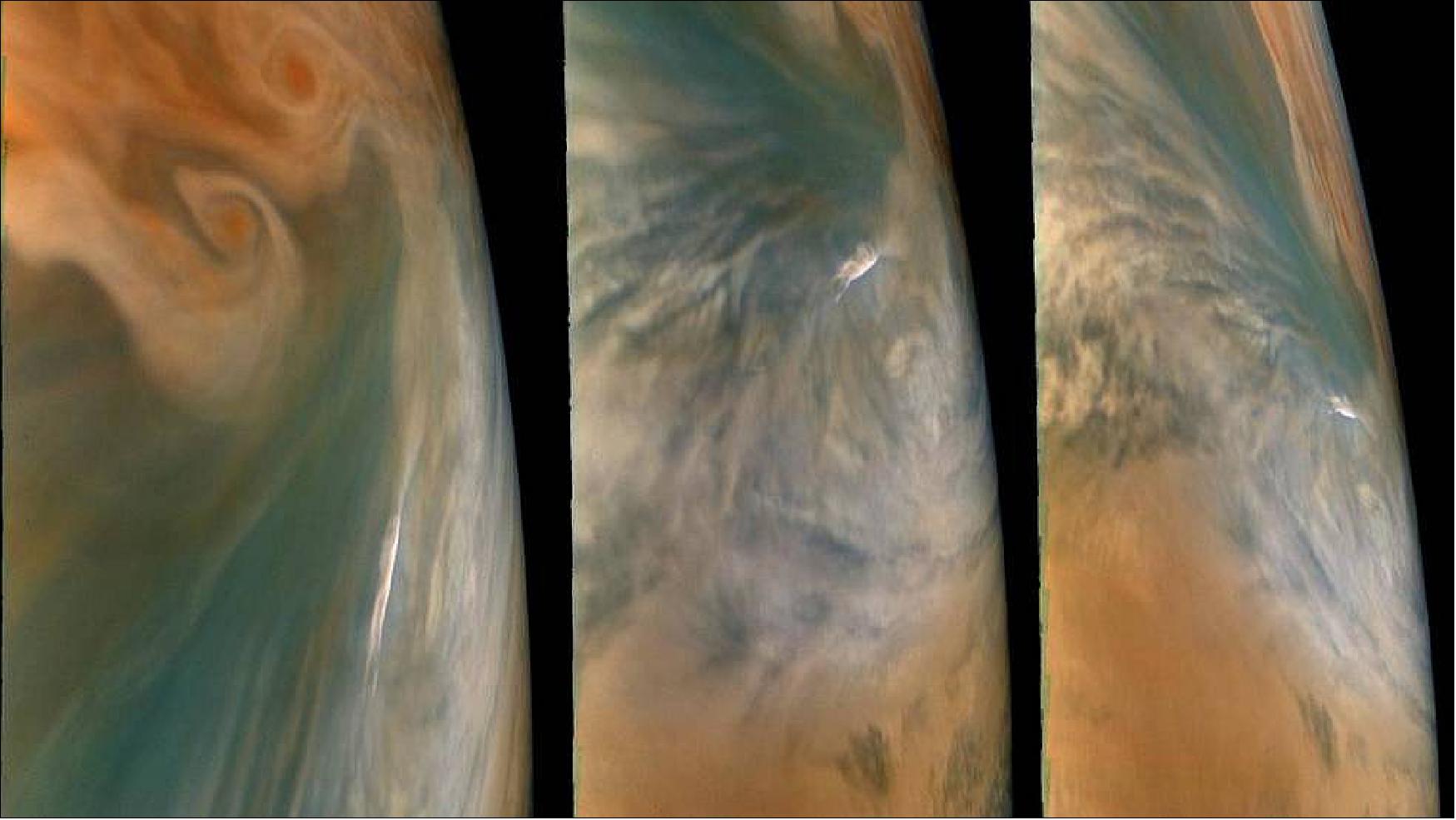
- "That sixth cyclone, the baby of the group, appeared to be changing the geometric configuration at the pole – from a pentagon to a hexagon," said Bolton. "But, alas, the attempt failed; the baby cyclone got kicked out, moved away, and eventually disappeared."
- At present, the team doesn't have an agreed-upon theory regarding how these giant polar vortices form – or why some appear stable while others are born, grow, and then die relatively quickly. Work continues on atmospheric models, but at present no one model appears to explain everything. How new storms appear, evolve, and are either accepted or rejected is key to understanding the circumpolar cyclones, which might help explain how the atmospheres of such giant planets work in general.
• July 22, 2020: On its way inbound for a Dec. 26, 2019, flyby of Jupiter, NASA's Juno spacecraft flew in the proximity of the north pole of the ninth-largest object in the solar system, the moon Ganymede. The infrared imagery collected by the spacecraft's Jovian Infrared Auroral Mapper (JIRAM) instrument provides the first infrared mapping of the massive moon's northern frontier.

- Larger than the planet Mercury, Ganymede consists primarily of water ice. Its composition contains fundamental clues for understanding the evolution of the 79 Jovian moons from the time of their formation to today.
- Ganymede is also the only moon in the solar system with its own magnetic field. On Earth, the magnetic field provides a pathway for plasma (charged particles from the Sun) to enter our atmosphere and create aurora. As Ganymede has no atmosphere to impede their progress, the surface at its poles is constantly being bombarded by plasma from Jupiter's gigantic magnetosphere. The bombardment has a dramatic effect on Ganymede's ice.
- "The JIRAM data show the ice at and surrounding Ganymede's north pole has been modified by the precipitation of plasma," said Alessandro Mura, a Juno co-investigator at the National Institute for Astrophysics in Rome. "It is a phenomenon that we have been able to learn about for the first time with Juno because we are able to see the north pole in its entirety."
- The ice near both poles of the moon is amorphous. This is because charged particles follow the moon's magnetic field lines to the poles, where they impact, wreaking havoc on the ice there, preventing it from having an ordered (or crystalline) structure. In fact, frozen water molecules detected at both poles have no appreciable order to their arrangement, and the amorphous ice has a different infrared signature than the crystalline ice found at Ganymede's equator.
- "These data are another example of the great science Juno is capable of when observing the moons of Jupiter," said Giuseppe Sindoni, program manager of the JIRAM instrument for the Italian Space Agency.
- JIRAM was designed to capture the infrared light emerging from deep inside Jupiter, probing the weather layer down to 30 to 45 miles (50 to 70 km) below Jupiter's cloud tops. But the instrument can also be used to study the moons Io, Europa, Ganymede, and Callisto (also known collectively as the Galilean moons for their discoverer, Galileo).
- Knowing the top of Ganymede would be within view of Juno on Dec. 26 flyby of Jupiter, the mission team programmed the spacecraft to turn so instruments like JIRAM could see Ganymede's surface. At the time surrounding its closest approach of Ganymede – at about 62,000 miles (100,000 km) – JIRAM collected 300 infrared images of the surface, with a spatial resolution of 14 miles (23 km) per pixel.

- The secrets of Jupiter's largest moon revealed by Juno and JIRAM will benefit the next mission to the icy world. The ESA (European Space Agency) JUICE (JUpiter ICy moons Explorer) mission is scheduled to begin a 3 1/2-year exploration of Jupiter's giant magnetosphere, turbulent atmosphere, and its icy moons Ganymede, Callisto, and Europa beginning in 2030. NASA is providing an Ultraviolet Spectrograph instrument, along with also subsystems and components for two additional instruments: the Particle Environment Package and the Radar for Icy Moon Exploration experiment.
- NASA's Jet Propulsion Laboratory, a division of Caltech in Pasadena, California, manages the Juno mission for the principal investigator, Scott Bolton, of the Southwest Research Institute in San Antonio. Juno is part of NASA's New Frontiers Program, which is managed at NASA's Marshall Space Flight Center in Huntsville, Alabama, for the agency's Science Mission Directorate in Washington. The Italian Space Agency (ASI) contributed the Jovian Infrared Auroral Mapper. Lockheed Martin Space in Denver built and operates the spacecraft.
• May 7, 2020: NASA's Hubble Space Telescope and the ground-based Gemini Observatory in Hawaii have teamed up with the Juno spacecraft to probe the mightiest storms in the solar system, taking place more than 800 million km away on the giant planet Jupiter. 19)
- A team of researchers led by Michael Wong at the University of California, Berkeley, and including Amy Simon of NASA's Goddard Space Flight Center in Greenbelt, Maryland, and Imke de Pater also of UC Berkeley, are combining multiwavelength observations from Hubble and Gemini with close-up views from Juno's orbit about the monster planet, gaining new insights into turbulent weather on this distant world.
- "We want to know how Jupiter's atmosphere works," said Wong. This is where the teamwork of Juno, Hubble and Gemini comes into play.
Radio 'Light Show'
- Jupiter's constant storms are gigantic compared to those on Earth, with thunderheads reaching 60 km from base to top — five times taller than typical thunderheads on Earth — and powerful lightning flashes up to three times more energetic than Earth's largest "superbolts."
- Like lightning on Earth, Jupiter's lightning bolts act like radio transmitters, sending out radio waves as well as visible light when they flash across the sky.
- Every 53 days, Juno races low over the storm systems detecting radio signals known as "sferics" and "whistlers," which can then be used to map lightning even on the day side of the planet or from deep clouds where flashes are not otherwise visible.
- Coinciding with each pass, Hubble and Gemini watch from afar, capturing high-resolution global views of the planet that are key to interpreting Juno's close-up observations. "Juno's microwave radiometer probes deep into the planet's atmosphere by detecting high-frequency radio waves that can penetrate through the thick cloud layers. The data from Hubble and Gemini can tell us how thick the clouds are and how deep we are seeing into the clouds," Simon explained.
- By mapping lightning flashes detected by Juno onto optical images captured of the planet by Hubble and thermal infrared images captured at the same time by Gemini, the research team has been able to show that lightning outbreaks are associated with a three-way combination of cloud structures: deep clouds made of water, large convective towers caused by upwelling of moist air — essentially Jovian thunderheads — and clear regions presumably caused by downwelling of drier air outside the convective towers.
- The Hubble data show the height of the thick clouds in the convective towers, as well as the depth of deep water clouds. The Gemini data clearly reveal the clearings in the high-level clouds where it is possible to get a glimpse down to the deep water clouds.
- Wong thinks that lightning is common in a type of turbulent area known as folded filamentary regions, which suggests that moist convection is occurring in them. "These cyclonic vortices could be internal energy smokestacks, helping release internal energy through convection," he said. "It doesn't happen everywhere, but something about these cyclones seems to facilitate convection."
- The ability to correlate lightning with deep water clouds also gives researchers another tool for estimating the amount of water in Jupiter's atmosphere, which is important for understanding how Jupiter and the other gas and ice giants formed, and therefore how the solar system as a whole formed.
- While much has been gleaned about Jupiter from previous space missions, many of the details — including how much water is in the deep atmosphere, exactly how heat flows from the interior and what causes certain colors and patterns in the clouds — remain a mystery. The combined result provides insight into the dynamics and three-dimensional structure of the atmosphere.
![Figure 31: This graphic shows observations and interpretations of cloud structures and atmospheric circulation on Jupiter from the Juno spacecraft, the Hubble Space Telescope and the Gemini Observatory. By combining the Juno, Hubble and Gemini data, researchers are able to see that lightning flashes are clustered in turbulent regions where there are deep water clouds and where moist air is rising to form tall convective towers similar to cumulonimbus clouds (thunderheads) on Earth. The bottom illustration of lightning, convective towers, deep water clouds and clearings in Jupiter's atmosphere is based on data from Juno, Hubble and Gemini, and corresponds to the transect (angled white line) indicated on the Hubble and Gemini map details. The combination of observations can be used to map the cloud structure in three dimensions and infer details of atmospheric circulation. Thick, towering clouds form where moist air is rising (upwelling and active convection). Clearings form where drier air sinks (downwelling). The clouds shown rise five times higher than similar convective towers in the relatively shallow atmosphere of Earth. The region illustrated covers a horizontal span one-third greater than that of the continental United States [image credits: NASA, ESA, M.H. Wong (UC Berkeley), A. James and M.W. Carruthers (STScI), and S. Brown (JPL)]](https://eoportal.org/ftp/satellite-missions/j/juno-21122021/Juno_Auto10.jpeg)
Seeing a 'Jack-O-Lantern' Red Spot
- With Hubble and Gemini observing Jupiter more frequently during the Juno mission, scientists are also able to study short-term changes and short-lived features like those in the Great Red Spot.
- Now, with the ability to compare visible-light images from Hubble with thermal infrared images from Gemini captured within hours of each other, it is possible to answer the question. Regions that are dark in visible light are very bright in infrared, indicating that they are, in fact, holes in the cloud layer. In cloud-free regions, heat from Jupiter's interior that is emitted in the form of infrared light — otherwise blocked by high-level clouds — is free to escape into space and therefore appears bright in Gemini images.
- "It's kind of like a jack-o-lantern," said Wong. "You see bright infrared light coming from cloud-free areas, but where there are clouds, it's really dark in the infrared."
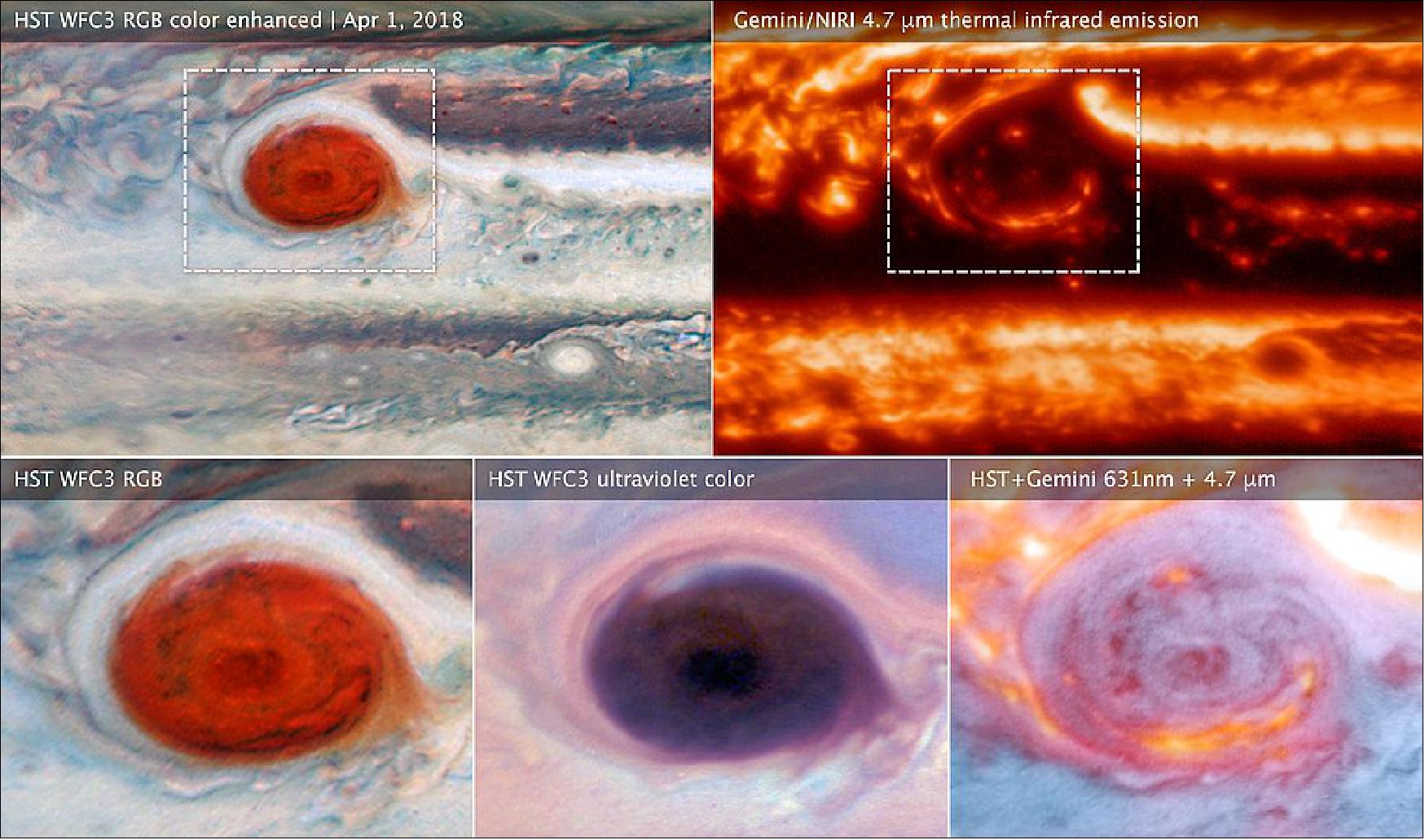
Upper left (wide view) and lower left (detail): The Hubble image of sunlight (visible wavelengths) reflecting off clouds in Jupiter's atmosphere shows dark features within the Great Red Spot.
Upper right: A thermal infrared image of the same area from Gemini shows heat emitted as infrared energy. Cool overlying clouds appear as dark regions, but clearings in the clouds allow bright infrared emission to escape from warmer layers below.
Lower middle: An ultraviolet image from Hubble shows sunlight scattered back from the hazes over the Great Red Spot. The Great Red Spot appears red in visible light because these hazes absorb blue wavelengths. The Hubble data show that the hazes continue to absorb even at shorter ultraviolet wavelengths.
Lower right: A multiwavelength composite of Hubble and Gemini data shows visible light in blue and thermal infrared in red. The combined observations show that areas that are bright in infrared are clearings or places where there is less cloud cover blocking heat from the interior.
The Hubble and Gemini observations were made to provide a wide-view context for Juno's 12th pass.
Hubble and Gemini as Jovian Weather Trackers
- The regular imaging of Jupiter by Hubble and Gemini in support of the Juno mission is proving valuable in studies of many other weather phenomena as well, including changes in wind patterns, characteristics of atmospheric waves and the circulation of various gases in the atmosphere.
- Hubble and Gemini can monitor the planet as a whole, providing real-time base maps in multiple wavelengths for reference for Juno's measurements in the same way that Earth-observing weather satellites provide context for NOAA's high-flying Hurricane Hunters.
- "Because we now routinely have these high-resolution views from a couple of different observatories and wavelengths, we are learning so much more about Jupiter's weather," explained Simon. "This is our equivalent of a weather satellite. We can finally start looking at weather cycles."
- Because the Hubble and Gemini observations are so important for interpreting Juno data, Wong and his colleagues Simon and de Pater are making all of the processed data easily accessible to other researchers through MAST (Mikulski Archives for Space Telescopes) at the Space Telescope Science Institute in Baltimore, Maryland.
- "What's important is that we've managed to collect this huge data set that supports the Juno mission. There are so many applications of the data set that we may not even anticipate. So, we're going to enable other people to do science without that barrier of having to figure out on their own how to process the data," Wong said.
- The results were published in April 2020 in The Astrophysical Journal Supplement Series. 20)
- The Hubble Space Telescope is a project of international cooperation between NASA and ESA (the European Space Agency). NASA's Goddard Space Flight Center in Greenbelt, Maryland, manages the telescope. The Space Telescope Science Institute (STScI) in Baltimore conducts Hubble science operations. STScI is operated for NASA by the Association of Universities for Research in Astronomy (AURA) in Washington, D.C. AURA operates the Gemini Observatory for the international Gemini partnership including the U.S., Canada, Chile, Argentina, Brazil and the Republic of Korea. NASA's Jet Propulsion Laboratory in Pasadena, California, manages the Juno mission for the Southwest Research Institute in San Antonio, Texas. Juno is part of NASA's New Frontiers Program, which is managed at NASA's Marshall Space Flight Center in Huntsville, Alabama, for NASA's Science Mission Directorate.
• February 18, 2020: NASA's Juno mission has provided its first science results on the amount of water in Jupiter's atmosphere. Published recently in the journal Nature Astronomy, the Juno results estimate that at the equator, water makes up about 0.25% of the molecules in Jupiter's atmosphere — almost three times that of the Sun. These are also the first findings on the gas giant's abundance of water since the agency's 1995 Galileo mission suggested Jupiter might be extremely dry compared to the Sun (the comparison is based not on liquid water but on the presence of its components, oxygen and hydrogen, present in the Sun). 21)
- An accurate estimate of the total amount of water in Jupiter's atmosphere has been on the wish lists of planetary scientists for decades: The figure in the gas giant represents a critical missing piece to the puzzle of our solar system's formation. Jupiter was likely the first planet to form, and it contains most of the gas and dust that wasn't incorporated into the Sun.
- The leading theories about its formation rest on the amount of water the planet soaked up. Water abundance also has important implications for the gas giant's meteorology (how wind currents flow on Jupiter) and internal structure. While lightning — a phenomenon typically fueled by moisture — detected on Jupiter by Voyager and other spacecraft implied the presence of water, an accurate estimate of the amount of water deep within Jupiter's atmosphere remained elusive.
- Before the Galileo probe stopped transmitting 57 minutes into its Jovian descent in December 1995, it radioed out spectrometer measurements of the amount of water in the gas giant's atmosphere down to a depth of about 75 miles (120 kilometers), where the atmospheric pressure reached about 320 pounds per square inch (22 bar). The scientists working on the data were dismayed to find ten times less water than expected.
- Even more surprising: The amount of water the Galileo probe measured appeared to be still increasing at the greatest depth measured, far below where theories suggest the atmosphere should be well mixed. In a well-mixed atmosphere, the water content is constant across the region and more likely to represent a global average; in other words, it's more likely to be representative of water planetwide. When combined with an infrared map obtained at the same time by a ground-based telescope, the results suggested the probe mission may have just been unlucky, sampling an unusually dry and warm meteorological spot on Jupiter.
- "Just when we think we have things figured out, Jupiter reminds us how much we still have to learn," said Scott Bolton, Juno principal investigator at the Southwest Research Institute in San Antonio. "Juno's surprise discovery that the atmosphere was not well mixed even well below the cloud tops is a puzzle that we are still trying to figure out. No one would have guessed that water might be so variable across the planet."
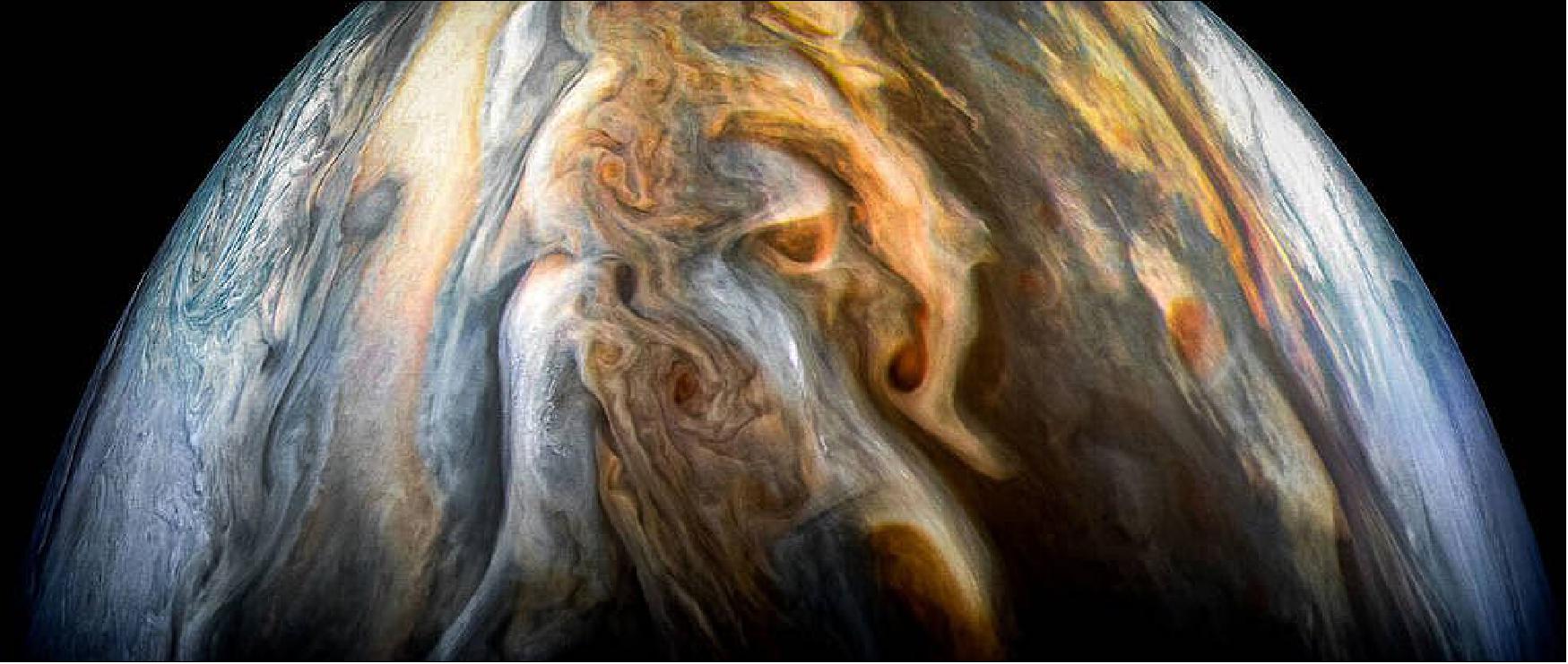
Measuring Water From Above
- A rotating, solar-powered spacecraft, Juno launched in 2011. Because of the Galileo probe experience, the mission seeks to obtain water abundance readings across large regions of the immense planet. A new kind of instrument for deep space planetary exploration, Juno's Microwave Radiometer (MWR) observes Jupiter from above using six antennas that measure atmospheric temperature at multiple depths simultaneously. The Microwave Radiometer takes advantage of the fact that water absorbs certain wavelengths of microwave radiation, the same trick used by microwave ovens to quickly heat food. The measured temperatures are used to constrain the amount of water and ammonia in the deep atmosphere, as both molecules absorb microwave radiation.
- The Juno science team used data collected during Juno's first eight science flybys of Jupiter to generate the findings. They initially concentrated on the equatorial region because the atmosphere there appears more well-mixed, even at depth, than in other regions. From its orbital perch, the radiometer was able to collect data from a far greater depth into Jupiter's atmosphere than the Galileo probe — 93 miles (150 km), where the pressure reaches about 480 psi (33 bar).
- "We found the water in the equator to be greater than what the Galileo probe measured," said Cheng Li, a Juno scientist at the University of California, Berkeley. "Because the equatorial region is very unique at Jupiter, we need to compare these results with how much water is in other regions."
Northward Bound
- Juno's 53-day orbit is slowly moving northward, as intended, bringing more of Jupiter's northern hemisphere into sharper focus with each flyby. The science team is eager to see how atmospheric water content varies by latitude and region, as well as what the cyclone-rich poles can tell them about the gas giant's global water abundance.
- Juno's 24th science flyby of Jupiter occurred on Feb 17. The next science flyby takes place on April 10, 2020.
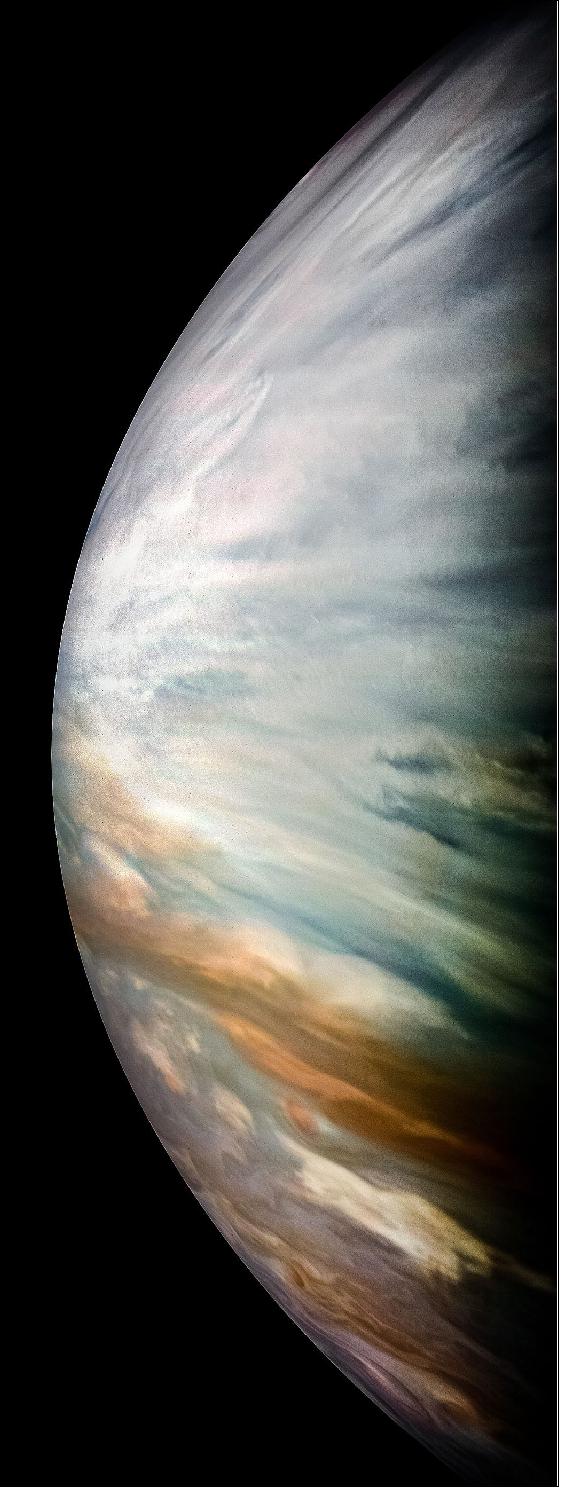
- "Every science flyby is an event of discovery," said Bolton. "With Jupiter there is always something new. Juno has taught us an important lesson: We need to get up close and personal to a planet to test our theories."
• December 12, 2019: Jupiter's south pole has a new cyclone. The discovery of the massive Jovian tempest occurred on Nov. 3, 2019, during the most recent data-gathering flyby of Jupiter by NASA's Juno spacecraft. It was the 22nd flyby during which the solar-powered spacecraft collected science data on the gas giant, soaring only 3,500 km above its cloud tops. The flyby also marked a victory for the mission team, whose innovative measures kept the solar-powered spacecraft clear of what could have been a mission-ending eclipse. 22)
- "The combination of creativity and analytical thinking has once again paid off big time for NASA," said Scott Bolton, Juno principal investigator from the Southwest Research Institute in San Antonio. "We realized that the orbit was going to carry Juno into Jupiter's shadow, which could have grave consequences because we're solar powered. No sunlight means no power, so there was real risk we might freeze to death. While the team was trying to figure out how to conserve energy and keep our core heated, the engineers came up with a completely new way out of the problem: Jump Jupiter's shadow. It was nothing less than a navigation stroke of genius. Lo and behold, first thing out of the gate on the other side, we make another fundamental discovery."
- When Juno first arrived at Jupiter in July 2016, its infrared and visible-light cameras discovered giant cyclones encircling the planet's poles — nine in the north and six in the south. Were they, like their Earthly siblings, a transient phenomenon, taking only weeks to develop and then ebb? Or could these cyclones, each nearly as wide as the continental U.S., be more permanent fixtures?
- With each flyby, the data reinforced the idea that five windstorms were swirling in a pentagonal pattern around a central storm at the south pole and that the system seemed stable. None of the six storms showed signs of yielding to allow other cyclones to join in.
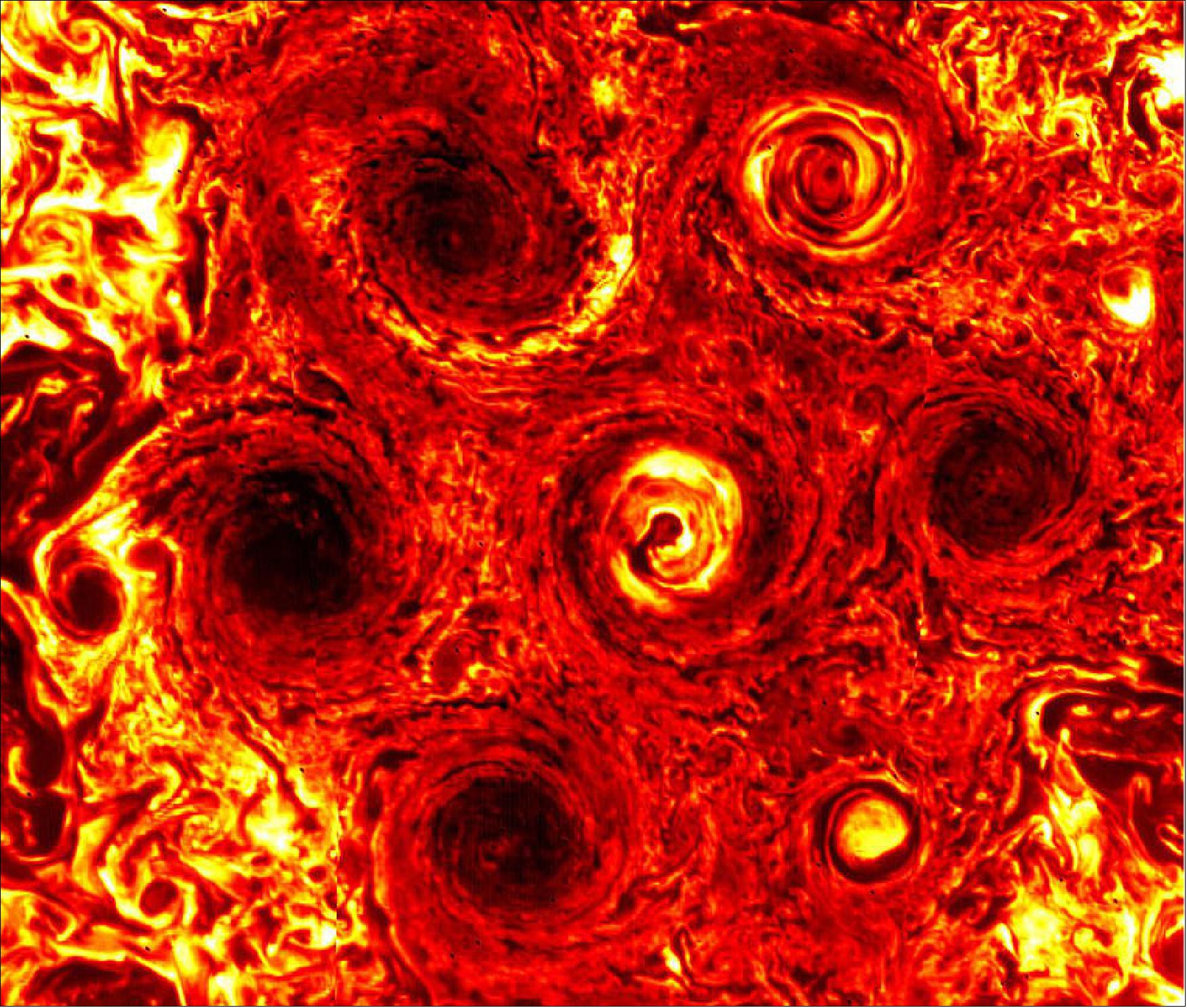
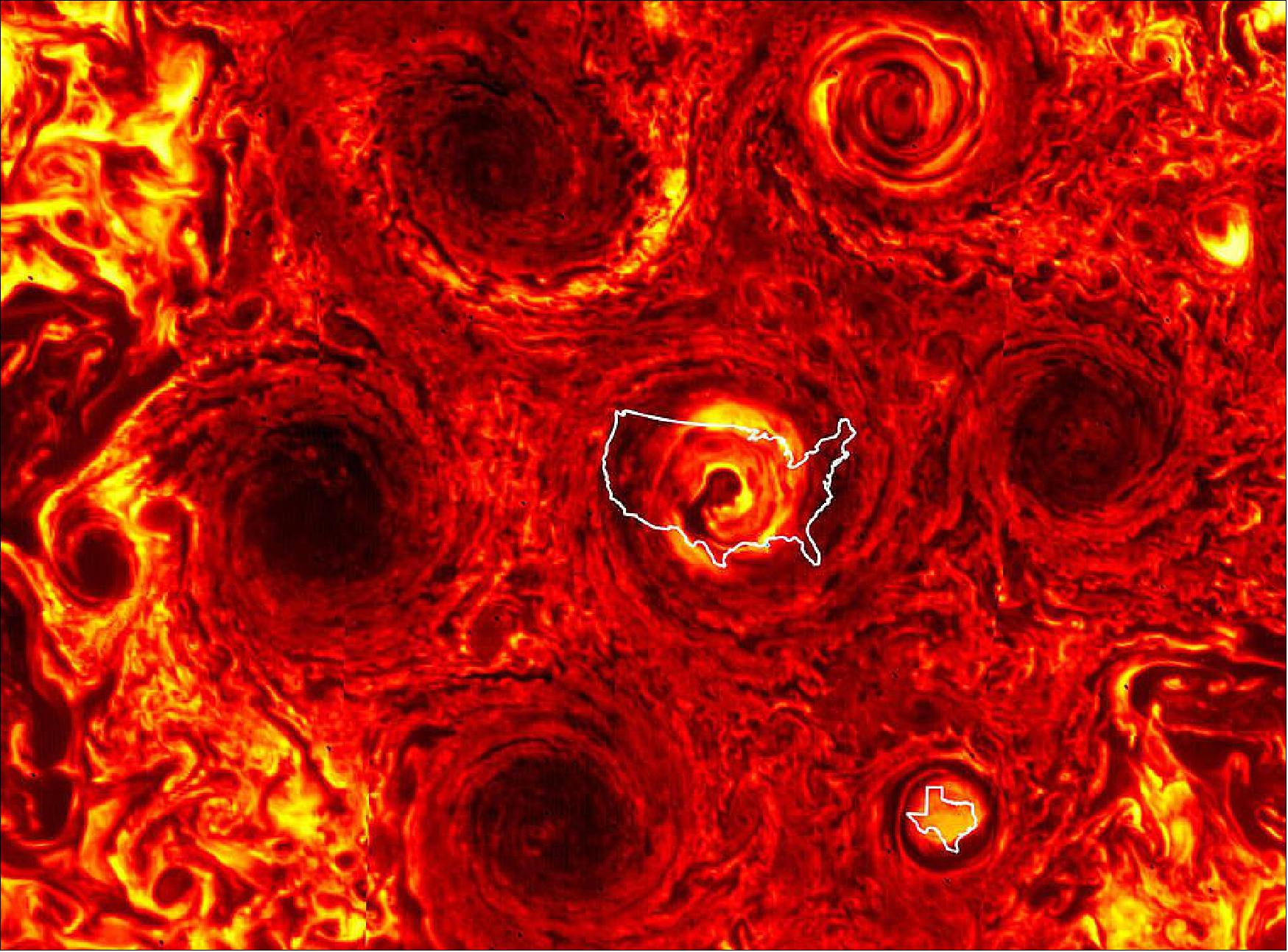
- "It almost appeared like the polar cyclones were part of a private club that seemed to resist new members," said Bolton.

- Then, during Juno's 22nd science pass, a new, smaller cyclone churned to life and joined the fray.
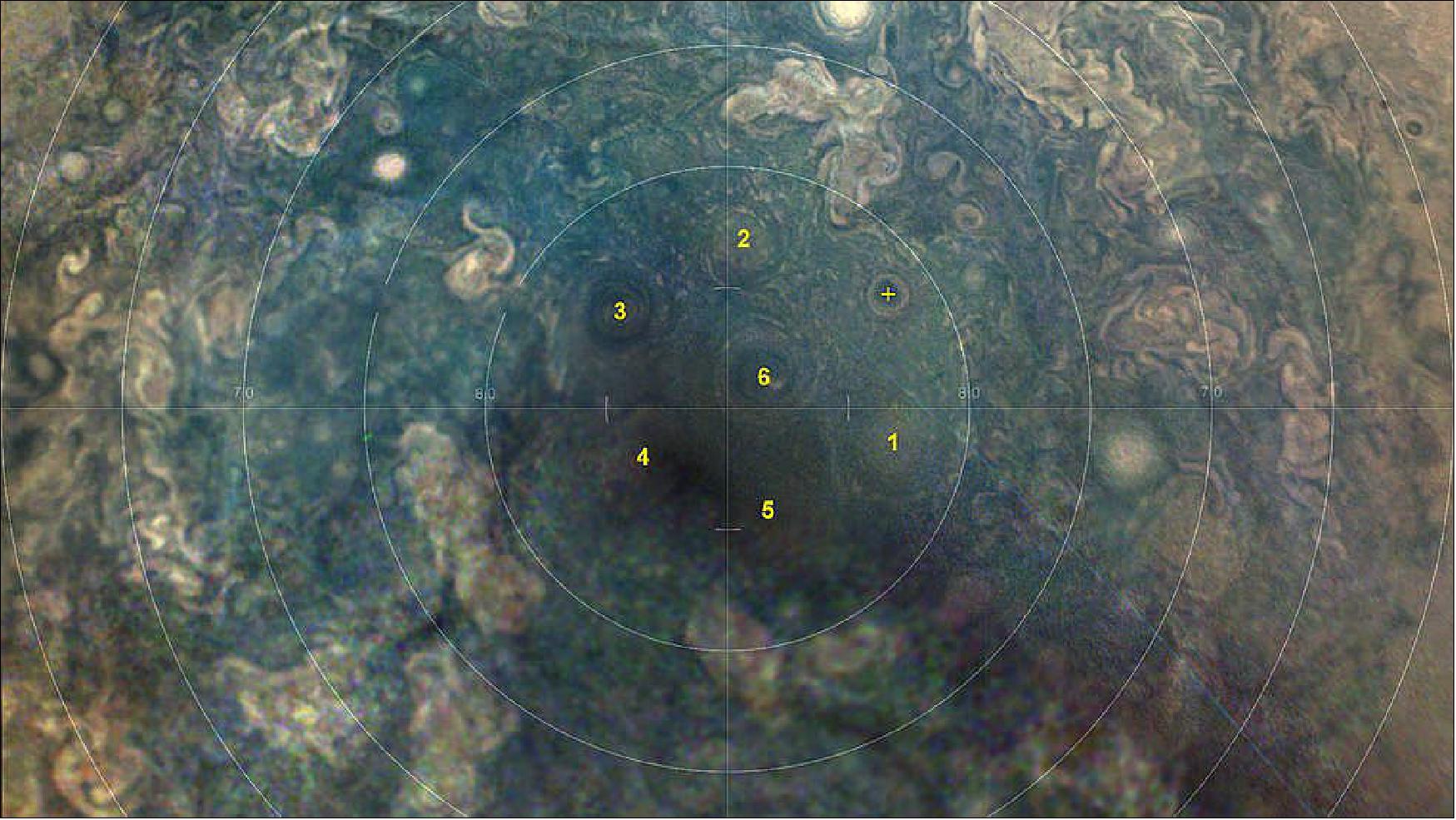
The Life of a Young Cyclone
- "Data from Juno's JIRAM (Jovian Infrared Auroral Mapper) instrument indicates we went from a pentagon of cyclones surrounding one at the center to a hexagonal arrangement," said Alessandro Mura, a Juno co-investigator at the National Institute for Astrophysics in Rome. "This new addition is smaller in stature than its six more established cyclonic brothers: It's about the size of Texas. Maybe JIRAM data from future flybys will show the cyclone growing to the same size as its neighbors."
- Probing the weather layer down to 50 to 70 km below Jupiter's cloud tops, JIRAM captures infrared light emerging from deep inside Jupiter. Its data indicate wind speeds of the new cyclone average 362 km/h — comparable to the velocity found in its six more established polar colleagues.
- The spacecraft's JunoCam also obtained visible-light imagery of the new cyclone. The two datasets shed light on atmospheric processes of not just Jupiter but also fellow gas giants Saturn, Uranus and Neptune as well as those of giant exoplanets now being discovered; they even shed light on atmospheric processes of Earth's cyclones.
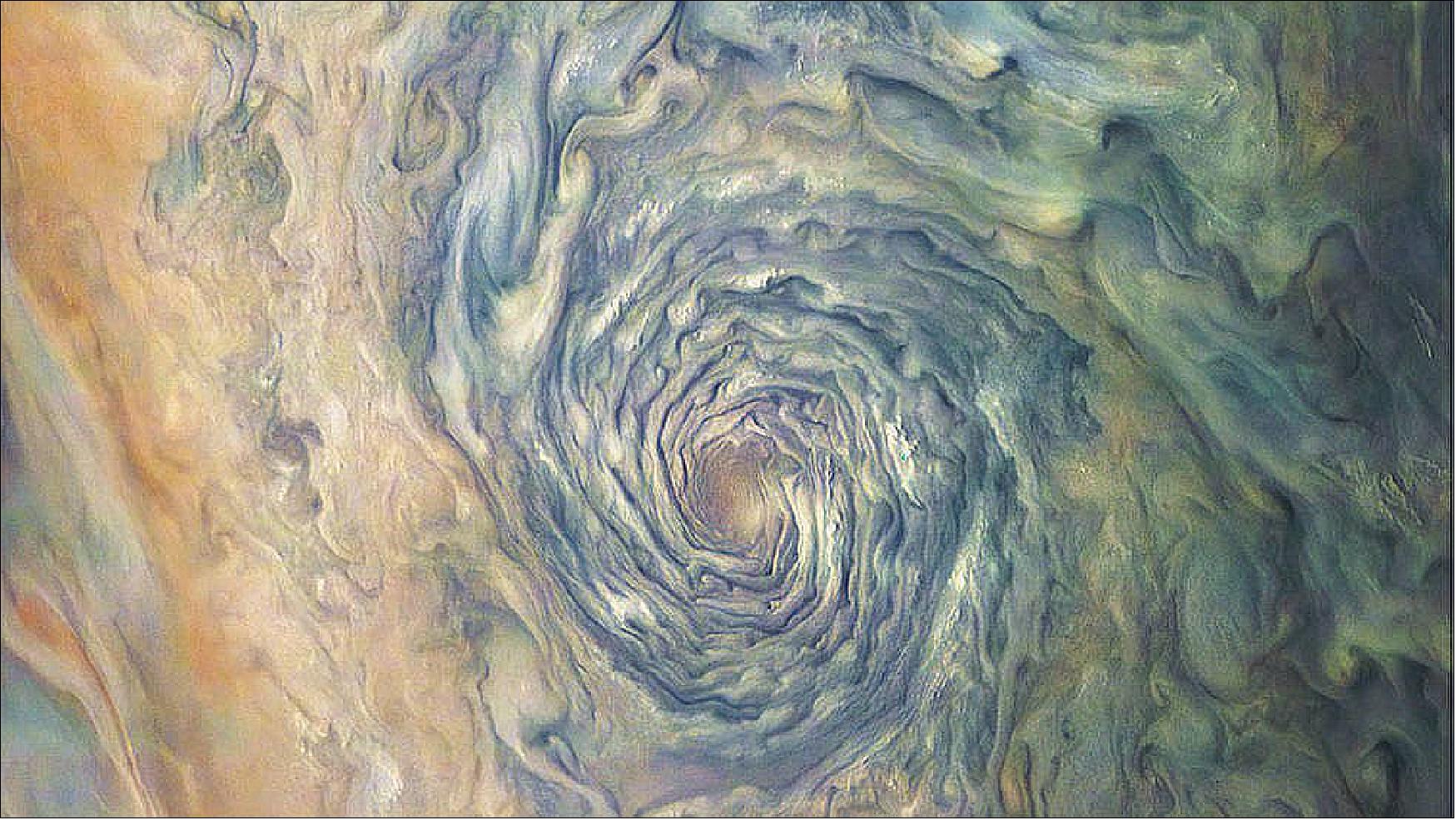
- "These cyclones are new weather phenomena that have not been seen or predicted before," said Cheng Li, a Juno scientist from the University of California, Berkeley. "Nature is revealing new physics regarding fluid motions and how giant planet atmospheres work. We are beginning to grasp it through observations and computer simulations. Future Juno flybys will help us further refine our understanding by revealing how the cyclones evolve over time."
• August 29, 2018: For centuries, scientists have worked to understand the makeup of Jupiter. It's no wonder: this mysterious planet is the biggest one in our solar system by far, and chemically, the closest relative to the Sun. Understanding Jupiter is key to learning more about how our solar system formed, and even about how other solar systems develop. 23)
- But one critical question has bedeviled astronomers for generations: Is there water deep in Jupiter's atmosphere, and if so, how much?
- Gordon L. Bjoraker, an astrophysicist at NASA's Goddard Space Flight Center in Greenbelt, Maryland, reported in a recent paper in the Astronomical Journal that he and his team have brought the Jovian research community closer to the answer. 24)
- By looking from ground-based telescopes at wavelengths sensitive to thermal radiation leaking from the depths of Jupiter's persistent storm, the Great Red Spot, they detected the chemical signatures of water above the planet's deepest clouds. The pressure of the water, the researchers concluded, combined with their measurements of another oxygen-bearing gas, carbon monoxide, imply that Jupiter has 2 to 9 times more oxygen than the Sun. This finding supports theoretical and computer-simulation models that have predicted abundant water (H2O) on Jupiter made of oxygen (O) tied up with molecular hydrogen (H2).
- The revelation was stirring given that the team's experiment could have easily failed. The Great Red Spot is full of dense clouds, which makes it hard for electromagnetic energy to escape and teach astronomers anything about the chemistry within.
- "It turns out they're not so thick that they block our ability to see deeply," said Bjoraker. "That's been a pleasant surprise."
- New spectroscopic technology and sheer curiosity gave the team a boost in peering deep inside Jupiter, which has an atmosphere thousands of miles deep, Bjoraker said: "We thought, well, let's just see what's out there."
- The data Bjoraker and his team collected will supplement the information NASA's Juno spacecraft is gathering as it circles the planet from north to south once every 53 days.
- Among other things, Juno is looking for water with its own infrared spectrometer and with a microwave radiometer that can probe deeper than anyone has seen — to 100 bars, or 100 times the atmospheric pressure at Earth's surface. (Altitude on Jupiter is measured in bars, which represent atmospheric pressure, since the planet does not have a surface, like Earth, from which to measure elevation.)
- If Juno returns similar water findings, thereby backing Bjoraker's ground-based technique, it could open a new window into solving the water problem, said Goddard's Amy Simon, a planetary atmospheres expert.
- "If it works, then maybe we can apply it elsewhere, like Saturn, Uranus or Neptune, where we don't have a Juno," she said.
- Juno is the latest spacecraft tasked with finding water, likely in gas form, on this giant gaseous planet.
- Water is a significant and abundant molecule in our solar system. It spawned life on Earth and now lubricates many of its most essential processes, including weather. It's a critical factor in Jupiter's turbulent weather, too, and in determining whether the planet has a core made of rock and ice.
- Jupiter is thought to be the first planet to have formed by siphoning the elements left over from the formation of the Sun as our star coalesced from an amorphous nebula into the fiery ball of gases we see today. A widely accepted theory until several decades ago was that Jupiter was identical in composition to the Sun; a ball of hydrogen with a hint of helium — all gas, no core.
- But evidence is mounting that Jupiter has a core, possibly 10 times Earth's mass. Spacecraft that previously visited the planet found chemical evidence that it formed a core of rock and water ice before it mixed with gases from the solar nebula to make its atmosphere. The way Jupiter's gravity tugs on Juno also supports this theory. There's even lightning and thunder on the planet, phenomena fueled by moisture.
- "The moons that orbit Jupiter are mostly water ice, so the whole neighborhood has plenty of water," said Bjoraker. "Why wouldn't the planet — which is this huge gravity well, where everything falls into it — be water rich, too?"
- The water question has stumped planetary scientists; virtually every time evidence of H2O materializes, something happens to put them off the scent. A favorite example among Jupiter experts is NASA's Galileo spacecraft, which dropped a probe into the atmosphere in 1995 that wound up in an unusually dry region. "It's like sending a probe to Earth, landing in the Mojave Desert, and concluding the Earth is dry," pointed out Bjoraker.
- In their search for water, Bjoraker and his team used radiation data collected from the summit of Maunakea in Hawaii in 2017. They relied on the most sensitive infrared telescope on Earth at the W. M. Keck Observatory, and also on a new instrument that can detect a wider range of gases at the NASA Infrared Telescope Facility.
- The idea was to analyze the light energy emitted through Jupiter's clouds in order to identify the altitudes of its cloud layers. This would help the scientists determine temperature and other conditions that influence the types of gases that can survive in those regions.
- Planetary atmosphere experts expect that there are three cloud layers on Jupiter: a lower layer made of water ice and liquid water, a middle one made of ammonia and sulfur, and an upper layer made of ammonia.
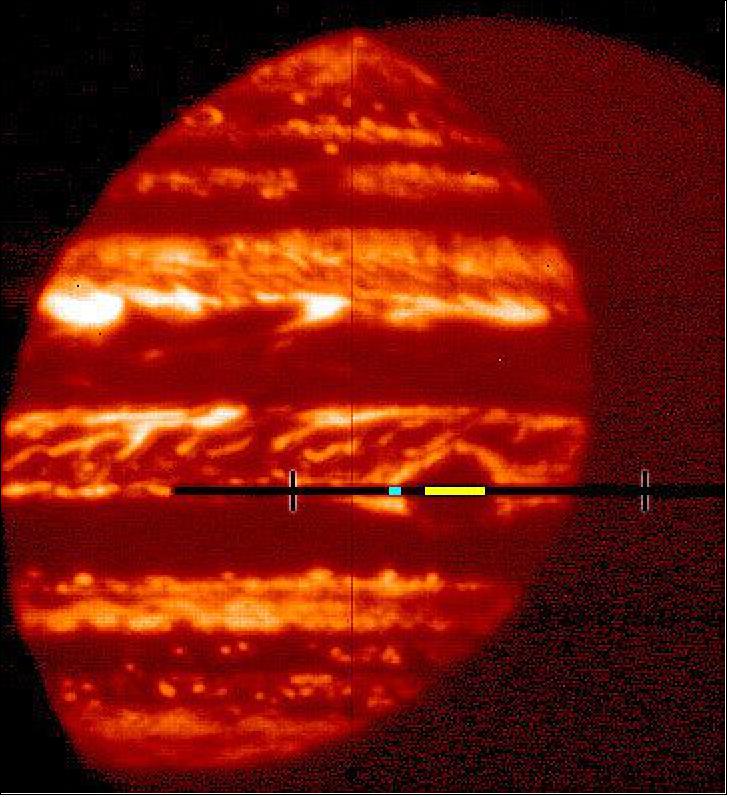
- To confirm this through ground-based observations, Bjoraker's team looked at wavelengths in the infrared range of light where most gases don't absorb heat, allowing chemical signatures to leak out. Specifically, they analyzed the absorption patterns of a form of methane gas. Because Jupiter is too warm for methane to freeze, its abundance should not change from one place to another on the planet.
- "If you see that the strength of methane lines vary from inside to outside of the Great Red Spot, it's not because there's more methane here than there," said Bjoraker, "it's because there are thicker, deep clouds that are blocking the radiation in the Great Red Spot."
- Bjoraker's team found evidence for the three cloud layers in the Great Red Spot, supporting earlier models. The deepest cloud layer is at 5 bars, the team concluded, right where the temperature reaches the freezing point for water, said Bjoraker, "so I say that we very likely found a water cloud." The location of the water cloud, plus the amount of carbon monoxide that the researchers identified on Jupiter, confirms that Jupiter is rich in oxygen and, thus, water.
- Bjoraker's technique now needs to be tested on other parts of Jupiter to get a full picture of global water abundance, and his data squared with Juno's findings.
- "Jupiter's water abundance will tell us a lot about how the giant planet formed, but only if we can figure out how much water there is in the entire planet," said Steven M. Levin, a Juno project scientist at NASA's Jet Propulsion Laboratory in Pasadena, California.
• June 6, 2018: Ever since NASA's Voyager 1 spacecraft flew past Jupiter in March, 1979, scientists have wondered about the origin of Jupiter's lightning. That encounter confirmed the existence of Jovian lightning, which had been theorized for centuries. But when the venerable explorer hurtled by, the data showed that the lightning-associated radio signals didn't match the details of the radio signals produced by lightning here at Earth. 25)
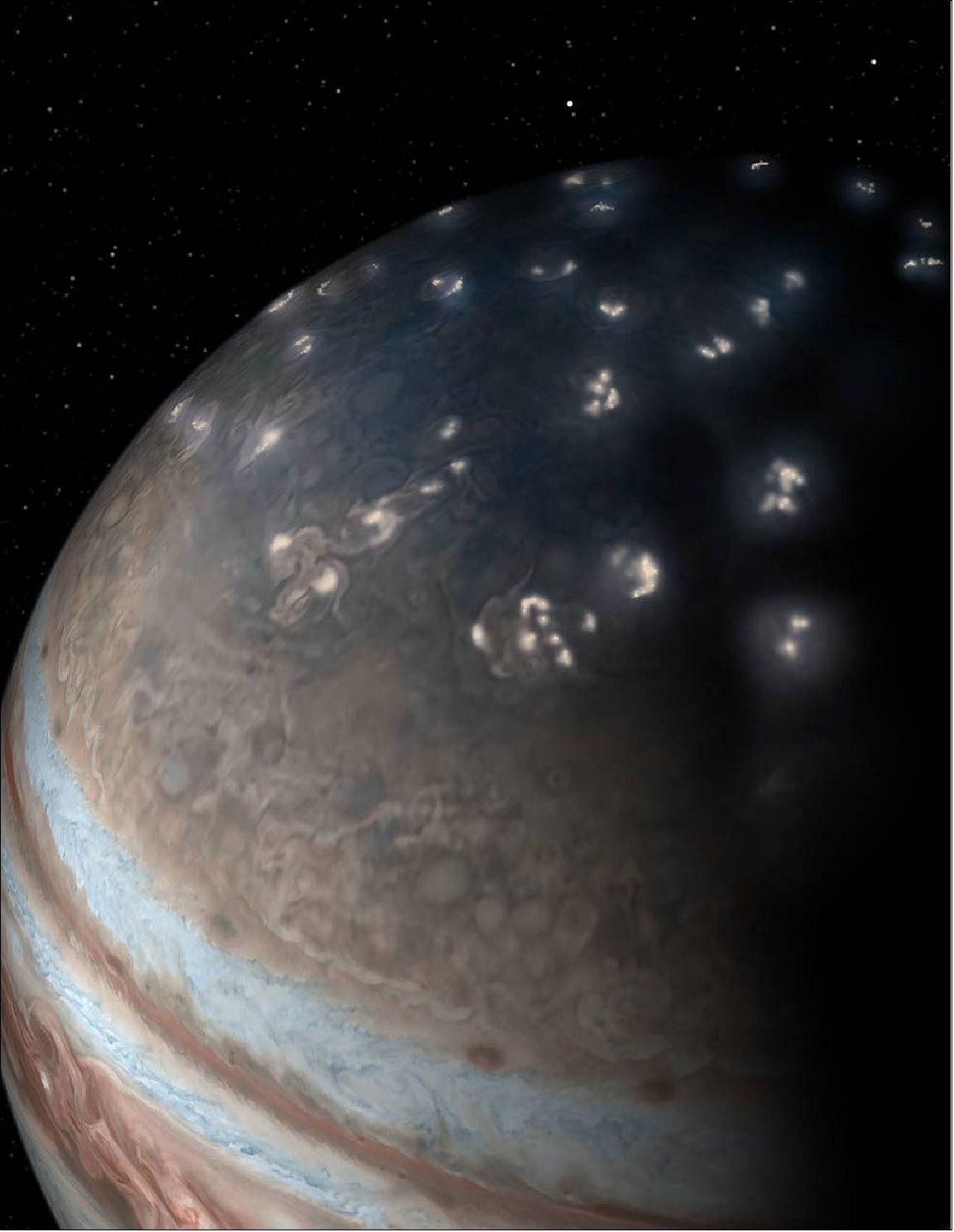
- In a new paper published in Nature today, scientists from NASA's Juno mission describe the ways in which lightning on Jupiter is actually analogous to Earth's lightning. Although, in some ways, the two types of lightning are polar opposites. 26)
- "No matter what planet you're on, lightning bolts act like radio transmitters — sending out radio waves when they flash across a sky," said Shannon Brown of NASA's Jet Propulsion Laboratory in Pasadena, California, a Juno scientist and lead author of the paper. "But until Juno, all the lightning signals recorded by spacecraft [Voyagers 1 and 2, Galileo, Cassini] were limited to either visual detections or from the kilohertz range of the radio spectrum, despite a search for signals in the megahertz range. Many theories were offered up to explain it, but no one theory could ever get traction as the answer."
- Enter Juno, which has been orbiting Jupiter since July 4, 2016. Among its suite of highly sensitive instruments is the Microwave Radiometer Instrument (MWR), which records emissions from the gas giant across a wide spectrum of frequencies.
- "In the data from our first eight flybys, Juno's MWR detected 377 lightning discharges," said Brown. "They were recorded in the megahertz as well as gigahertz range, which is what you can find with terrestrial lightning emissions. We think the reason we are the only ones who can see it is because Juno is flying closer to the lighting than ever before, and we are searching at a radio frequency that passes easily through Jupiter's ionosphere."
- While the revelation showed how Jupiter lightning is similar to Earth's, the new paper also notes that where these lightning bolts flash on each planet is actually quite different.
- "Jupiter lightning distribution is inside out relative to Earth," said Brown. "There is a lot of activity near Jupiter's poles but none near the equator. You can ask anybody who lives in the tropics — this doesn't hold true for our planet."
- Why do lightning bolts congregate near the equator on Earth and near the poles on Jupiter? Follow the heat.
- Earth's derives the vast majority of its heat externally from solar radiation, courtesy of our Sun. Because our equator bears the brunt of this sunshine, warm moist air rises (through convection) more freely there, which fuels towering thunderstorms that produce lightning.
- Jupiter's orbit is five times farther from the Sun than Earth's orbit, which means that the giant planet receives 25 times less sunlight than Earth. But even though Jupiter's atmosphere derives the majority of its heat from within the planet itself, this doesn't render the Sun's rays irrelevant. They do provide some warmth, heating up Jupiter's equator more than the poles — just as they heat up Earth. Scientists believe that this heating at Jupiter's equator is just enough to create stability in the upper atmosphere, inhibiting the rise of warm air from within. The poles, which do not have this upper-level warmth and therefore no atmospheric stability, allow warm gases from Jupiter's interior to rise, driving convection and therefore creating the ingredients for lightning.
- "These findings could help to improve our understanding of the composition, circulation and energy flows on Jupiter," said Brown. But another question looms. "Even though we see lightning near both poles, why is it mostly recorded at Jupiter's north pole?"
- In a second Juno lightning paper published today in Nature Astronomy, Ivana Kolmašová of the Czech Academy of Sciences, Prague, and colleagues, present the largest database of lightning-generated low-frequency radio emissions around Jupiter (whistlers) to date. The data set of more than 1,600 signals, collected by Juno's Waves instrument, is almost 10 times the number recorded by Voyager 1. Juno detected peak rates of four lightning strikes per second (similar to the rates observed in thunderstorms on Earth) which is six times higher than the peak values detected by Voyager 1.
- "These discoveries could only happen with Juno," said Scott Bolton, principal investigator of Juno from the Southwest Research Institute, San Antonio. "Our unique orbit allows our spacecraft to fly closer to Jupiter than any other spacecraft in history, so the signal strength of what the planet is radiating out is a thousand times stronger. Also, our microwave and plasma wave instruments are state-of-the-art, allowing us to pick out even weak lightning signals from the cacophony of radio emissions from Jupiter. "
- NASA's Juno spacecraft will make its 13th science flyby over Jupiter's mysterious cloud tops on July 16.
• March 7, 2018: Data collected by NASA's Juno mission to Jupiter indicate that the atmospheric winds of the gas-giant planet run deep into its atmosphere and last longer than similar atmospheric processes found here on Earth. The findings will improve understanding of Jupiter's interior structure, core mass and, eventually, its origin. 27)
- Other Juno science results released today include that the massive cyclones that surround Jupiter's north and south poles are enduring atmospheric features and unlike anything else encountered in our solar system. The findings are part of a four-article collection on Juno science results being published in the March 8 edition of the journal Nature. 28)
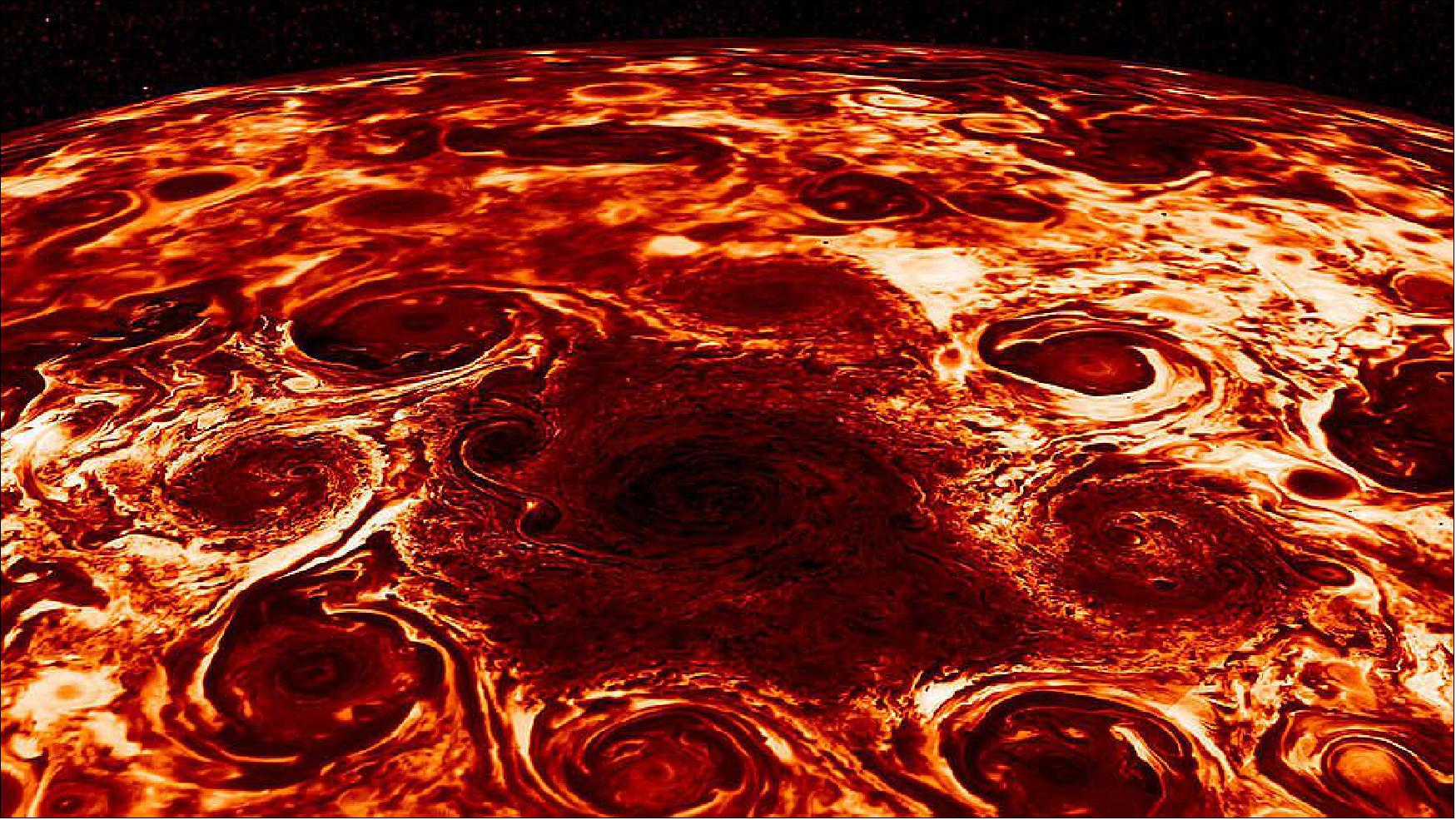
- "These astonishing science results are yet another example of Jupiter's curve balls, and a testimony to the value of exploring the unknown from a new perspective with next-generation instruments. Juno's unique orbit and evolutionary high-precision radio science and infrared technologies enabled these paradigm-shifting discoveries," said Scott Bolton, principal investigator of Juno from the Southwest Research Institute, San Antonio. "Juno is only about one third the way through its primary mission, and already we are seeing the beginnings of a new Jupiter."
- The depth to which the roots of Jupiter's famous zones and belts extend has been a mystery for decades. Gravity measurements collected by Juno during its close flybys of the planet have now provided an answer.
- "Juno's measurement of Jupiter's gravity field indicates a north-south asymmetry, similar to the asymmetry observed in its zones and belts," said Luciano Iess, Juno co-investigator from Sapienza University of Rome, and lead author on a Nature paper on Jupiter's gravity field.
- On a gas planet, such an asymmetry can only come from flows deep within the planet; and on Jupiter, the visible eastward and westward jet streams are likewise asymmetric north and south. The deeper the jets, the more mass they contain, leading to a stronger signal expressed in the gravity field. Thus, the magnitude of the asymmetry in gravity determines how deep the jet streams extend.
- "Galileo viewed the stripes on Jupiter more than 400 years ago," said Yohai Kaspi, Juno co-investigator from the Weizmann Institute of Science, Rehovot, Israel, and lead author of a Nature paper on Jupiter's deep weather layer. "Until now, we only had a superficial understanding of them and have been able to relate these stripes to cloud features along Jupiter's jets. Now, following the Juno gravity measurements, we know how deep the jets extend and what their structure is beneath the visible clouds. It's like going from a 2-D picture to a 3-D version in high definition." 29)
- The result was a surprise for the Juno science team because it indicated that the weather layer of Jupiter was more massive, extending much deeper than previously expected. The Jovian weather layer, from its very top to a depth of 3,000 km, contains about one percent of Jupiter's mass (about 3 Earth masses).
- "By contrast, Earth's atmosphere is less than one millionth of the total mass of Earth," said Kaspi "The fact that Jupiter has such a massive region rotating in separate east-west bands is definitely a surprise."
- The finding is important for understanding the nature and possible mechanisms driving these strong jet streams. In addition, the gravity signature of the jets is entangled with the gravity signal of Jupiter's core.
- Another Juno result released today suggests that beneath the weather layer, the planet rotates nearly as a rigid body. "This is really an amazing result, and future measurements by Juno will help us understand how the transition works between the weather layer and the rigid body below," said Tristan Guillot, a Juno co-investigator from the Université Côte d'Azur, Nice, France, and lead author of the paper on Jupiter's deep interior. "Juno's discovery has implications for other worlds in our solar system and beyond. Our results imply that the outer differentially-rotating region should be at least three times deeper in Saturn and shallower in massive giant planets and brown dwarf stars." 30)
- A truly striking result released in the Nature papers is the beautiful new imagery of Jupiter's poles captured by Juno's Jovian Infrared Auroral Mapper (JIRAM) instrument. Imaging in the infrared part of the spectrum, JIRAM captures images of light emerging from deep inside Jupiter equally well, night or day. JIRAM probes the weather layer down to 50 to 70 km below Jupiter's cloud tops. 31)
- "Prior to Juno we did not know what the weather was like near Jupiter's poles. Now, we have been able to observe the polar weather up-close every two months," said Alberto Adriani, Juno co-investigator from the Institute for Space Astrophysics and Planetology, Rome, and lead author of the paper. "Each one of the northern cyclones is almost as wide as the distance between Naples, Italy and New York City — and the southern ones are even larger than that. They have very violent winds, reaching, in some cases, speeds as great as 350 km/h. Finally, and perhaps most remarkably, they are very close together and enduring. There is nothing else like it that we know of in the solar system."
- Jupiter's poles are a stark contrast to the more familiar orange and white belts and zones encircling the planet at lower latitudes. Its north pole is dominated by a central cyclone surrounded by eight circumpolar cyclones with diameters ranging from 4,000 to 4,600 km across. Jupiter's south pole also contains a central cyclone, but it is surrounded by five cyclones with diameters ranging from 5,600 to 7,000 km in diameter. Almost all the polar cyclones, at both poles, are so densely packed that their spiral arms come in contact with adjacent cyclones. However, as tightly spaced as the cyclones are, they have remained distinct, with individual morphologies over the seven months of observations detailed in the paper.
- "The question is, why do they not merge?" said Adriani. "We know with Cassini data that Saturn has a single cyclonic vortex at each pole. We are beginning to realize that not all gas giants are created equal."
• September 6, 2017: Scientists on NASA's Juno mission have observed massive amounts of energy swirling over Jupiter's polar regions that contribute to the giant planet's powerful auroras – only not in ways the researchers expected. 32)
- Examining data collected by the ultraviolet spectrograph and energetic-particle detector instruments aboard the Jupiter-orbiting Juno spacecraft, a team led by Barry Mauk of the Johns Hopkins University Applied Physics Laboratory, Laurel, Maryland, observed signatures of powerful electric potentials, aligned with Jupiter's magnetic field, that accelerate electrons toward the Jovian atmosphere at energies up to 400,000 electron volts. This is 10 to 30 times higher than the largest auroral potentials observed at Earth, where only several thousands of volts are typically needed to generate the most intense auroras — known as discrete auroras — the dazzling, twisting, snake-like northern and southern lights seen in places like Alaska and Canada, northern Europe, and many other northern and southern polar regions.

- Jupiter has the most powerful auroras in the solar system, so the team was not surprised that electric potentials play a role in their generation. What's puzzling the researchers, Mauk said, is that despite the magnitudes of these potentials at Jupiter, they are observed only sometimes and are not the source of the most intense auroras, as they are at Earth.
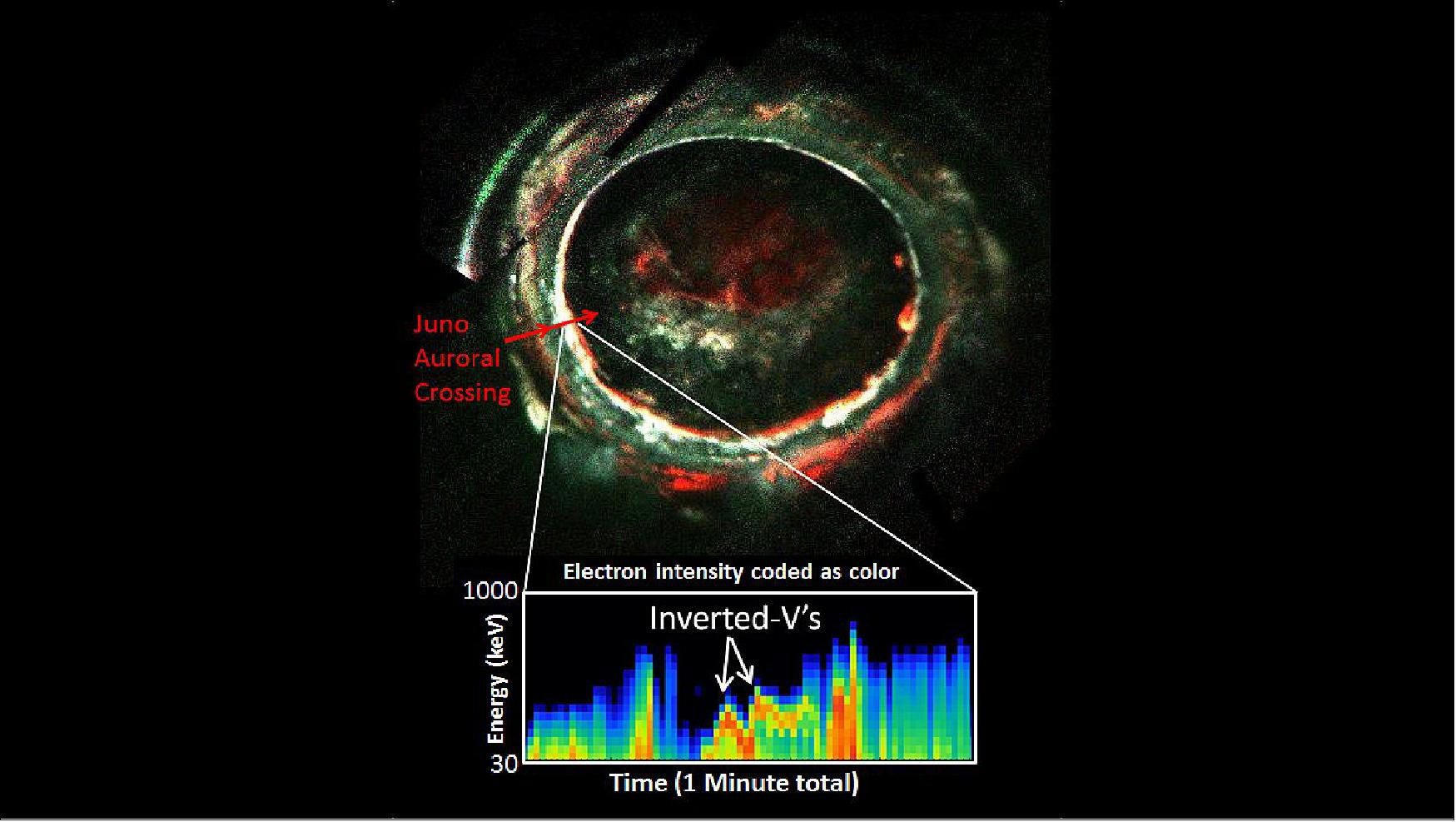
- "At Jupiter, the brightest auroras are caused by some kind of turbulent acceleration process that we do not understand very well," said Mauk, who leads the investigation team for the APL-built Jupiter Energetic Particle Detector Instrument (JEDI). "There are hints in our latest data indicating that as the power density of the auroral generation becomes stronger and stronger, the process becomes unstable and a new acceleration process takes over. But we'll have to keep looking at the data."
- Scientists consider Jupiter to be a physics lab of sorts for worlds beyond our solar system, saying the ability of Jupiter to accelerate charged particles to immense energies has implications for how more distant astrophysical systems accelerate particles. But what they learn about the forces driving Jupiter's auroras and shaping its space weather environment also has practical implications in our own planetary backyard.
- "The highest energies that we are observing within Jupiter's auroral regions are formidable. These energetic particles that create the auroras are part of the story in understanding Jupiter's radiation belts, which pose such a challenge to Juno and to upcoming spacecraft missions to Jupiter under development," said Mauk. "Engineering around the debilitating effects of radiation has always been a challenge to spacecraft engineers for missions at Earth and elsewhere in the solar system. What we learn here, and from spacecraft like NASA's Van Allen Probes and Magnetospheric Multiscale mission (MMS) that are exploring Earth's magnetosphere, will teach us a lot about space weather and protecting spacecraft and astronauts in harsh space environments. Comparing the processes at Jupiter and Earth is incredibly valuable in testing our ideas of how planetary physics works."
- Mauk and colleagues present their findings in the Sept. 7 issue of the journal Nature. 33)
• May 25, 2017: Early science results from NASA's Juno mission to Jupiter portray the largest planet in our solar system as a complex, gigantic, turbulent world, with Earth-sized polar cyclones, plunging storm systems that travel deep into the heart of the gas giant, and a mammoth, lumpy magnetic field that may indicate it was generated closer to the planet's surface than previously thought. 34)
- We are excited to share these early discoveries, which help us better understand what makes Jupiter so fascinating," said Diane Brown, Juno program executive at NASA Headquarters in Washington. "It was a long trip to get to Jupiter, but these first results already demonstrate it was well worth the journey."
- Juno launched on Aug. 5, 2011, entering Jupiter's orbit on July 4, 2016. The findings from the first data-collection pass, which flew within about 4,200 km of Jupiter's swirling cloud tops on Aug. 27, are being published this week in two papers in the journal Science, as well as 44 papers in Geophysical Research Letters. 35)
- "We knew, going in, that Jupiter would throw us some curves," said Scott Bolton, Juno principal investigator from the Southwest Research Institute in San Antonio. "But now that we are here we are finding that Jupiter can throw the heat, as well as knuckleballs and sliders. There is so much going on here that we didn't expect that we have had to take a step back and begin to rethink of this as a whole new Jupiter."
- Among the findings that challenge assumptions are those provided by Juno's imager, JunoCam. The images show both of Jupiter's poles are covered in Earth-sized swirling storms that are densely clustered and rubbing together.
- "We're puzzled as to how they could be formed, how stable the configuration is, and why Jupiter's north pole doesn't look like the south pole," said Bolton. "We're questioning whether this is a dynamic system, and are we seeing just one stage, and over the next year, we're going to watch it disappear, or is this a stable configuration and these storms are circulating around one another?"
- Another surprise comes from Juno's Microwave Radiometer (MWR), which samples the thermal microwave radiation from Jupiter's atmosphere, from the top of the ammonia clouds to deep within its atmosphere. The MWR data indicates that Jupiter's iconic belts and zones are mysterious, with the belt near the equator penetrating all the way down, while the belts and zones at other latitudes seem to evolve to other structures. The data suggest the ammonia is quite variable and continues to increase as far down as we can see with MWR, which is a few hundred kilometers.
- Prior to the Juno mission, it was known that Jupiter had the most intense magnetic field in the solar system. Measurements of the massive planet's magnetosphere, from Juno's magnetometer investigation (MAG), indicate that Jupiter's magnetic field is even stronger than models expected, and more irregular in shape. MAG data indicates the magnetic field greatly exceeded expectations at 7.766 Gauss, about 10 times stronger than the strongest magnetic field found on Earth.
- "Juno is giving us a view of the magnetic field close to Jupiter that we've never had before," said Jack Connerney, Juno deputy principal investigator and the lead for the mission's magnetic field investigation at NASA's Goddard Space Flight Center in Greenbelt, Maryland. "Already we see that the magnetic field looks lumpy: it is stronger in some places and weaker in others. This uneven distribution suggests that the field might be generated by dynamo action closer to the surface, above the layer of metallic hydrogen. Every flyby we execute gets us closer to determining where and how Jupiter's dynamo works."
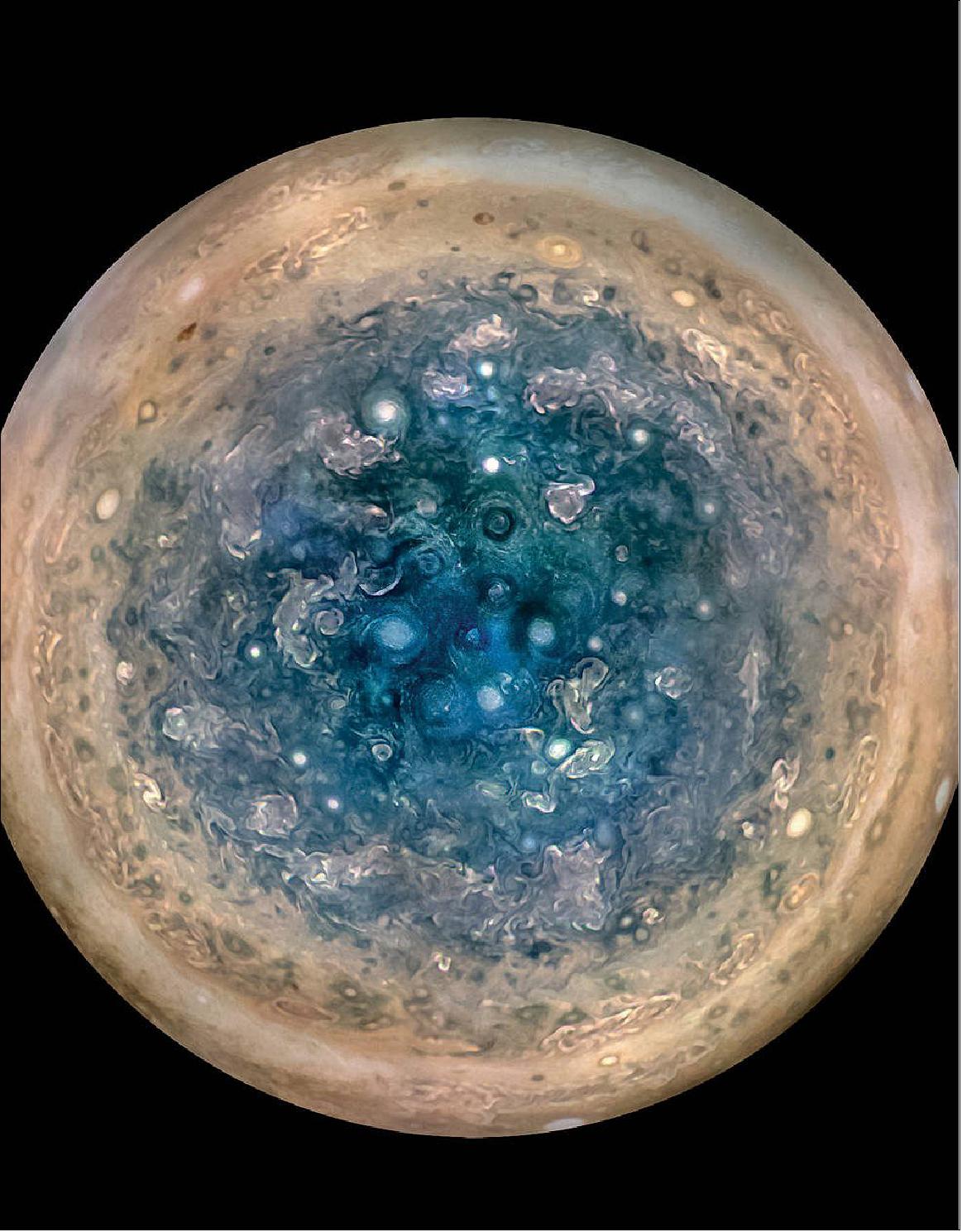
- Juno also is designed to study the polar magnetosphere and the origin of Jupiter's powerful auroras—its northern and southern lights. These auroral emissions are caused by particles that pick up energy, slamming into atmospheric molecules. Juno's initial observations indicate that the process seems to work differently at Jupiter than at Earth.
- Juno is in a polar orbit around Jupiter, and the majority of each orbit is spent well away from the gas giant. But, once every 53 days, its trajectory approaches Jupiter from above its north pole, where it begins a two-hour transit (from pole to pole) flying north to south with its eight science instruments collecting data and its JunoCam public outreach camera snapping pictures. The download of six megabytes of data collected during the transit can take 1.5 days.
- "Every 53 days, we go screaming by Jupiter, get doused by a fire hose of Jovian science, and there is always something new," said Bolton. "On our next flyby on July 11, we will fly directly over one of the most iconic features in the entire solar system — one that every school kid knows — Jupiter's Great Red Spot. If anybody is going to get to the bottom of what is going on below those mammoth swirling crimson cloud tops, it's Juno and her cloud-piercing science instruments."
• December 14, 2016: This image, taken by the JunoCam imager on NASA's Juno spacecraft, highlights the seventh of eight features forming a ‘string of pearls' on Jupiter — massive counterclockwise rotating storms that appear as white ovals in the gas giant's southern hemisphere. Since 1986, these white ovals have varied in number from six to nine. There are currently eight white ovals visible. 36)
- JunoCam is a color, visible-light camera designed to capture remarkable pictures of Jupiter's poles and cloud tops. As Juno's eyes, it will provide a wide view, helping to provide context for the spacecraft's other instruments. JunoCam was included on the spacecraft specifically for purposes of public engagement; although its images will be helpful to the science team, it is not considered one of the mission's science instruments.
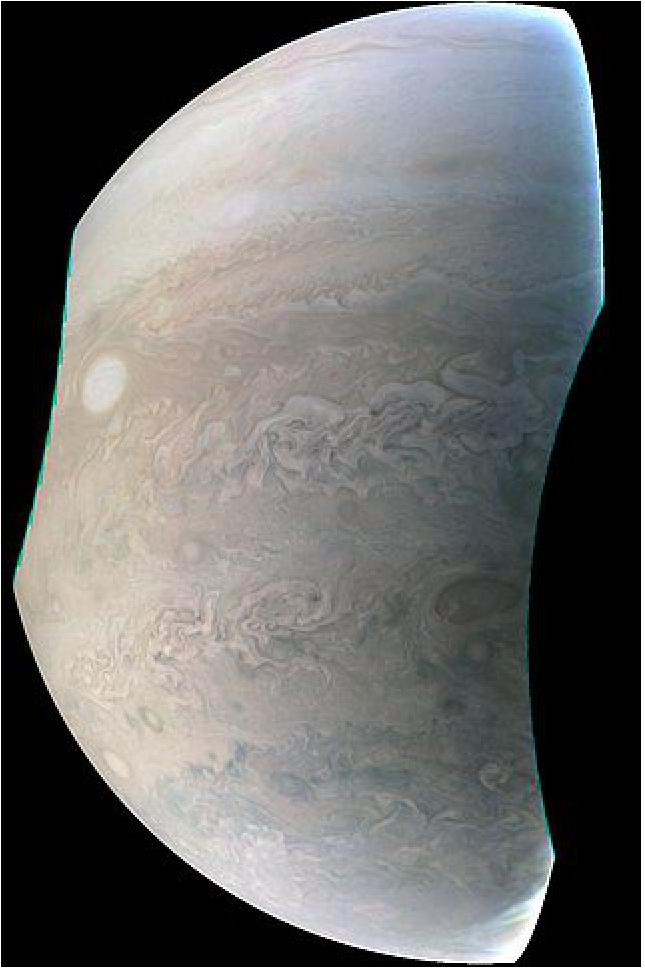
• December 9, 2016: NASA's Juno mission completed a close flyby of Jupiter on Sunday, Dec. 11, its latest science orbit of the mission. 37)
- Seven instruments and the spacecraft's JunoCam were operating during the flyby to collect data that is now being returned to Earth. Juno is currently in a 53-day orbit, and its next close flyby of Jupiter will occur on Feb. 2, 2017.
- On Sunday, Dec. 11, at 9:04 a.m. PST (12:04 p.m. EST, 17:04 UTC) NASA's Juno spacecraft will make its third flyby over Jupiter's mysterious cloud tops.
- At the time of closest approach (called perijove), Juno will be about 4,150 km above the gas giant's roiling cloud tops and traveling at a speed of about 57.8 km/s relative to the planet. Seven of Juno's eight science instruments will be on and collecting data during the flyby.
- "This will be the first time we are planning to operate the full Juno capability to investigate Jupiter's interior structure via its gravity field," said Scott Bolton, principal investigator of Juno from the Southwest Research Institute in San Antonio. "We are looking forward to what Jupiter's gravity may reveal about the gas giant's past and its future."
- Mission managers have decided not to collect data with the Jovian Infrared Auroral Mapper (JIRAM) instrument during the December flyby, to allow the team to complete an update to the spacecraft software that processes JIRAM's science data. A software patch allowing JIRAM's operation is expected to be available prior to the next perijove pass on Feb. 2, 2017.
- The spacecraft team continues to weigh its options regarding modifications of Juno's orbital period — how long it takes for the spacecraft to complete one orbit around Jupiter. At present, Juno's orbital period is 53.4 days. There had been plans to perform a period reduction maneuver with the spacecraft's main engine on Oct. 19 to reduce the orbital period to 14 days. The team made the decision to forgo the maneuver in order to further study the performance of a set of valves that are part of the spacecraft's fuel pressurization system.
- "We have a healthy spacecraft that is performing its mission admirably, and we are able to obtain great science every time we fly by," said Rick Nybakken, project manager for Juno from NASA's Jet Propulsion Laboratory in Pasadena, California. "What we do not want to do is add any unnecessary risk, so we are moving forward carefully."
• October 15, 2016: Mission managers for NASA's Juno mission to Jupiter have decided to postpone the upcoming burn of its main rocket motor originally scheduled for Oct. 19. This burn, called the period reduction maneuver (PRM), was to reduce Juno's orbital period around Jupiter from 53.4 to 14 days. The decision was made in order to further study the performance of a set of valves that are part of the spacecraft's fuel pressurization system. The period reduction maneuver was the final scheduled burn of Juno's main engine. 38)
- "Telemetry indicates that two helium check valves that play an important role in the firing of the spacecraft's main engine did not operate as expected during a command sequence that was initiated yesterday," said Rick Nybakken, Juno project manager at NASA's Jet Propulsion Laboratory in Pasadena, California. "The valves should have opened in a few seconds, but it took several minutes. We need to better understand this issue before moving forward with a burn of the main engine."
- After consulting with Lockheed Martin Space Systems of Denver and NASA Headquarters, Washington, the project decided to delay the PRM maneuver at least one orbit. The most efficient time to perform such a burn is when the spacecraft is at the part of its orbit which is closest to the planet. The next opportunity for the burn would be during its close flyby of Jupiter on Dec. 11.
- Mission designers had originally planned to limit the number of science instruments on during Juno's Oct. 19 close flyby of Jupiter. Now, with the period reduction maneuver postponed, all of the spacecraft's science instruments will be gathering data during the upcoming flyby.
- "It is important to note that the orbital period does not affect the quality of the science that takes place during one of Juno's close flybys of Jupiter," said Scott Bolton, principal investigator of Juno from the Southwest Research Institute in San Antonio. "The mission is very flexible that way. The data we collected during our first flyby on August 27th was a revelation, and I fully anticipate a similar result from Juno's October 19th flyby."
- The Juno spacecraft launched on Aug. 5, 2011, from Cape Canaveral, Florida, and arrived at Jupiter on July 4, 2016.
• July 12, 2016: The JunoCam camera aboard NASA's Juno mission is operational and sending down data after the spacecraft's July 4 arrival at Jupiter. Juno's visible-light camera was turned on six days after Juno fired its main engine and placed itself into orbit around the largest planetary inhabitant of our solar system. The first high-resolution images of the gas giant Jupiter are still a few weeks away. 39)
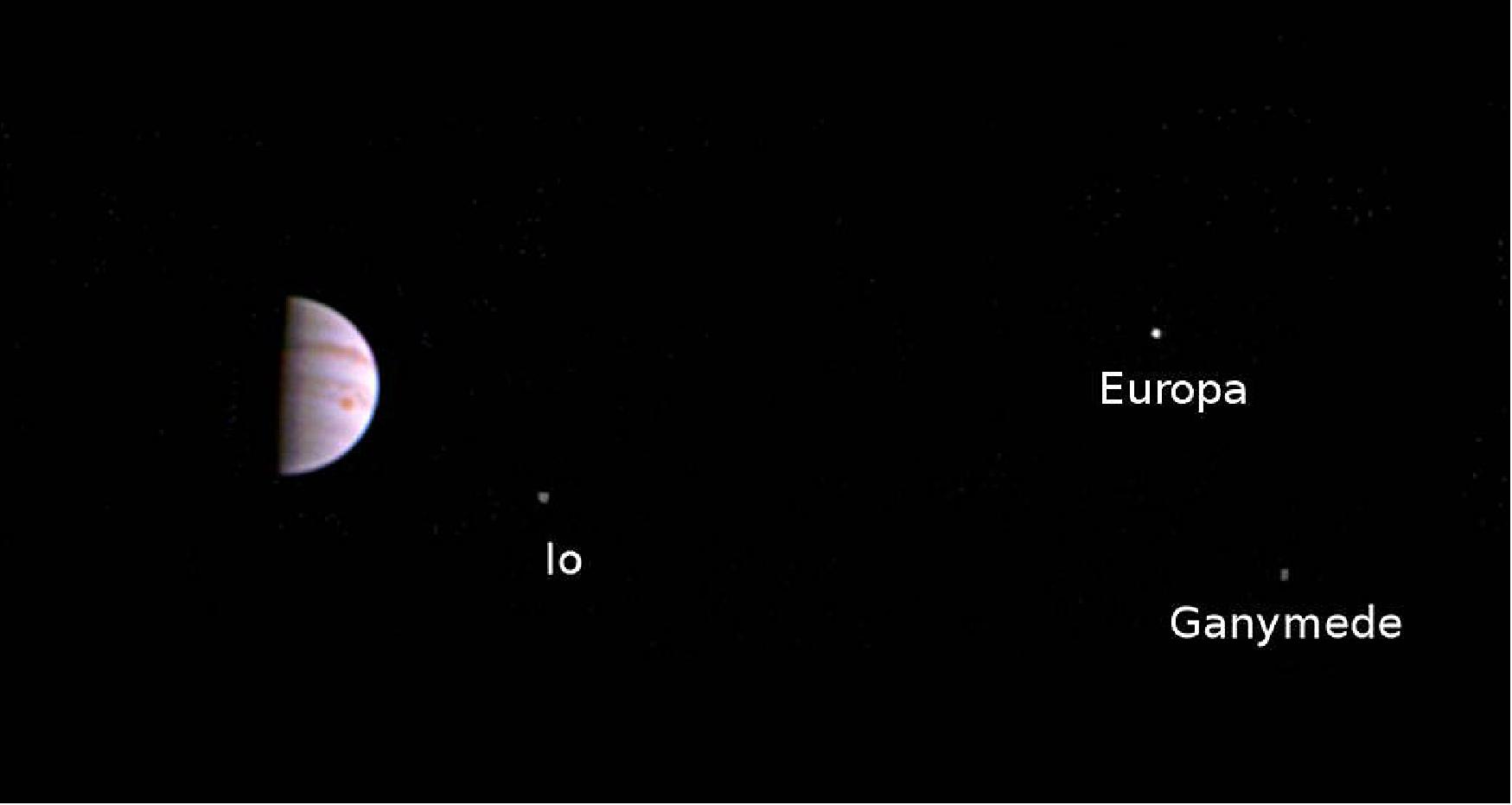
• July 5, 2016: NASA's Juno mission, launched nearly five years ago, will soon reach its final destination: the most massive planet in our solar system, Jupiter. On the evening of July 4, at roughly 9 p.m. PDT (12 a.m. EDT, July 5), the spacecraft will complete a burn of its main engine, placing it in orbit around the king of planets. 40)
- During Juno's JOI (Orbit Insertion Phase), the spacecraft will perform a series of steps in preparation for a main engine burn that will guide it into orbit. At 6:16 p.m. PDT (9:16 p.m. EDT), Juno will begin to turn slowly away from the sun and toward its orbit-insertion attitude. Then 72 minutes later, it will make a faster turn into the orbit-insertion attitude.
- At 7:41 p.m. PDT (10:41 p.m. EDT), Juno switches to its low-gain antenna. Fine-tune adjustments are then made to the spacecraft's attitude. Twenty-two minutes before the main engine burn, at 7:56 p.m. PDT (10:56 p.m. EDT), the spacecraft spins up from 2 to 5 revolutions per minute (RPM) to help stabilize it for the orbit insertion burn.
- At 8:18 p.m. PDT (11:18 p.m. EDT), Juno's 35-minute main-engine burn will begin. This will slow it enough to be captured by the giant planet's gravity. The burn will impart a mean change in velocity of 1,212 mph (542 meters a second) on the spacecraft. It is performed in view of Earth, allowing its progress to be monitored by the mission teams at NASA's Jet Propulsion Laboratory in Pasadena, California, and Lockheed Martin Space Systems in Denver, via signal reception by Deep Space Network antennas in Goldstone, California, and Canberra, Australia.
- After the main engine burn, Juno will be in orbit around Jupiter. The spacecraft will spin down from 5 to 2 RPM, turn back toward the sun, and ultimately transmit telemetry via its high-gain antenna.
- Juno starts its tour of Jupiter in a 53.5-day orbit. The spacecraft saves fuel by executing a burn that places it in a capture orbit with a 53.5-day orbit instead of going directly for the 14-day orbit that will occur during the mission's primary science collection period. The 14-day science orbit phase will begin after the final burn of the mission for Juno's main engine on 19 October 2016.
- JPL manages the Juno mission for NASA. The mission's principal investigator is Scott Bolton of Southwest Research Institute in San Antonio. The mission is part of NASA's New Frontiers Program, managed at the agency's Marshall Space Flight Center in Huntsville, Alabama, for NASA's Science Mission Directorate. Lockheed Martin Space Systems in Denver built the spacecraft.

References
1) "Juno Mission to Jupiter," NASA Facts, 2016, URL: https://d2pn8kiwq2w21t.cloudfront.net/documents/JUNO_Fact_Sheet_2016.pdf
2) "Juno Overview," NASA, URL: https://web.archive.org/web/20230528225827/https://www.nasa.gov/mission_pages/juno/overview/index.html
3) "Juno Spacecraft and Instruments," NASA,4 August 2017, URL: https://web.archive.org/web/20230812112354/https://www.nasa.gov/mission_pages/juno/spacecraft/index.html
4) Dwayne Brown, DC Agle, Maria Martinez, Gary Napier, "Juno Launch," NASA Press Kit, August 2011, URL: https://www.jpl.nasa.gov/news/press_kits/JunoLaunch.pdf
5) "Juno News Archive," NASA, URL: https://web.archive.org/web/20230316041015/https://www.nasa.gov/mission_pages/juno/news/juno-latest-news-archive.html
6) "NASA's Juno Spacecraft ‘Hears' Jupiter's Moon," NASA/JPL News, 17 December 2021, URL: https://www.jpl.nasa.gov/news/nasas-juno-spacecraft-hears-jupiters-moon?utm_source=iContact&utm_medium=email&utm_campaign=nasajpl&utm_content=weekly20211217-7
7) "NASA's Juno: Science Results Offer First 3D View of Jupiter Atmosphere," NASA/JPL Press Release 21-140, 28 October 2021, URL: https://www.jpl.nasa.gov/news/nasas-juno-science-results-offer-first-3d-view-of-jupiter-atmosphere
8) "NASA's Juno Celebrates 10 Years With New Infrared View of Moon Ganymede," NASA News, 5 August 2021, URL: https://www.jpl.nasa.gov/news/nasas-juno-celebrates-10-years-with-new-infrared-view-of-moon-ganymede
9) Bill Steigerwald, "Observatories Assemble: NASA's Juno Spacecraft Joins Japan's Hisaki Satellite and W. M. Keck Observatory to Solve "Energy Crisis" on Jupiter," NASA Feature, 4 August 2021, URL: https://www.nasa.gov/feature/goddard/2021/juno-jupiter-auroral-heating
10) J. O'Donoghue, L. Moore, T. Bhakyapaibul, H. Melin, T. Stallard, J. E. P. Connerney & C. Tao, "Global upper-atmospheric heating on Jupiter by the polar aurorae," Nature, Volume 596, pp: 54-57, Published: 4 August 2021, https://doi.org/10.1038/s41586-021-03706-w
11) Bill Steigerwald, "NASA's Juno Tunes into Jovian Radio Triggered by Jupiter's Volcanic Moon Io," NASA Feature, 15 July 2021, URL: https://www.nasa.gov/feature/goddard/2021/juno-jupiter-radio
12) "Ride With Juno As It Flies Past the Solar System's Biggest Moon and Jupiter," NASA/JPL News, 14 July 2021, URL: https://www.jpl.nasa.gov/news/ride-with-juno-as-it-flies-past-the-solar-systems-biggest-moon-and-jupiter
13) "40-Year Mystery Solved: Source of Jupiter's X-Ray Flares Uncovered," NASA Feature, 13 June 2021, URL: https://www.nasa.gov/feature/jpl/40-year-mystery-solved-source-of-jupiter-s-x-ray-flares-uncovered
14) "See the First Images NASA's Juno Took As It Sailed by Ganymede," NASA Feature, june 8, 2021, URL: https://www.nasa.gov/feature/jpl/see-the-first-images-nasa-s-juno-took-as-it-sailed-by-ganymede
15) "NASA's Juno to Get a Close Look at Jupiter's Moon Ganymede," NASA/JPL Feature, 3 June 2021, URL: https://www.nasa.gov/feature/jpl/nasa-s-juno-to-get-a-close-look-at-jupiter-s-moon-ganymede
16) "NASA's Juno Reveals Dark Origins of One of Jupiter's Grand Light Shows," NASA/JPL Feature, 16 March 2021, URL: https://www.nasa.gov/feature/jpl/nasa-s-juno-reveals-dark-origins-of-one-of-jupiter-s-grand-light-shows
17) DC Agle, Grey Hautaluoma, Alana Johnson, Deb Schmid, "NASA's Juno Mission Expands Into the Future," NASA Feature, 13 January 2021, URL: https://www.nasa.gov/feature/jpl/nasa-s-juno-mission-expands-into-the-future
18) DC Agle, Grey Hautaluoma, Alana Johnson, Deb Schmid, "NASA's Juno Spacecraft Updates Quarter-Century Jupiter Mystery," NASA Feature, 11 December 2020, URL: https://www.nasa.gov/feature/jpl/nasas-juno-spacecraft-updates-quarter-century-jupiter-mystery
19) Claire Andreoli, Margaret W. Carruthers, Ray Villard, Michael H. Wong, Amy Simon, "Telescopes and Spacecraft Join Forces to Probe Deep into Jupiter's Atmosphere," NASA Feature, 7 May 2020, URL: https://www.nasa.gov/feature/goddard/2020/telescopes-and-spacecraft-join-forces-to-probe-deep-into-jupiters-atmosphere
20) Michael H. Wong, Amy A. Simo2, Joshua W. Tollefson, Imke de Pater, Megan N. Barnett, Andrew I. Hsu, Andrew W. Stephens, Glenn S. Orton, Scott W. Fleming, Charles Goullaud, William Januszewski, Anthony Roman, Gordon L. Bjoraker, Sushil K. Atreya, Alberto Adriani, and Leigh N. Fletcher, "High-resolution UV/Optical/IR Imaging of Jupiter in 2016–2019," The Astrophysical Journal Supplement Series, Volume 247, Number 2, Published: 1 April 2020, https://doi.org/10.3847/1538-4365/ab775f, URL: https://iopscience.iop.org/article/10.3847/1538-4365/ab775f/pdf
21) DC Agle, Grey Hautaluoma, Joshua Handal,Deb Schmid, "Findings From NASA's Juno Update Jupiter Water Mystery," NASA Feature, 18 February 2020, URL: https://www.nasa.gov/feature/jpl/findings-from-nasas-juno-update-jupiter-water-mystery
22) DC Agle, Alana Johnson, Deb Schmid, "NASA's Juno Navigators Enable Jupiter Cyclone Discovery," NASA Feature, 12 December 2019, URL: : https://www.nasa.gov/feature/jpl/nasas-juno-navigators-enable-jupiter-cyclone-discovery
23) Lonnie Shektman, Karl Hille, "How a NASA Scientist Looks in the Depths of the Great Red Spot to Find Water on Jupiter," NASA Feature, 29 August 2018, URL: https://www.nasa.gov/feature/goddard/2018/how-a-nasa-scientist-looks-in-the-depths-of-the-great-red-spot-to-find-water-on-jupiter
24) G. L. Bjoraker, M. H. Wong, I. de Pater, T. Hewagama, M. Ádámkovics, and G. S. Orton, "The Gas Composition and Deep Cloud Structure of Jupiter's Great Red Spot," The Astronomical Journal, Volume 156, Nr. 3, Published: 17 August 2018, https://doi.org/10.3847/1538-3881/aad186, URL: https://iopscience.iop.org/article/10.3847/1538-3881/aad186/pdf
25) DC Agle, JoAnna Wendel, Richard Lewis, Deb. Schmid, "Juno Solves 39-Year Old Mystery of Jupiter Lightning," NASA Feature, 6 June 2018, URL: https://www.nasa.gov/feature/jpl/juno-solves-39-year-old-mystery-of-jupiter-lightning
26) Shannon Brown, Michael Janssen, Virgil Adumitroaie, Sushil Atreya, Scott Bolton, Samuel Gulkis, Andrew Ingersoll, Steven Levin, Cheng Li, Liming Li, Jonathan Lunine, Sidharth Misra, Glenn Orton, Paul Steffes, Fachreddin Tabataba-Vakili, Ivana Kolmašová, Masafumi Imai, Ondřej Santolík, William Kurth, George Hospodarsky, Donald Gurnett & John Connerney, "Prevalent lightning sferics at 600 megahertz near Jupiter's poles," Nature, Volume 558, pp: 87-90, Published: 6 June 2018, https://doi.org/10.1038/s41586-018-0156-5
27) DC Agle , Dwayne Brown, Laurie Cantillo, "NASA Juno Findings - Jupiter's Jet-Streams Are Unearthly," NASA Feature, 7 March 2021, URL: https://www.nasa.gov/feature/jpl/nasa-juno-findings-jupiter-s-jet-streams-are-unearthly
28) L. Iess, W. M. Folkner, [....] S. J. Bolton, "Measurement of Jupiter's asymmetric gravity field," Nature, Volume 555, pp: 220-222, 8 March 2018, https://doi.org/10.1038/nature25776
29) Y. Kaspi, E. Galanti, W. B. Hubbard, D. J. Stevenson, S. J. Bolton, L. Iess, T. Guillot, J. Bloxham, J. E. P. Connerney, H. Cao, D. Durante, W. M. Folkner, R. Helled, A. P. Ingersoll, S. M. Levin, J. I. Lunine, Y. Miguel, B. Militzer, M. Parisi & S. M. Wahl, "Jupiter's atmospheric jet streams extend thousands of kilometres deep," Nature, Volume 555, pp: 223-226, Published: 8 March 2018, https://doi.org/10.1038/nature25793
30) T. Guillot, Y. Miguel, B. Militzer, W. B. Hubbard, Y. Kaspi, E. Galanti, H. Cao, R. Helled, S. M. Wahl, L. Iess, W. M. Folkner, D. J. Stevenson, J. I. Lunine, D. R. Reese, A. Biekman, M. Parisi, D. Durante, J. E. P. Connerney, S. M. Levin & S. J. Bolton, "A suppression of differential rotation in Jupiter's deep interior," Nature, Volume 555, pp: 227-230, Published: 8 March 2018, https://doi.org/10.1038/nature25775
31) A. Adriani, A. Mura, [....]M. Amoroso, "Clusters of cyclones encircling Jupiter's poles," Nature, Volume 555, pp: 216-219, Published: 8 March 2018, https://doi.org/10.1038/nature25491
32) "Jupiter's Auroras Present a Powerful Mystery," NASA Feature, 6 September 2017, URL: https://www.nasa.gov/feature/jpl/jupiter-s-aurora-presents-a-powerful-mystery
33) B. H. Mauk, D. K. Haggerty, C. Paranicas, G. Clark, P. Kollmann, A. M. Rymer, S. J. Bolton, S. M. Levin, A. Adriani, F. Allegrini, F. Bagenal, B. Bonfond, J. E. P. Connerney, G. R. Gladstone, W. S. Kurth, D. J. McComas & P. Valek, "Discrete and broadband electron acceleration in Jupiter's powerful aurora," Volume 549, pp: 66-69, Published: 7 September 2017, https://doi.org/10.1038/nature23648
34) Dwayne Brown, Laurie Cantillo, DC Agle, Nancy Jones, Deb Schnid, "A Whole New Jupiter: First Science Results from NASA's Juno Mission," NASA Press Release 17-051, 25 May 2017, URL: https://www.nasa.gov/press-release/a-whole-new-jupiter-first-science-results-from-nasa-s-juno-mission
35) S. J. Bolton, A. Adriani, V. Adumitroaie, M. Allison, J. Anderson, S. Atreya, J. Bloxham, S. Brown, J. E. P. Connerney, E. DeJong, W. Folkner, D. Gautier, D. Grassi, S. Gulkis, T. Guillot, C. Hansen, W. B. Hubbard, L. Iess, A. Ingersoll, M. Janssen, J. Jorgensen, Y. Kaspi, S. M. Levin, C. Li, J. Lunine, Y. Miguel, A. Mura, G. Orton, T. Owen, M. Ravine, E. Smith, P. Steffes, E. Stone, D. Stevenson, R. Thorne, J. Waite, D. Durante, R. W. Ebert, T. K. Greathouse, V. Hue, M. Parisi, J. R. Szalay, R. Wilson, "Jupiter's interior and deep atmosphere: The initial pole-to-pole passes with the Juno spacecraft," Science, Volume 356, Issue 6340, pp: 821-825, Published: 26 May 2017, https://science.sciencemag.org/content/356/6340/821
36) DC Agle, "Juno Captures Jupiter 'Pearl'," NASA Feature, 14 December 2016, URL: https://www.nasa.gov/feature/jpl/jupiter-s-7th-pearl
37) DC Agle, Dwayne Brown, Laurie Cantillo, "NASA Juno Mission Completes Latest Jupiter Flyby," NASA Feature, 9 December 2016, URL: https://www.nasa.gov/feature/jpl/nasa-juno-mission-prepares-for-december-11-jupiter-flyby
38) DC Agle, Dwayne Brown, Laurie Cantillo, "Mission Prepares for Next Jupiter Pass," NASA Feature, 15 October 2021, URL: https://www.nasa.gov/feature/jpl/mission-prepares-for-next-jupiter-pass
39) DC Agle, Preston Dyches, Dwayne Brown, Laurie Cantillo, Martin Perez, "NASA's Juno Spacecraft Sends First In-orbit View," NASA Feature, 12 July 2016, URL: https://www.nasa.gov/feature/jpl/nasa-s-juno-spacecraft-sends-first-in-orbit-view
40) DC Agle, Whitney Clavin, "Juno Enters Orbit Around Jupiter," NASA Feature, 5 July 2016, URL: https://www.nasa.gov/feature/juno-enters-orbit-around-jupiter
The information compiled and edited in this article was provided by Herbert J. Kramer from his documentation of: "Observation of the Earth and Its Environment: Survey of Missions and Sensors" (Springer Verlag) as well as many other sources after the publication of the 4th edition in 2002. - Comments and corrections to this article are always welcome for further updates (eoportal@symbios.space).
Spacecraft Launch Sensor Complement Mission Status References Back to top